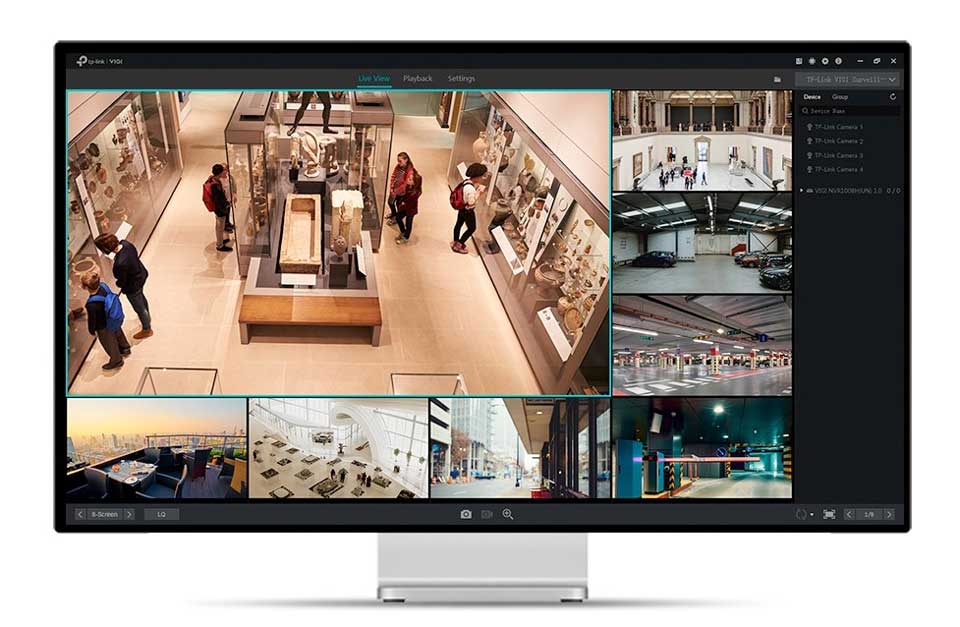VIGI Security Manager Setup Guide, This User Guide provides information for centrally managing cameras and network video recorders via VIGI Security Manager. Please read this guide carefully before operation.
Conventions
When using this guide, notice that:
- Features available in VIGI Security Manager may vary due to your region, device model, and firmware version. All images, steps, and descriptions in this guide are only examples and may not reflect your actual experience.
- The information in this document is subject to change without notice. Every effort has been made in the preparation of this document to ensure accuracy of the contents, but all statements, information, and recommendations in this document do not constitute the warranty of any kind, express or implied. Users must take full responsibility for their application of any products.
- This guide uses the specific formats to highlight special messages. The following table lists the conventions that are used throughout this guide.
| Underlined | Indicates hyperlinks. You can click to redirect to a website or a specific section. |
| Bold | Indicates contents to be emphasized and texts on the web page, including the menus, tabs, buttons and so on. |
| > | The menu structures to show the path to load the corresponding page. |
| Q) Caution | Reminds you to be cautious, and Ignoring this type of note might result in device damage or data loss. |
| Note | Indicates information that helps you make better use of your device. |
VIGI Security Manager Setup Guide
Read More :
- Gamut Surveillance Client Guide
- Comfast Long Range WiFi Access Point Setup
- How to Setup Email Notifications via Gmail
More Information
- For technical support, the latest version of the User Guide and other information, please visit https://www.tp-link.com/support.
- To ask questions, find answers, and communicate with TP-Link users or engineers, please visit https://community.tp-link.com to join TP-Link Community.
Get Started with VIGI Security Manager
This chapter guides you on how to install VIGI Security Manager and choose the network topology based on your needs. VIGI Security Manager offers easy and efficient management for security cameras and VIGI Network Video Recorder. This chapter includes the following sections:
Determine the Network Topology
Chapter 1
Get Started with VIGI Security Manager
With a reliable network management platform powered by VIGI Security Manager, you can watch the live view and playback, add devices, configure events, set recording and storage schedule for cameras, and export recordings to your computer.
V 1. 1 Install VIGI Security Manager
VIGI Security Manager is provided only for Windows operating systems. Make sure your PC’s system meet the following requirements, then properly install the VIGI Security Manager.
Operating System: WinXP/Win7/Win8/Win8.1/Win10. (We recommend that you deploy VIGI Security Manager on a 64-bit operating system to guarantee the software stability.)
Download the installation file of VIGI Security Manager from the website. Then follow the instructions to properly install the VIGI Security Manager. After a successful installation, a shortcut icon of the VIGI Security Manager will be created on your desktop.
2
Chapter 1
Get Started with VIGI Security Manager
V 1.2 Determine the Network Topology
The network topology that you create for VIGI Security Manager varies depending on your requirements.
The following figures show two typical application scenarios.
■ Use VIGI Security Manager in Local Network

Internet
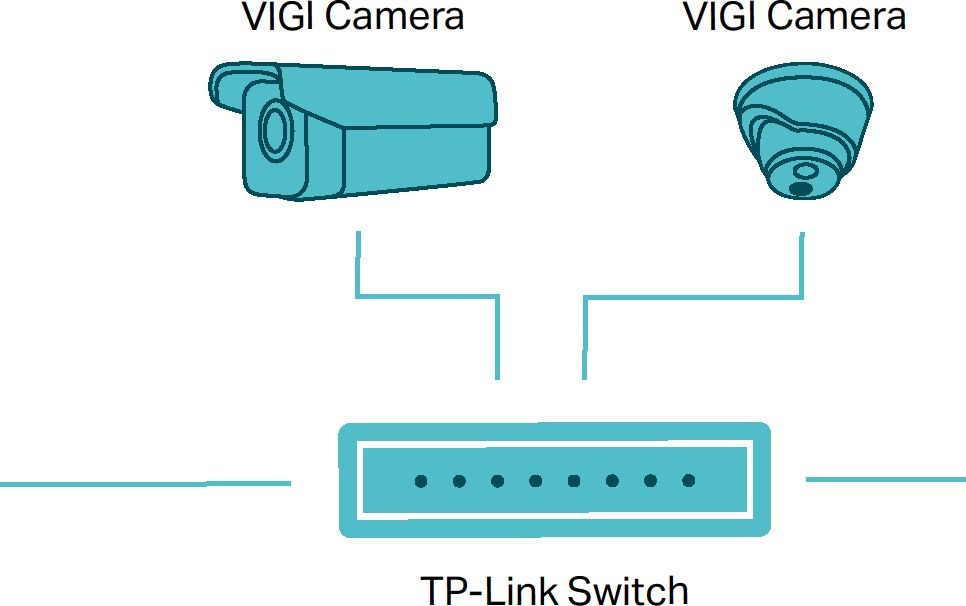
VIGI Network Video Recorder
CI-

VIĞI Security Manager
When the computer is in the same subnet as your cameras and VIGI Network Video Recorder, download and install VIGI Security Manager on your computer to watch the live view and playback, add devices from the discovered list, manage devices, set recording and storage schedule for cameras and export recordings to your computer.
3
Chapter 1
Get Started with VIGI Security Manager
■ Use VIGI Security Manager Remotely
VIGI Camera
VIGI Camera
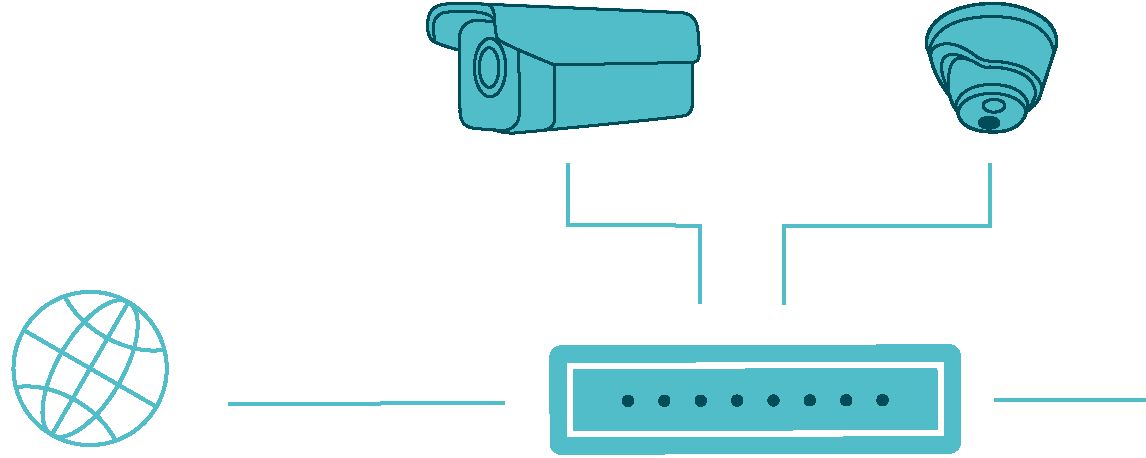
Internet TP-Link Switch
VIGI Network Video Recorder
CI

VIĞI Security Manager
If you want to monitor your home or office while away, you can download and install VIGI Security Manager on a computer connected to the internet, then log in to your TP-Link ID. With the cameras or the VIGI network video recorder bound to your TP-Link ID, you can watch the live view and playback.
4
(2)
Add Devices to VIGI Security Manager
This chapter guides you on how to add cameras and VIGI NVRs to VIGI Security Manager. You can add cameras and VIGI NVRs locally and remotely based on your needs. This chapter includes the following sections:
Chapter 2
Add Devices to VIGI Security Manager
V 2. 1 Add Devices in Local Network
To add NVRs and cameras locally, ensure that your devices should be in the same subnet as your computer.
2. 1. 1 Add Devices to VIGI Security Manager When TP-Link ID isn’t Logged in
Choose one of the methods below (Add Devices Singly, Add Devices in Batches, Add Devices Manually) and follow the steps to add your devices.
1. Go to Settings > Device List > Discovered Devices and click 4 in the list.
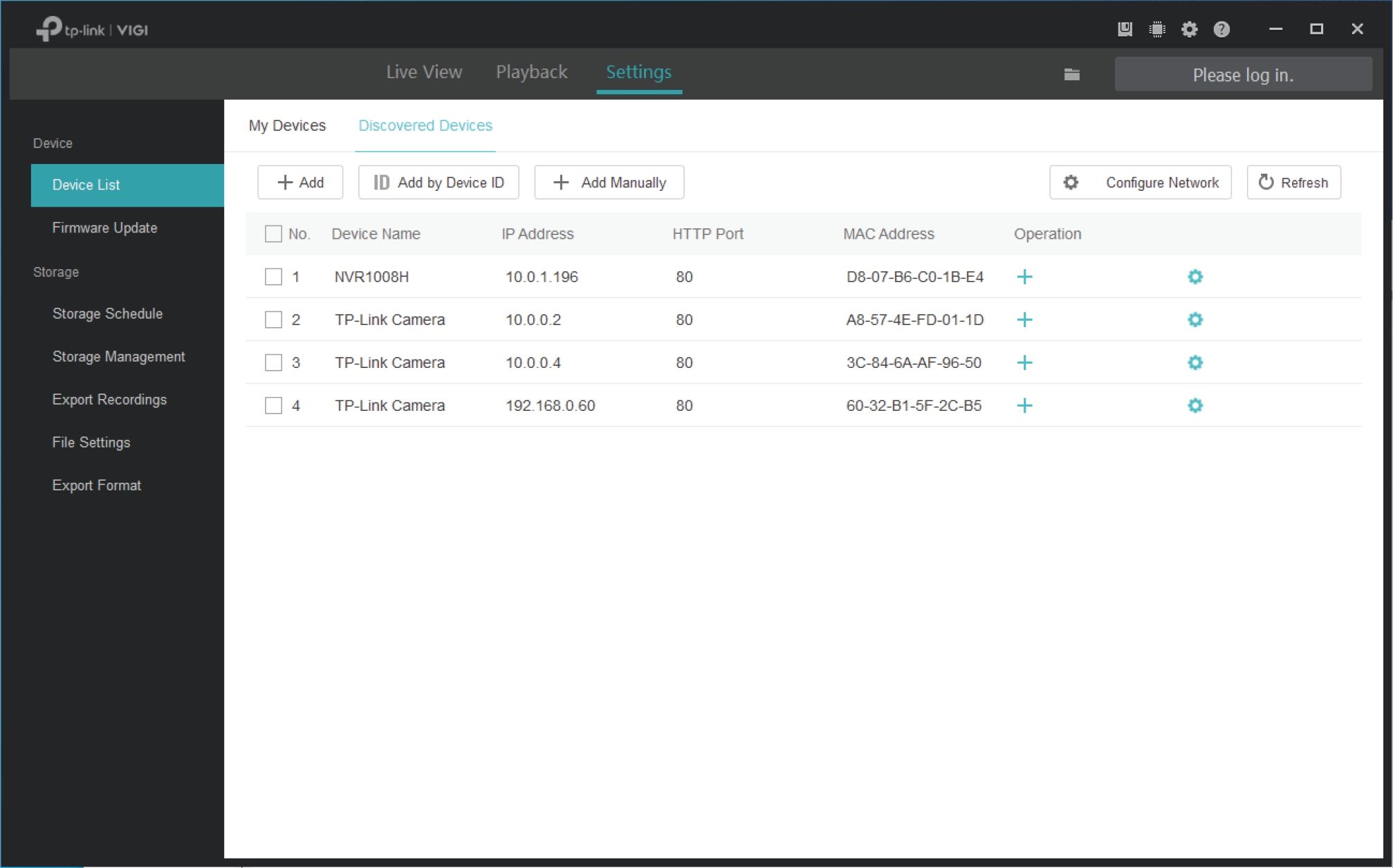
0 Configure Network
Set the IP address, gateway and subnet mask of your device.
Ö Refresh
Click Ö Refresh to refresh the device list.
6
Chapter 2
Add Devices to VIGI Security Manager
- Enter the password of your device. VIGI Security Manager can automatically detect the IP address and port number of the device, and you can keep them as default. Click Verify.
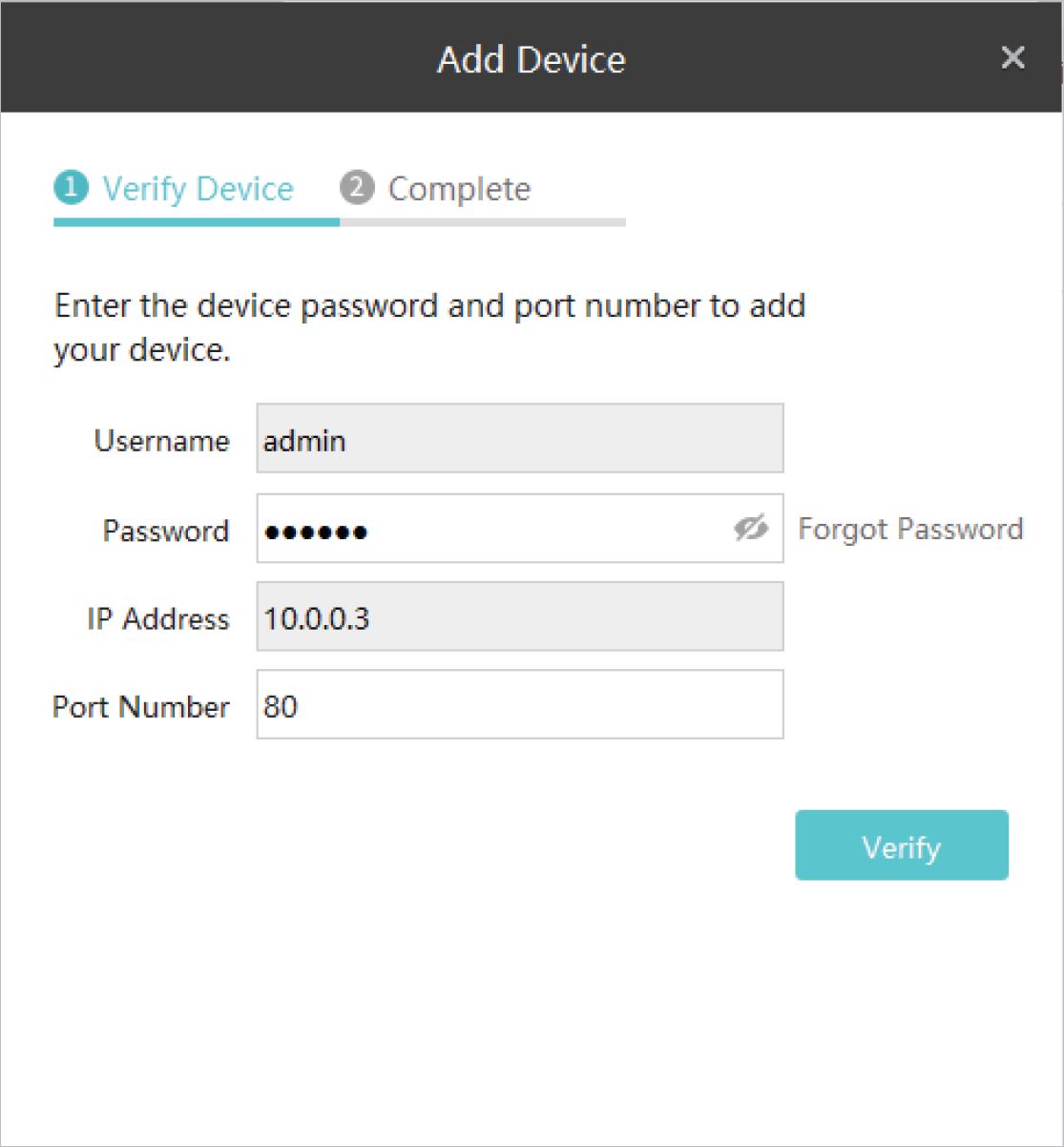
Note:
For the camera with no password, you need to set a password and a password reset email to enhance the security before adding it.
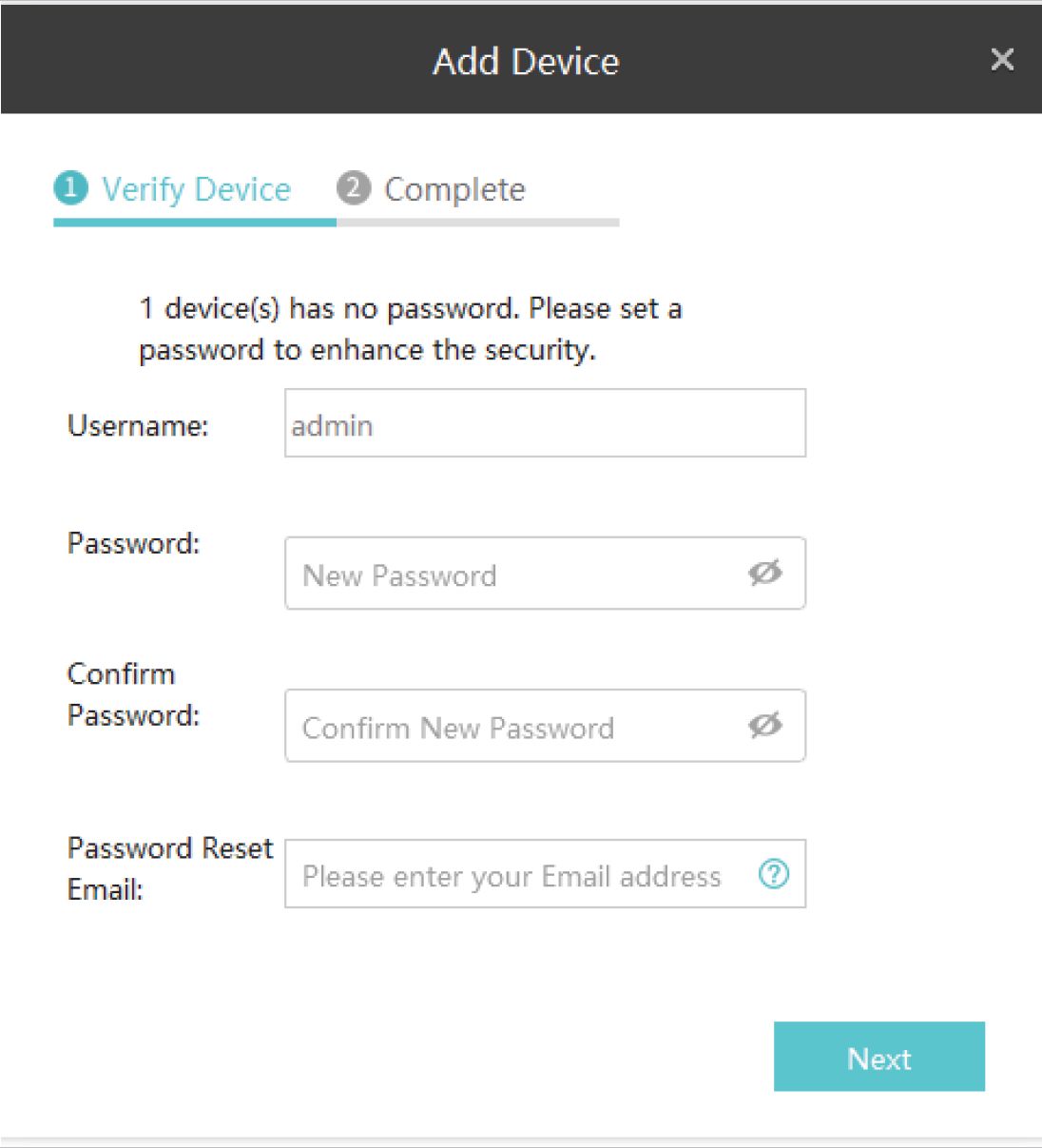
7
Chapter 2
Add Devices to VIGI Security Manager
Username
Password
Displays the username of the camera.
Set the password of the camera.
Confirm Password Confirm the password of the camera.
Password Reset Set the email address for resetting the camera’s password.
• For the NVR that has not been used, create a login password on NVR itself and set it up first before adding it.
- (Only for cameras) If you don’t want to save the recordings of your camera to your computer, directly click Confirm.
O Verify Device 0 Set Recordings O Complete
Enable Record on Computer to save the recordings to the computer.
Record on Computer O Enable
8
Chapter 2
Add Devices to VIGI Security Manager
If you want to save the recordings of your camera to your computer, you can click the checkbox of Enable Record on Computer. Configure the following parameters and click Confirm.
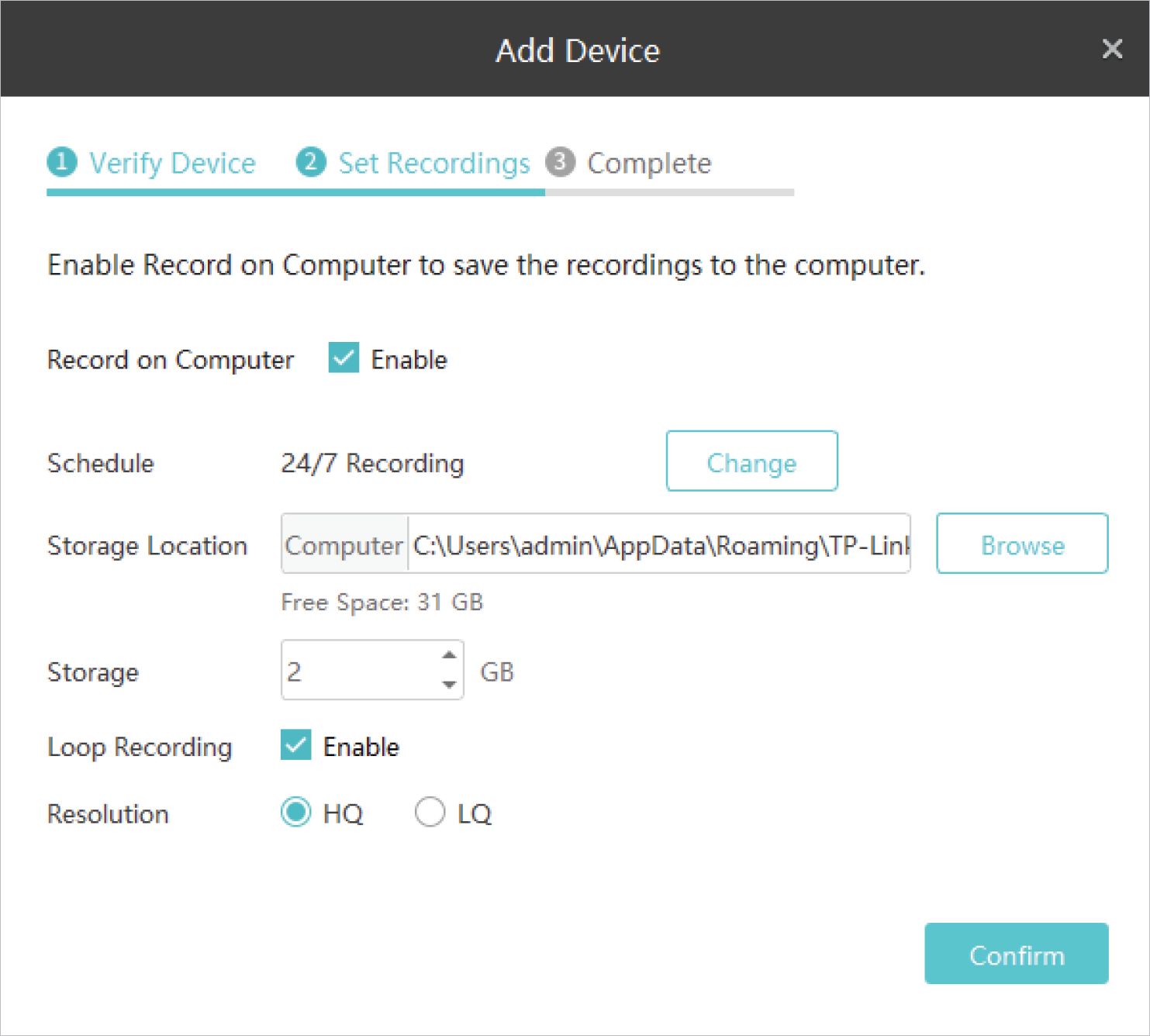
| Schedule | Click 1 Change 1 to customize the recording schedule of the camera on computer. It determines the time period for camera recording. |
| Storage Location | Click Browse to select the storage location of files. |
| Storage | Set the storage space for storing the recordings on your computer. The storage space you set should be less than the free space on your computer. |
| Loop Recording | Click the checkbox to enable loop recording. It allows your camera to overwrite old files with new files. |
| Resolution | Select the recording resolution. HQ and LQ refers to the high and low recording resolution respectively. |
9
Chapter 2
Add Devices to VIGI Security Manager
4.
Wait for the device to be added, then click OK.
■
1.
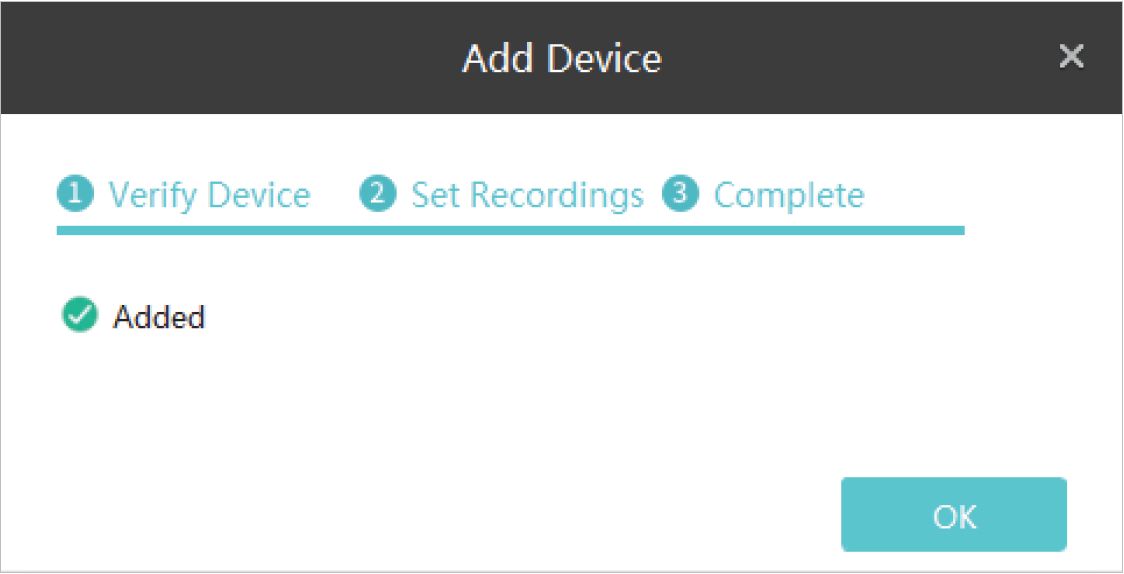
Go to Settings > Device List > Discovered Devices, select the devices you want and click

□ X
■îtp-link I VIGI
Device
Device List
Firmware Update
Storage
Storage Schedule
Storage Management
Export Recordings
File Settings
Export Format
o o
ISJ
Please log in.
Live View Playback Settings
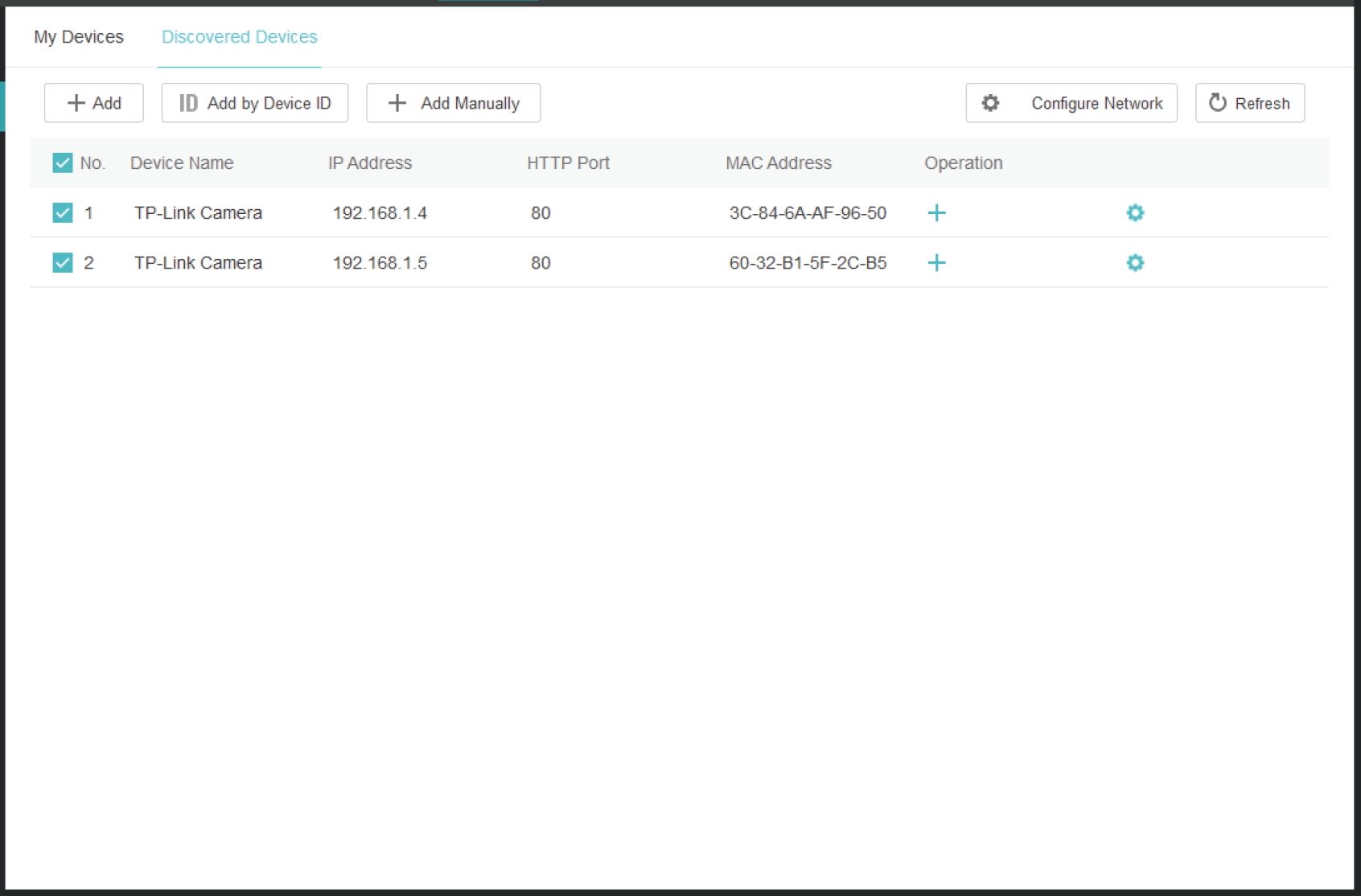
10
Chapter 2
Add Devices to VIGI Security Manager
2.
Enter the password of your devices. Click Continue.
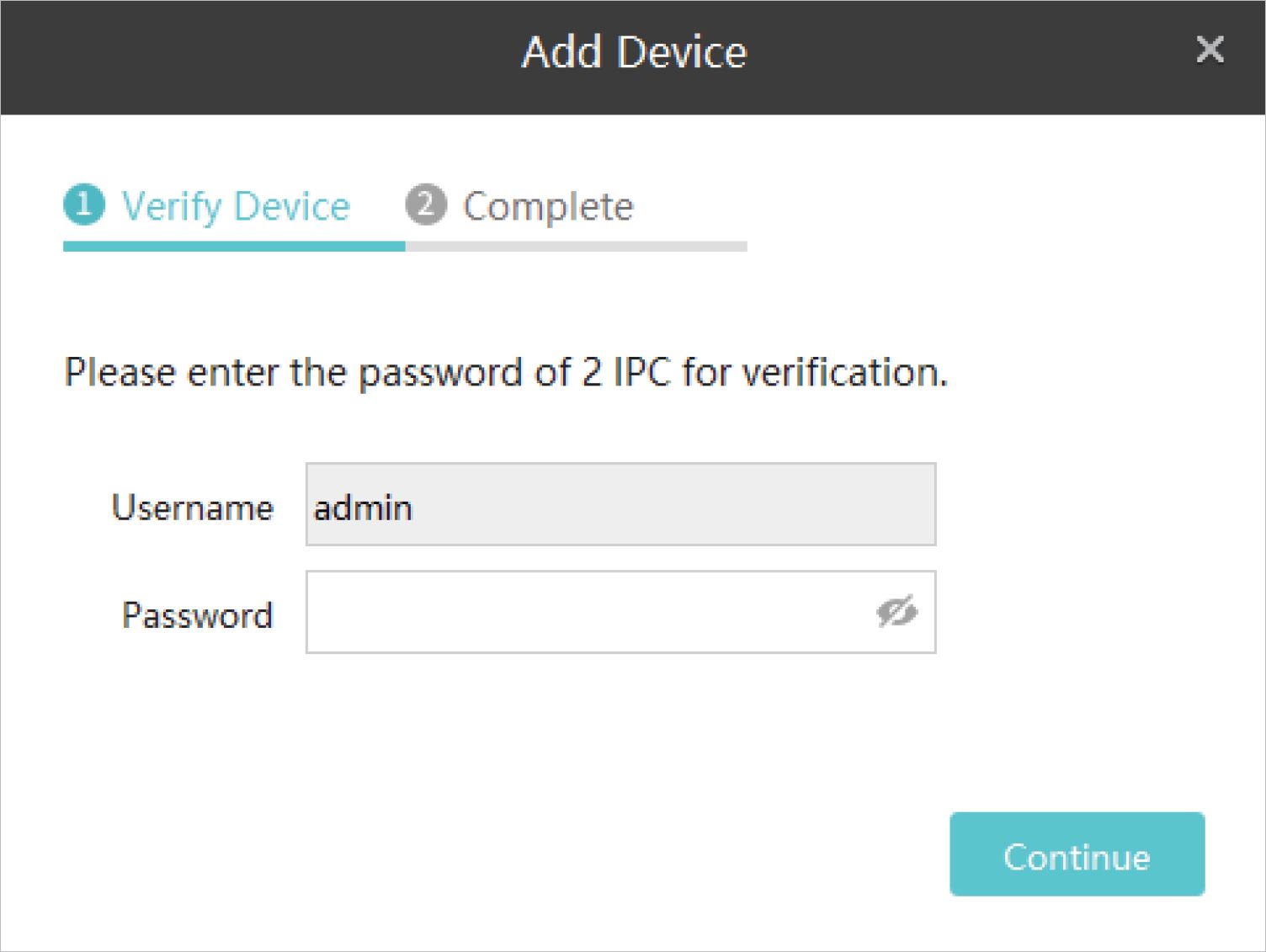
Note:
If you can’t add devices in batches, try adding your devices separately instead.
For the camera with no password, you need to set a password and a password reset email to enhance the security before adding it.
For the NVR that has not been used, create a login password on NVR itself and set it up first before adding it.
3.
Click Next after the devices are verified.
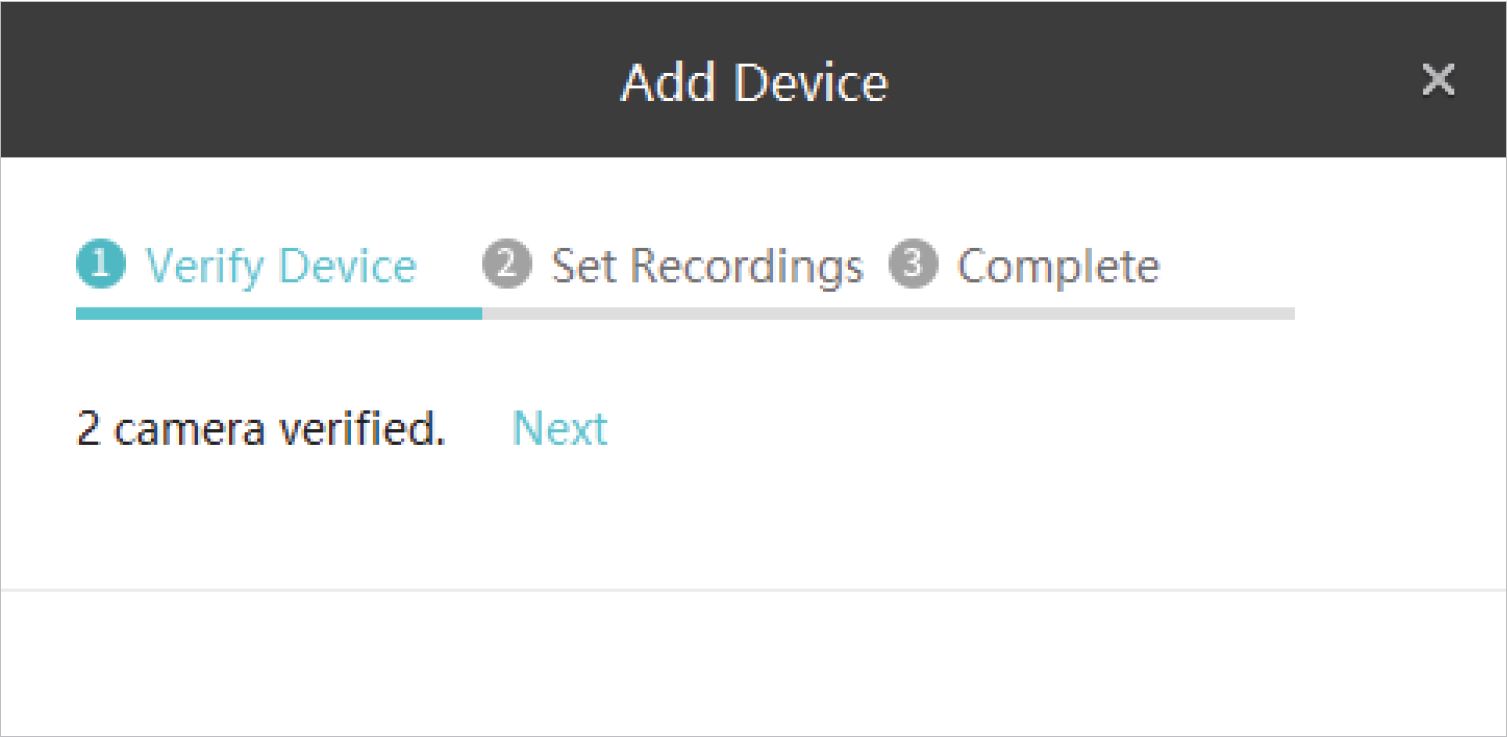
11
Chapter 2 Add Devices to VIGI Security Manager
- (Only for cameras) If you don’t want to save the recordings of your camera to your computer, directly click Confirm.
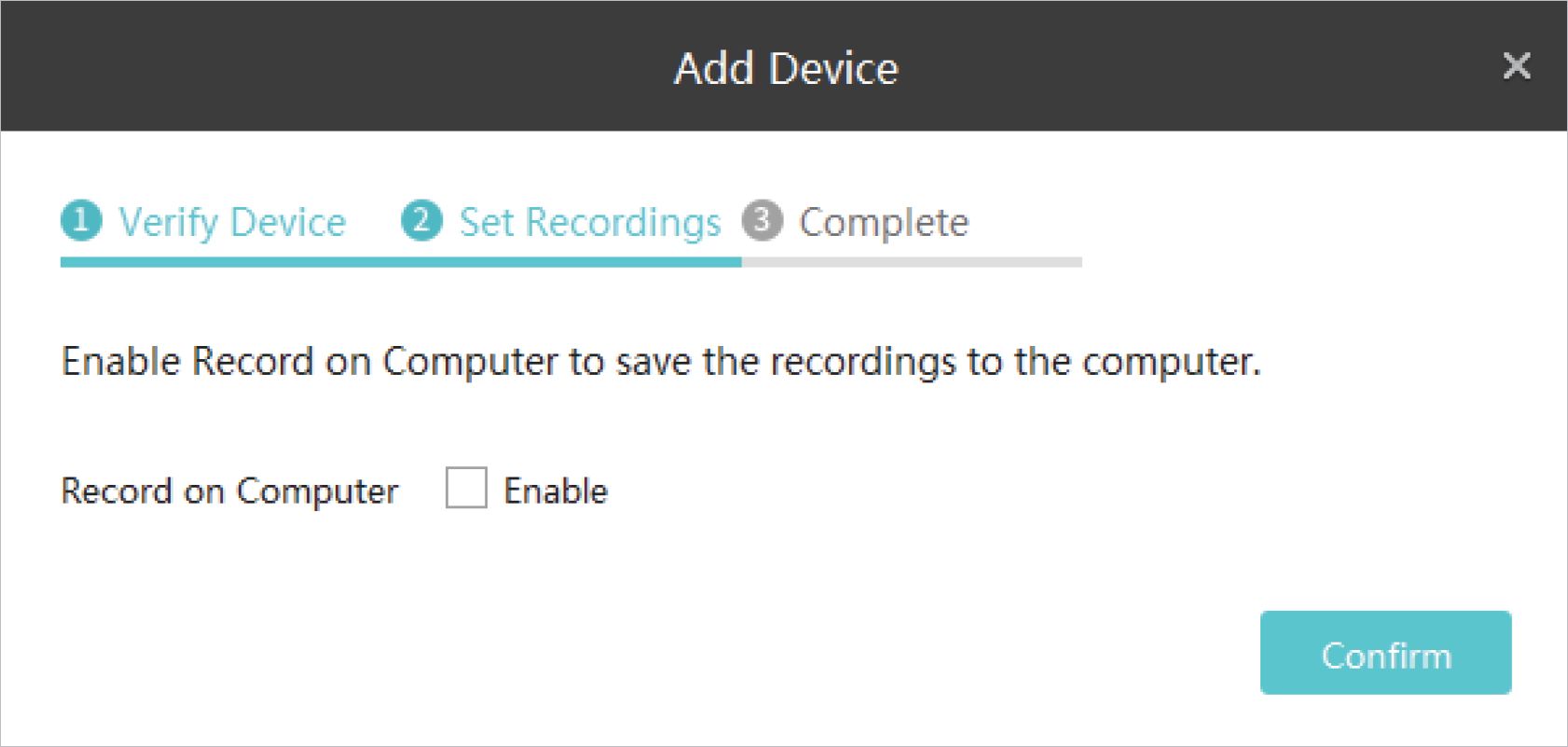
If you want to save the recordings of your camera to your computer, you can click the checkbox of Enable Record on Computer. Configure the following parameters and click Confirm.
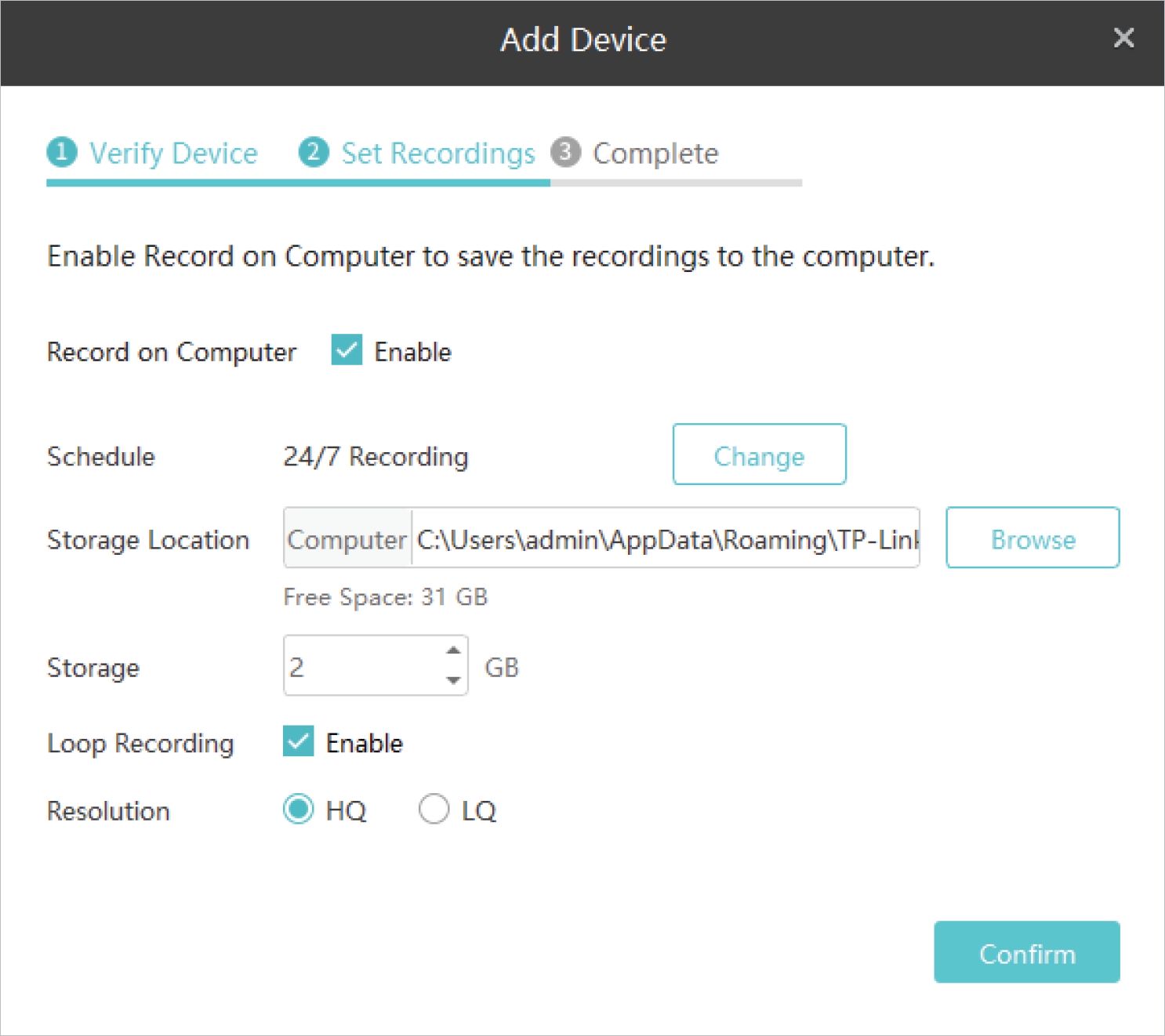
Click Change to customize the recording schedule of the Schedule camera on computer. It determines the time period for camera
recording.
Storage Location Click Browse to select the storage location of files.
12
Chapter 2
Add Devices to VIGI Security Manager
| Set the storage space for storing the recordings on your | |
| Storage | computer. The storage space you set should be less than the free space on your computer. |
| Loop Recording | Click the checkbox to enable loop recording. It allows your camera to overwrite old files with new files. |
| Resolution | Select the recording resolution. HQ and LQ refers to the high and low recording resolution respectively. |
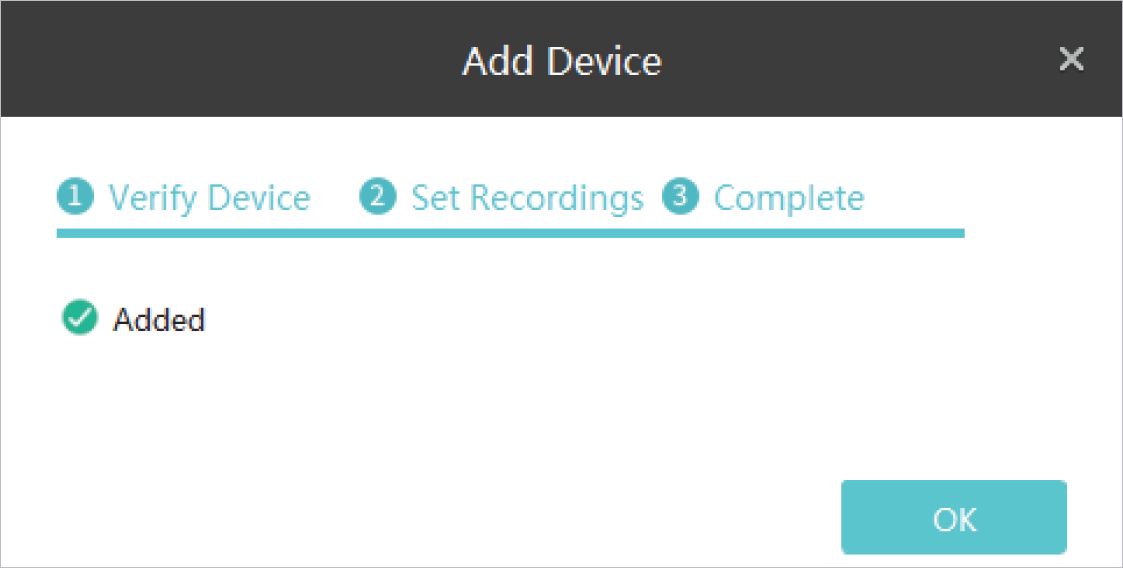
1. Go to Settings > Device List > Discovered Devices and click + A<w Manua“y
default, the port number is 80. Then click Add.
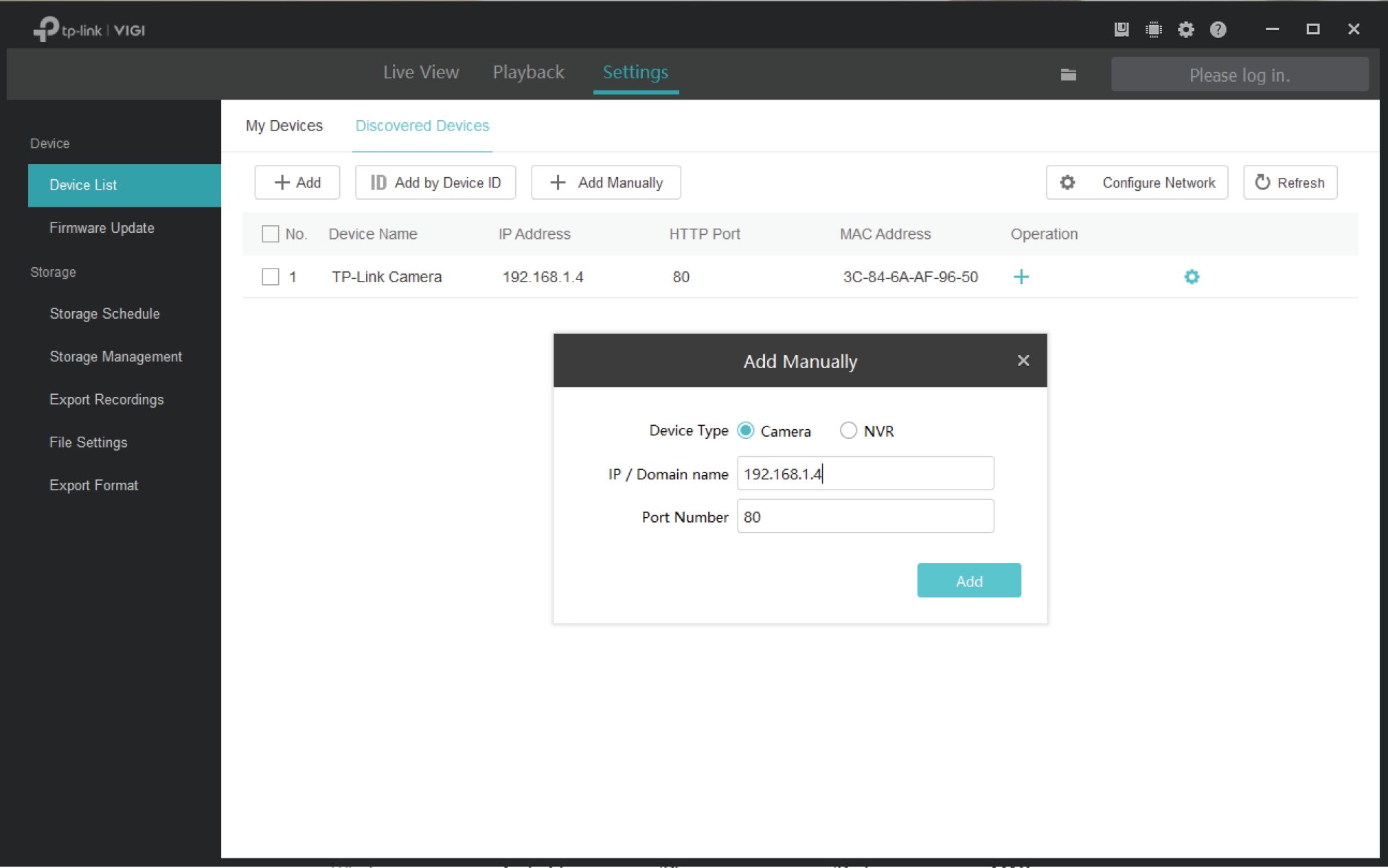
13
Chapter 2
Add Devices to VIGI Security Manager
- Enter the password of your device. VIGI Security Manager can automatically detect the IP address and port number of the device, and you can keep them as default. Click Verify.
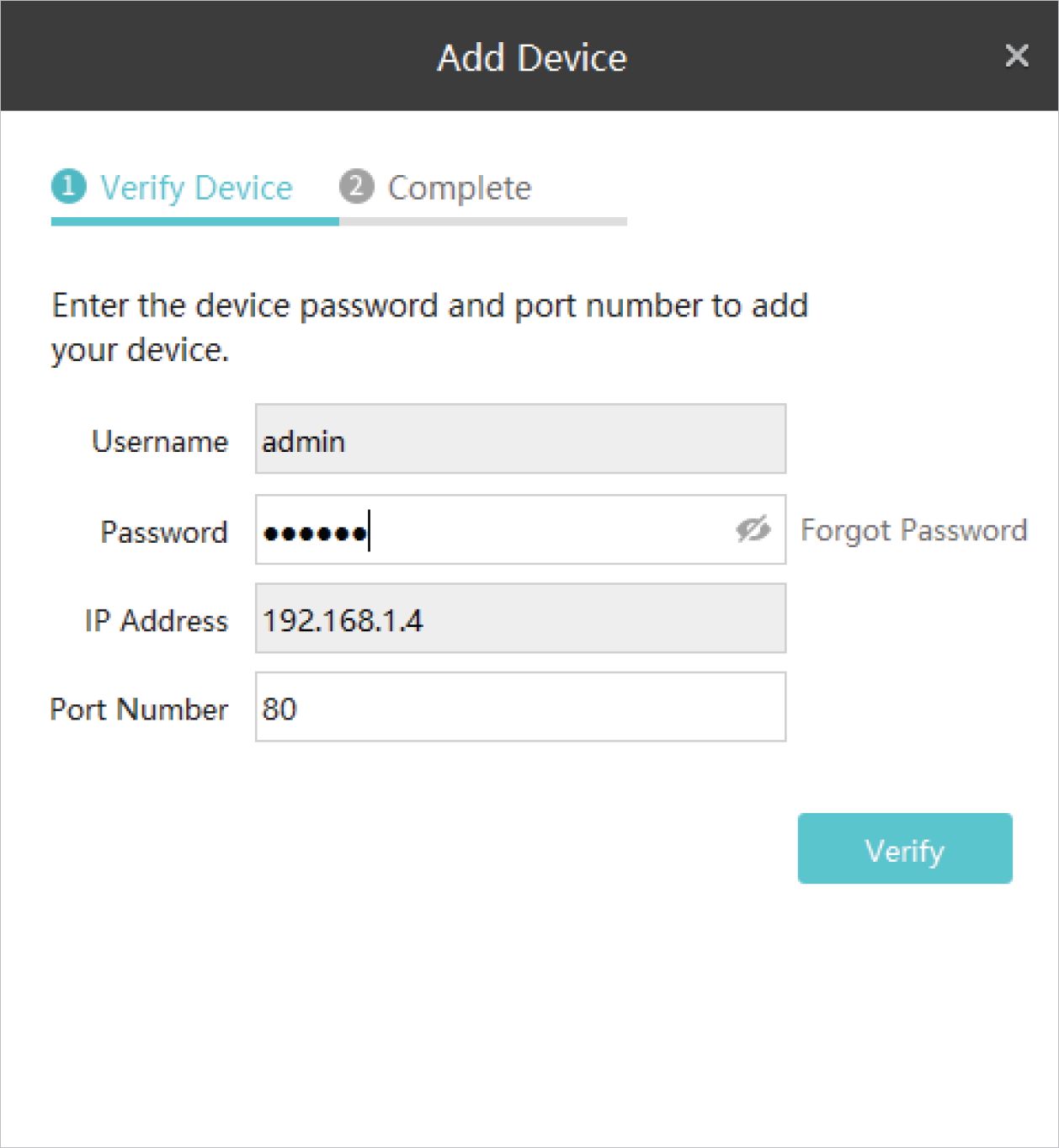
Note:
- For the camera with no password, you need to set a password and a password reset email to enhance the security before adding it.
- For the NVR that has not been used, create a login password on NVR itself and set it up first before adding it.
- (Only for cameras) If you don’t want to save the recordings of your camera to your computer, directly click Confirm.
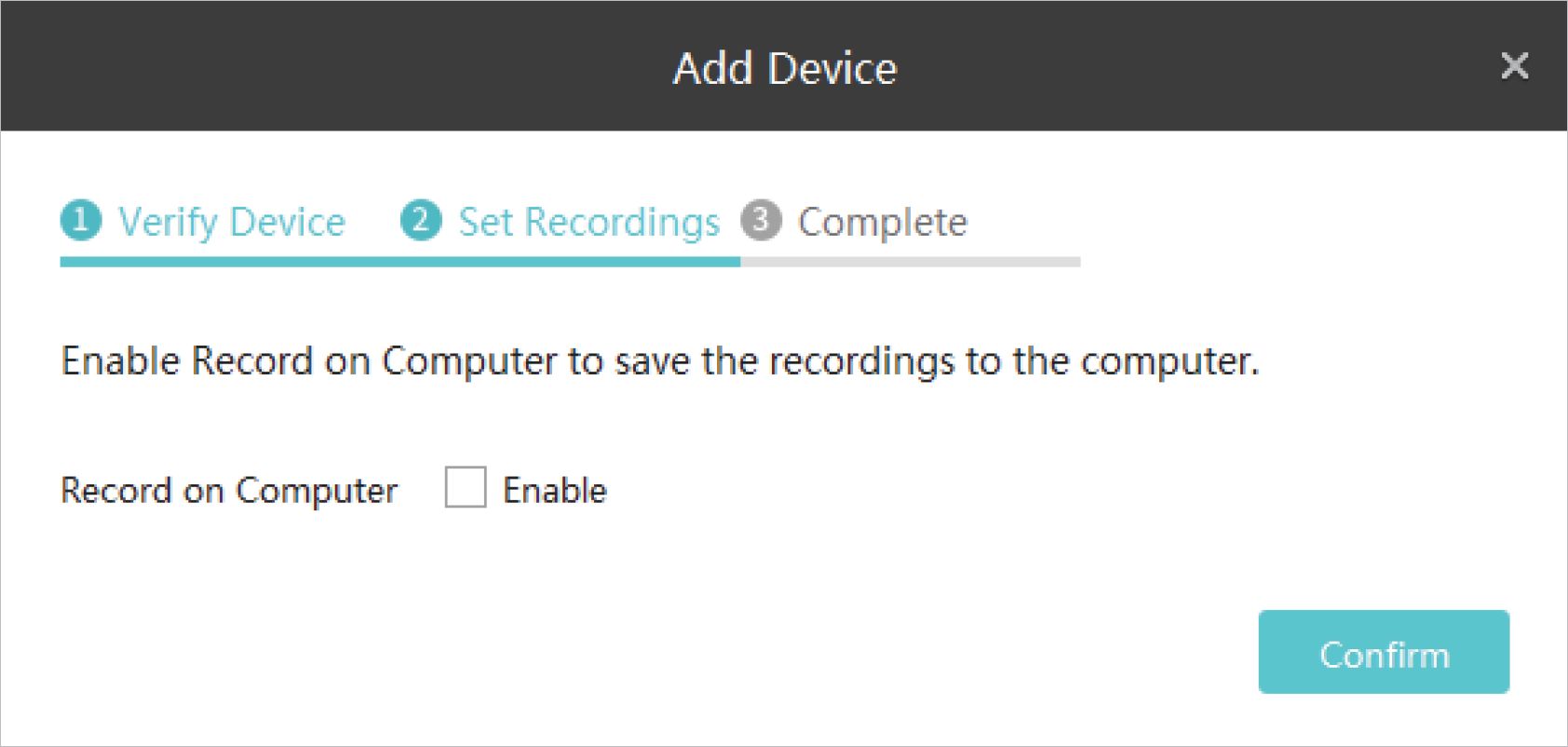
14
Chapter 2
Add Devices to VIGI Security Manager
If you want to save the recordings of your camera to your computer, you can click the checkbox of Enable Record on Computer. Configure the following parameters and click Confirm.
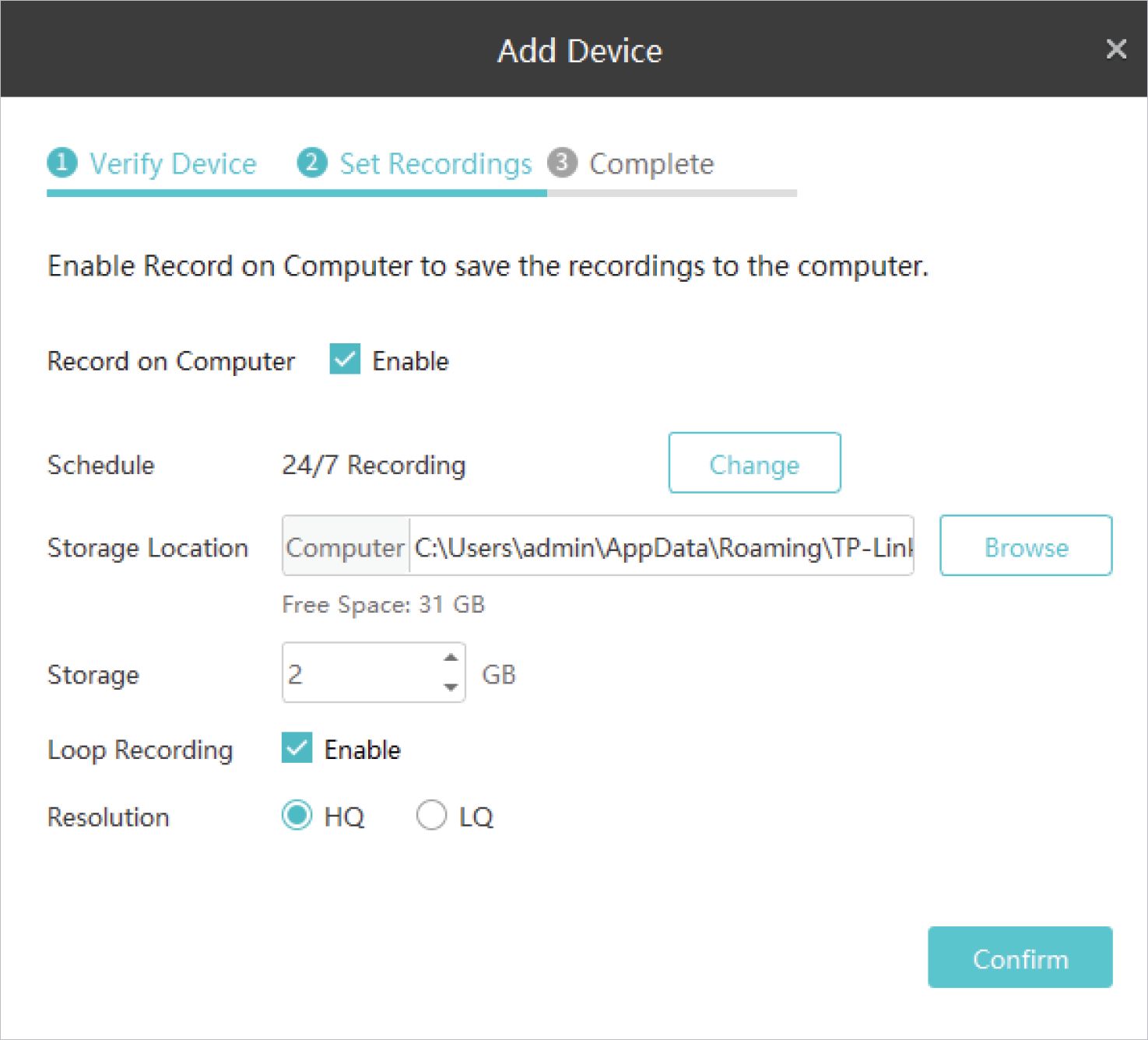
| Schedule | Click 1 Change 1 to customize the recording schedule of the camera on computer. It determines the time period for camera recording. |
| Storage Location | Click Browse to select the storage location of files. |
| Storage | Set the storage space for storing the recordings on your computer. The storage space you set should be less than the free space on your computer. |
| Loop Recording | Click the checkbox to enable loop recording. It allows your camera to overwrite old files with new files. |
| Resolution | Select the recording resolution. HQ and LQ refers to the high and low recording resolution respectively. |
15
Chapter 2
Add Devices to VIGI Security Manager
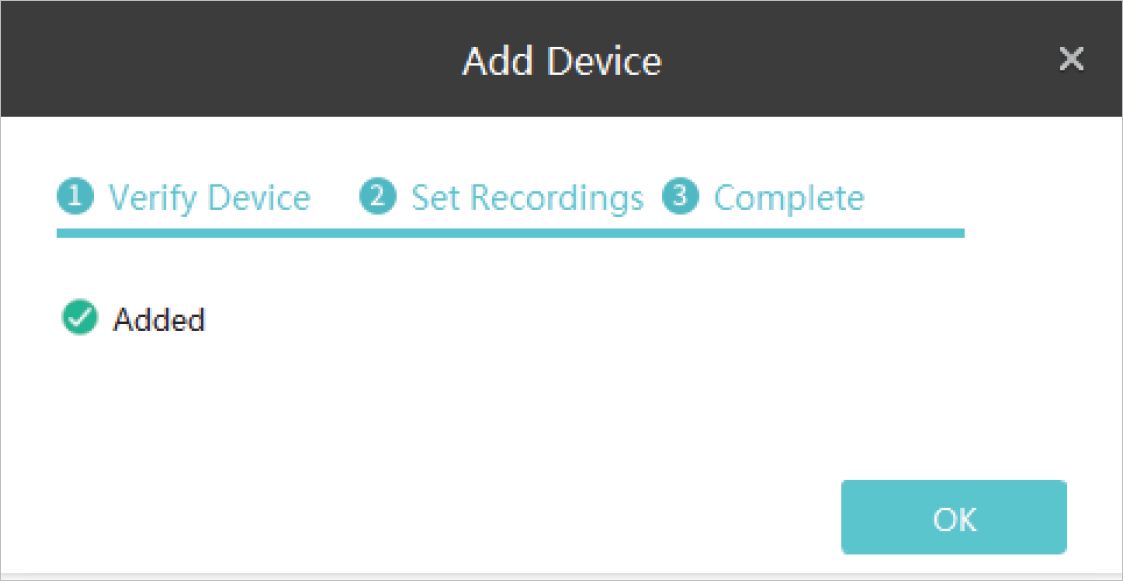
2. 1.2 Add Devices to VIGI Security Manager When TP-Link ID is Logged in
Follow the steps below to add a device.
1. Go to Settings > Device List > Discovered Devices and click 4 in the list.
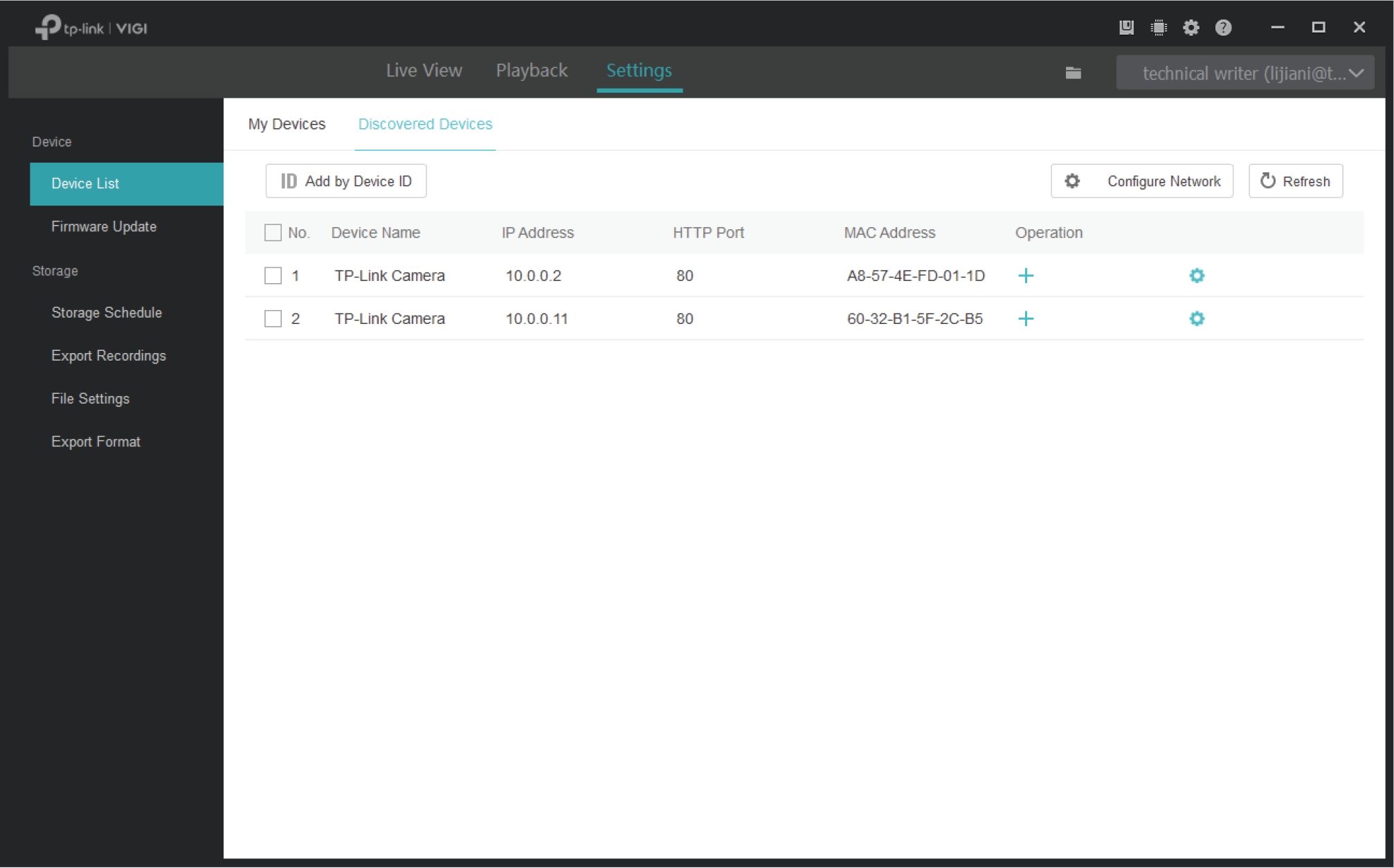
0 Configure Network
Set the IP address, gateway and subnet mask of your device.
Ö Refresh
Click & Refresh
to refresh the device list.
16
Chapter 2
Add Devices to VIGI Security Manager
- Enter the password of your device. VIGI Security Manager can automatically detect the IP address and port number of the device, and you can keep them as default. Click Verify.
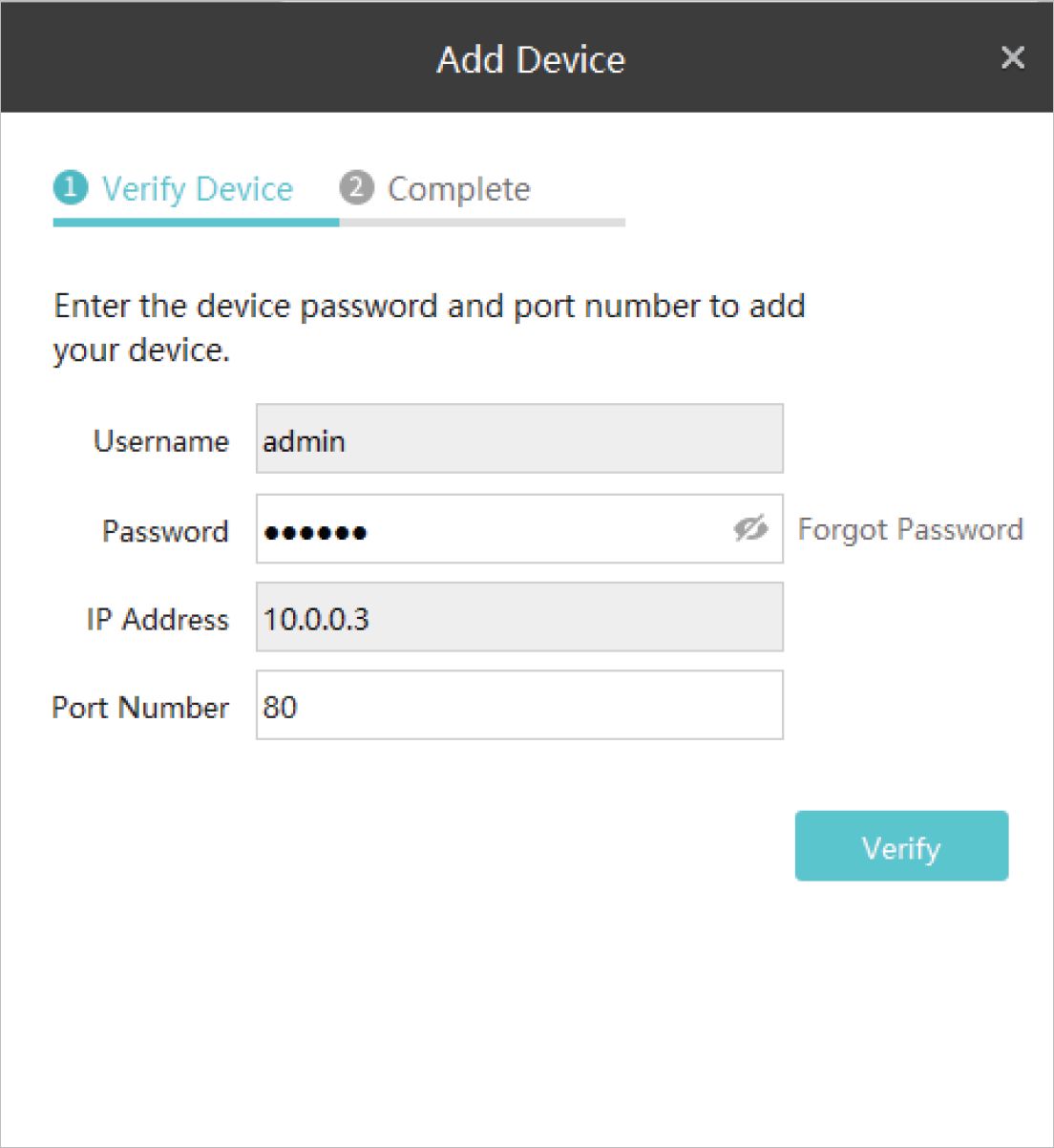
Note:
For the camera with no password, you need to set a password and a password reset email to enhance the security before adding it.
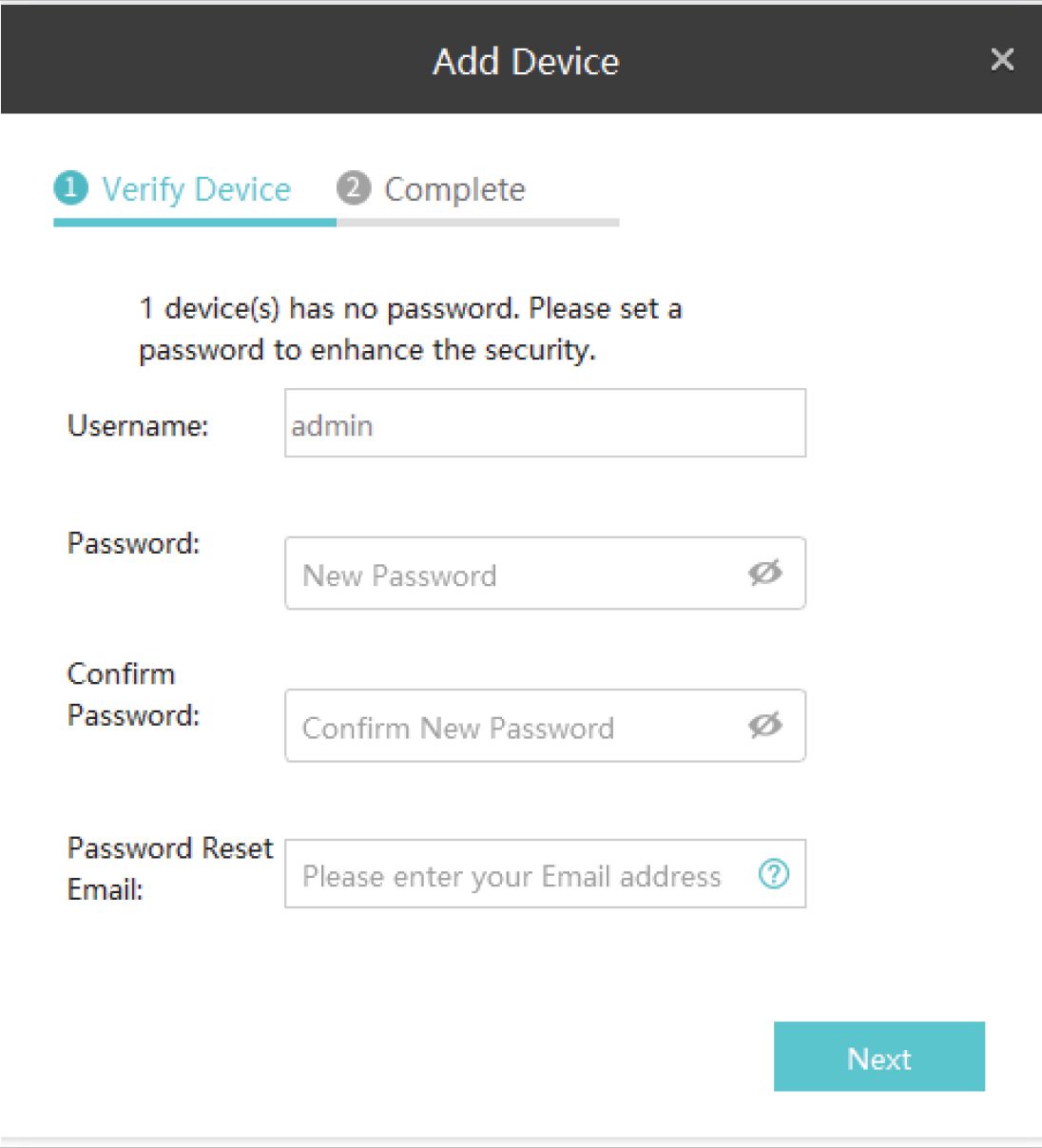
17
Chapter 2
Add Devices to VIGI Security Manager
| Username | Displays the username of the camera. |
| Password | Set the password of the camera. |
| Confirm Password | Confirm the password of the camera. |
| Password Reset Email | Set the email address for resetting the camera’s password. |
• For the NVR that has not been used, create a login password on NVR itself and set it up first before adding it.
- Wait for the device to be added, then click OK. The device is now bound to your TP-Link ID. Note that you need to add the device again if you log out of your TP-Link ID.
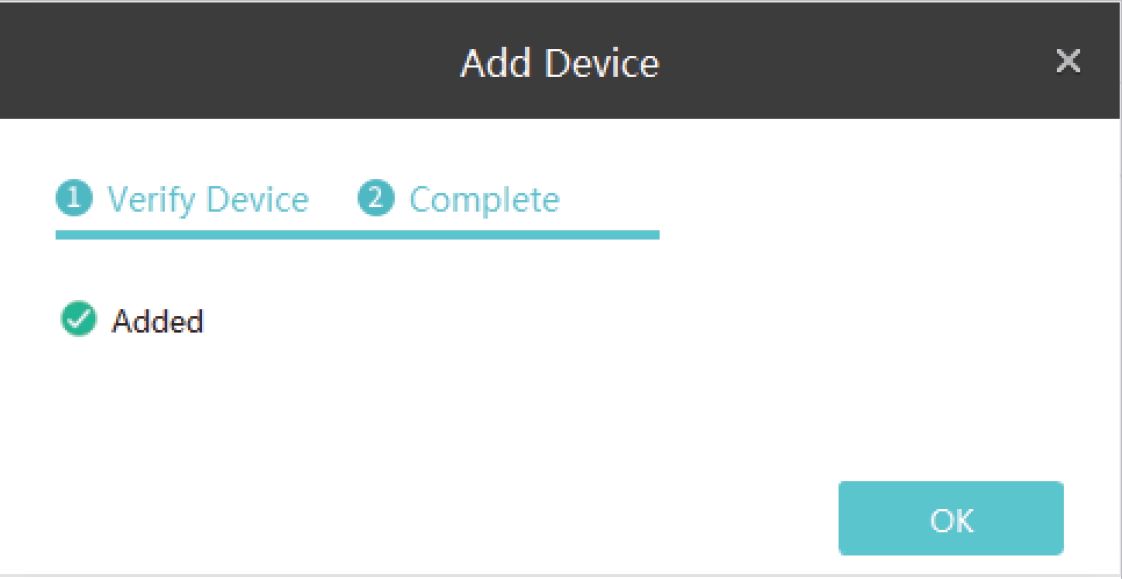
18
Chapter 2
Add Devices to VIGI Security Manager
Every VIGI NVR and VIGI Security Camera has a device ID printed on its label. When your devices are not in the same subnet as your computer, you can add them remotely by verifying its device ID. Make sure your computer and devices all have access to the internet before adding your devices. Follow the steps below to finish the configuration.
1. Go to Settings > Device List > Discovered Devices and click ID Add by Device id . If you have not logged in to your TP-Link account, use your TP-Link ID and passwword to log in first.
tp link VIGI
Device
Device List
Firmware Update
Storage
Storage Schedule
Export Recordings
File Settings
Export Format
lijiani@tp-link. com. cn
LS * O ©
Live View Playback Settings
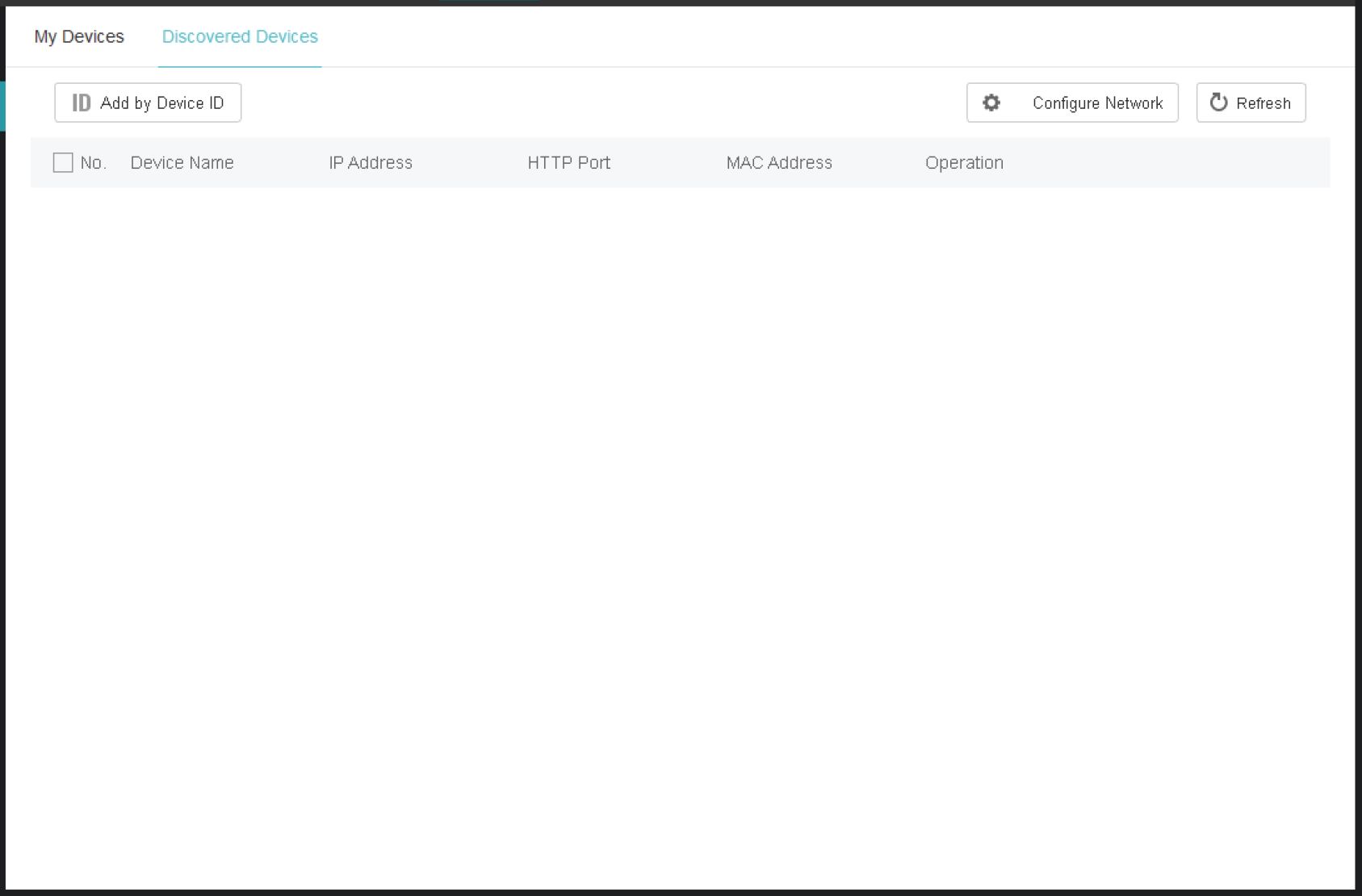
19
Chapter 2
Add Devices to VIGI Security Manager
2.
Find the device ID on the product label and enter it into the blank, then click Add.
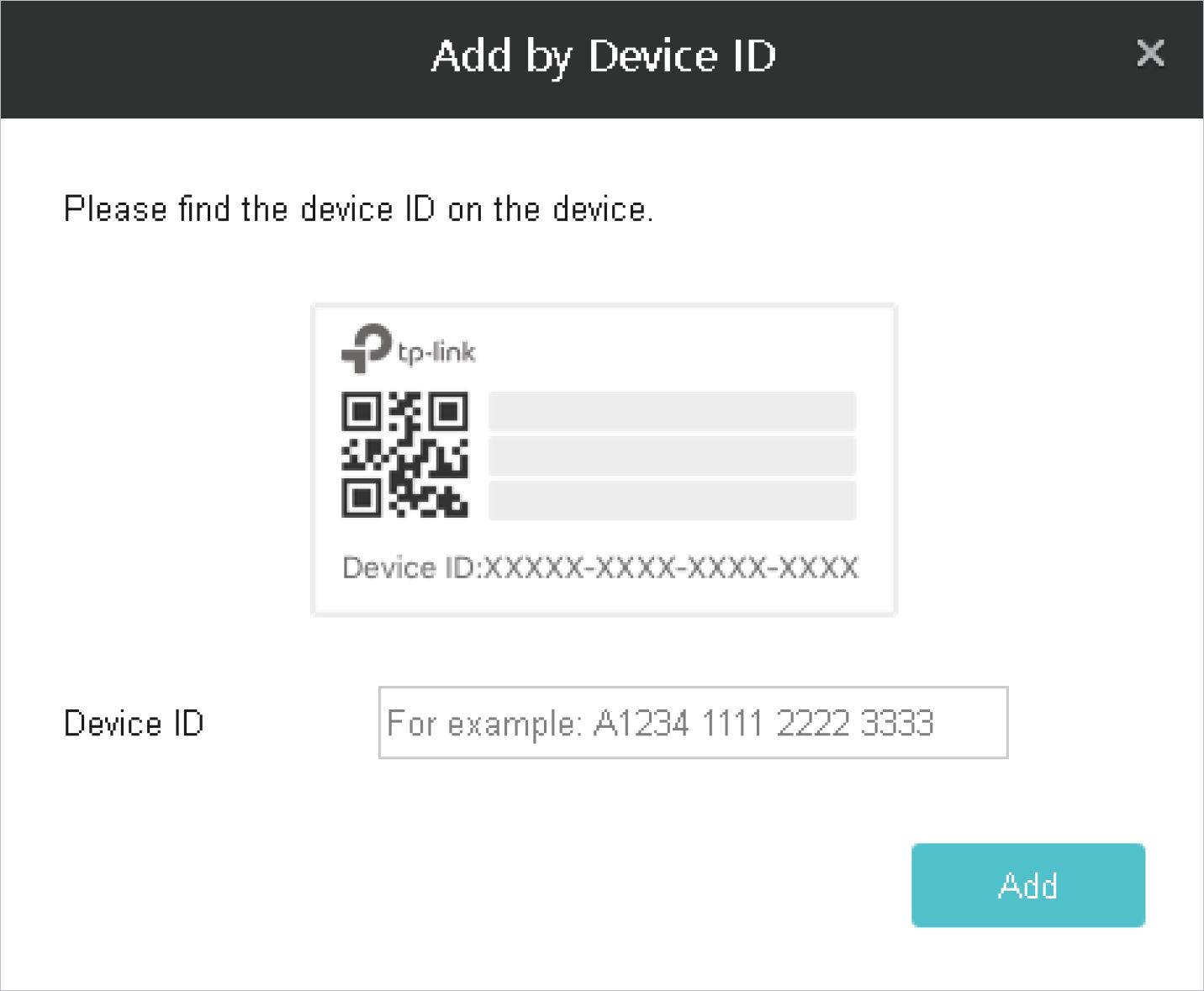
3.
Enter the password of your device and click Verify.
Add Device x
O Verify Device O Complete
Please enter the password of the device for verification.
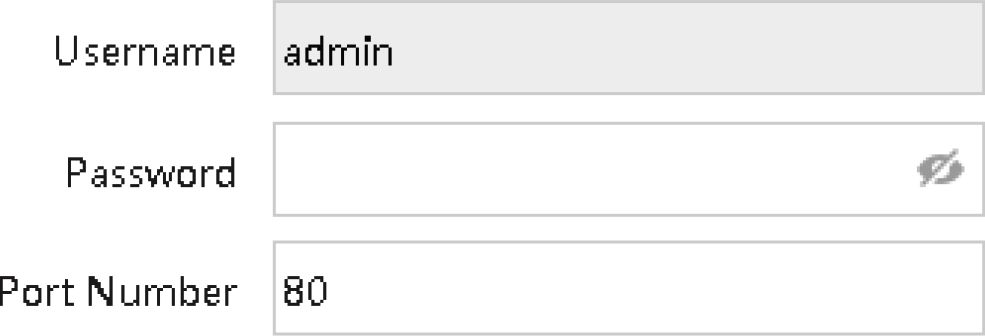
Verify
20
Chapter 2
Add Devices to VIGI Security Manager
Note:
• For the camera with no password, you need to set a password and a password reset email to enhance the security before adding it.
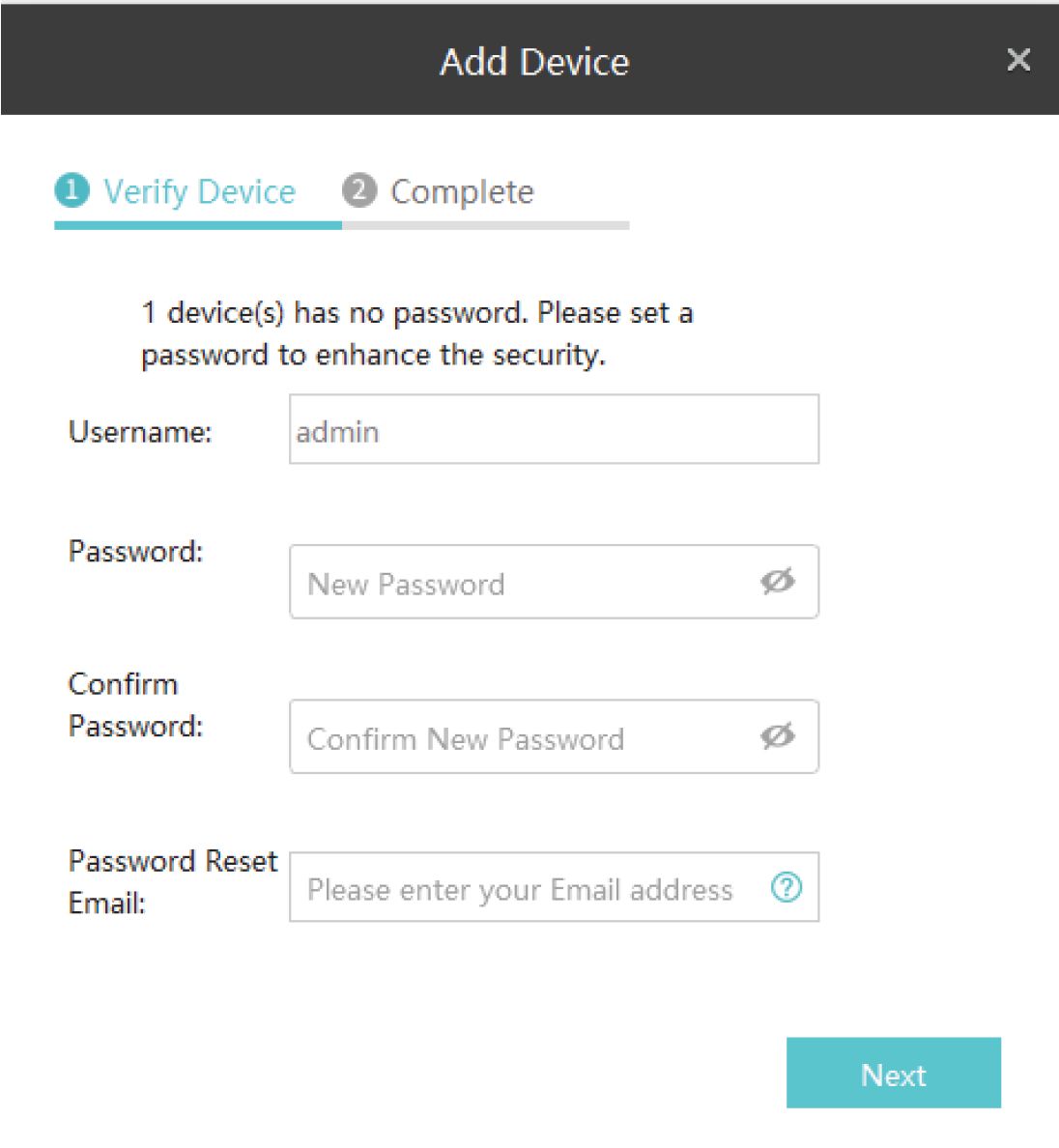
Username Displays the username of the camera.
Password Set the password of the camera.
Confirm Password Confirm the password of the camera.
Password Reset Set the email address for resetting the camera’s password.
For the NVR that has not been used, create a login password on NVR itself and set it up first before adding it.
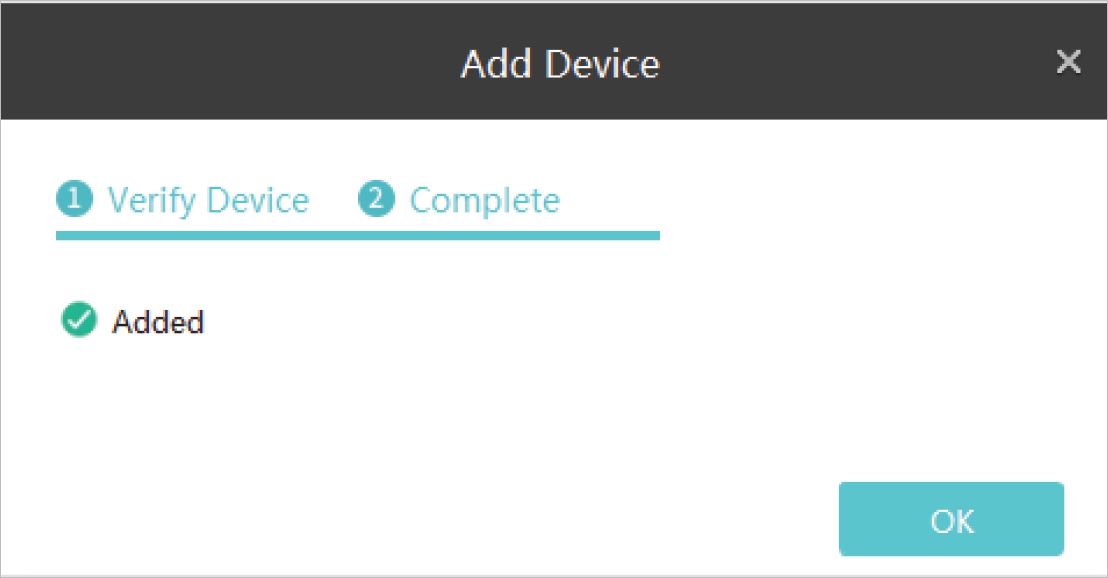
21
(3)
TP-Link ID can be used to view the Live View video and manage the devices remotely in multiple platforms. In VIGI Security Manager, you can log in with your TP-Link IDs and manage the devices bound to them. This chapter contains the following sections:
Chapter 3
TP-Link ID Management
V 3. 1 Log In with Your TP-Link ID
You can log in to VIGI Security Manager with multiple TP-Link IDs and switch the login account whenever you want. After you logging in, the NVR can manage the devices bound with the logged TP-Link ID only.
Note:
- If you have added local devices to the manager, a window will pop up after login. If you want to manage them via cloud services, click Bind to bind them with the logged TP-Link ID in batch; if not, click Cancel.
- After login, the recording, storage and playback are not available for the cameras managed by VIGI Security Manager.
Log In
When no account is logged in, follow the steps below.
- Click Please log in. on the top-right corner and enter your TP-Link ID and password. You can enable Auto Login to allow the utility to remember your account and log in automatically when switching it as the logged account. Click Log In.
Log In
Note: You’ II need to add the local device(s) again after the login.
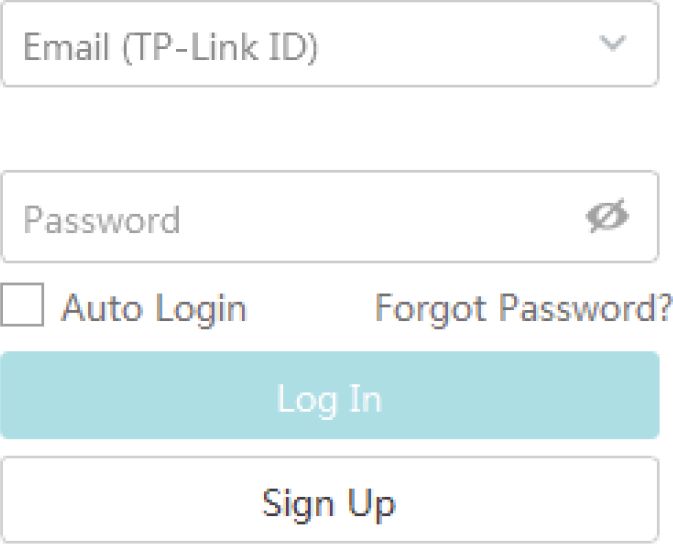
23
Chapter 3
TP-Link ID Management
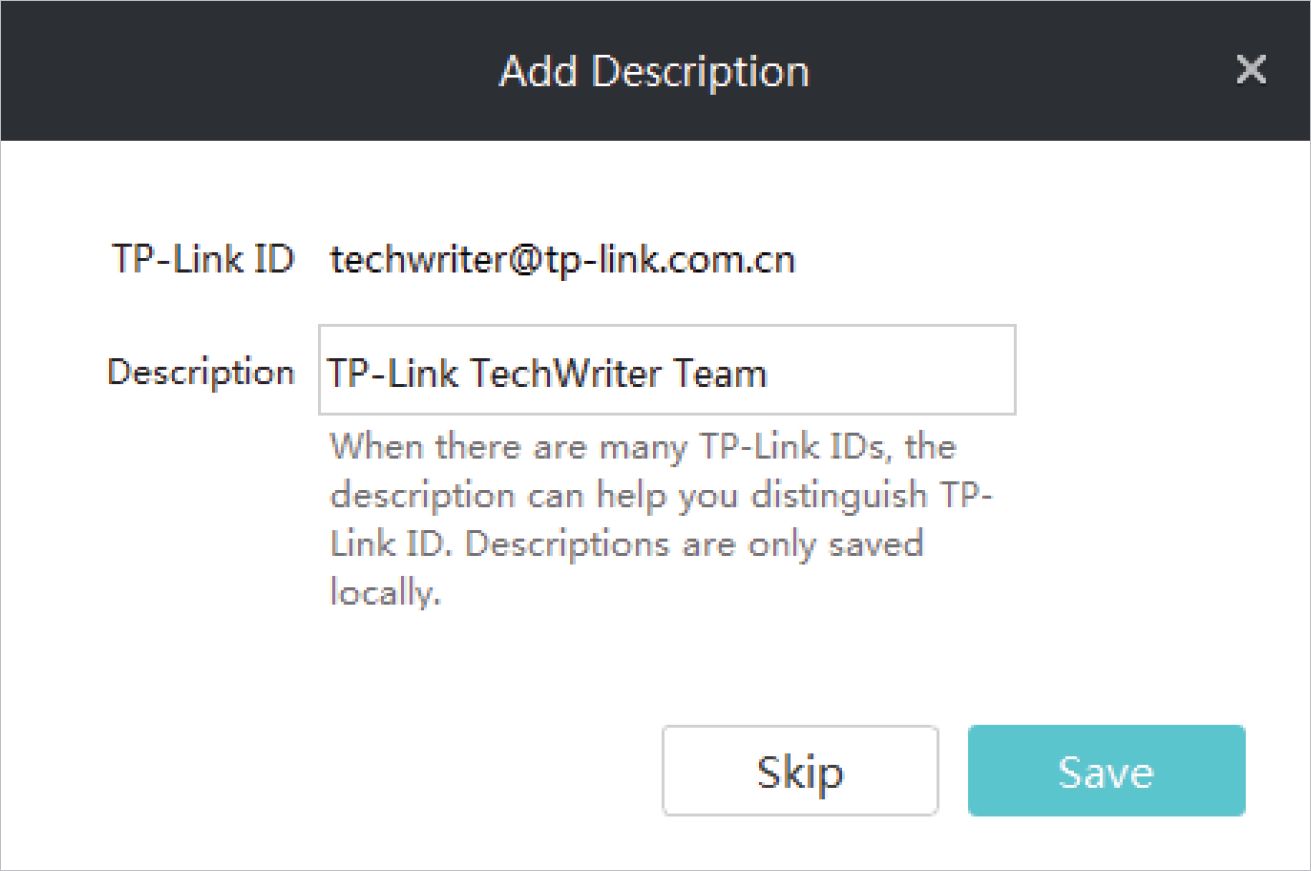
To log in with a new TP-Link ID, click the TP-Link ID on the top-right corner, click Add TP-Link ID, and then repeat the above steps.
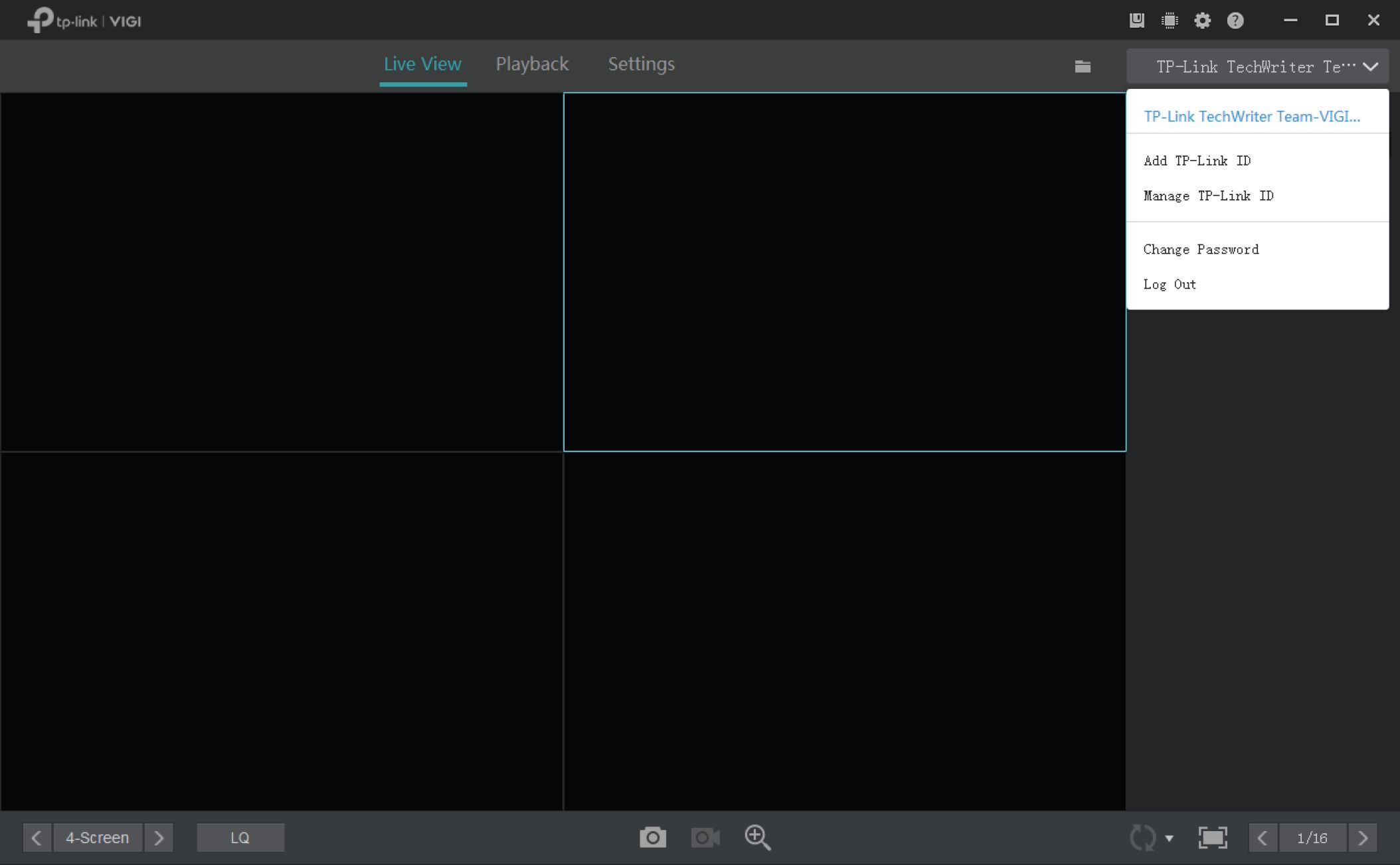
24
Chapter 3
TP-Link ID Management
Switch the Logged TP-Link Account
To switch the logged TP-Link account, click the TP-Link ID on the top-right corner and select an account from the drop-down list. If you have enabled Auto Login for this account, wait for switching. If not, enter the password to log in.
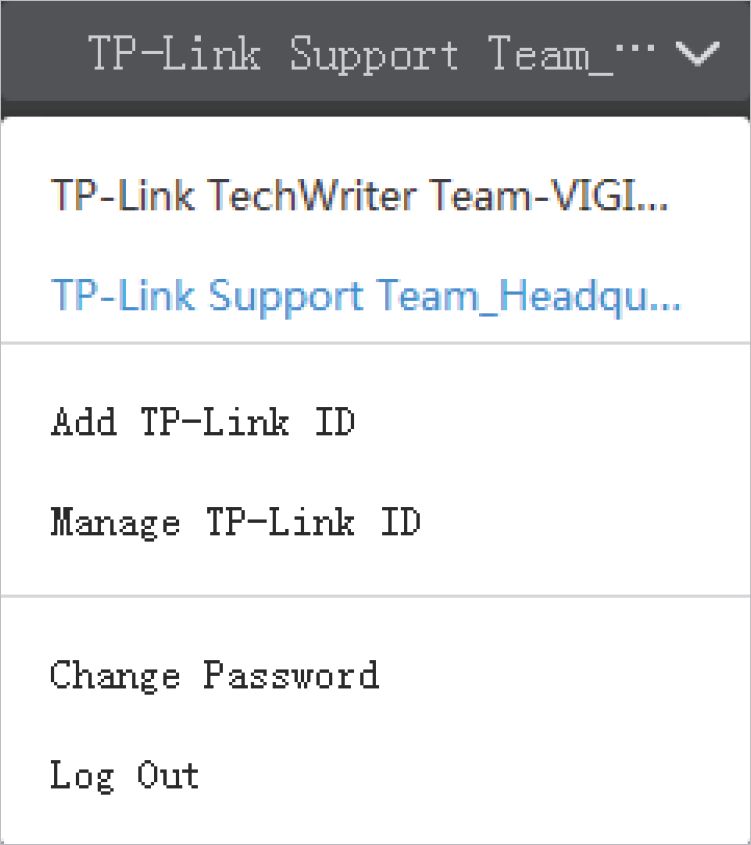
On the Account Management panel, you can update the account information, change the order displayed on the top-right corner, and delete the account.
Note: The account that you log in with right now cannot be deleted. To delete it, switch the logged account first.
Follow the steps to manage your TP-Link ID.
1. Click the TP-Link ID on the top-right corner and click Manage TP-Link ID.
25
Chapter 3
TP-Link ID Management
2. In the pop-up window, select an account, enter the new account information, and click Save. Use the icons to adjust the displayed order and delete the account.
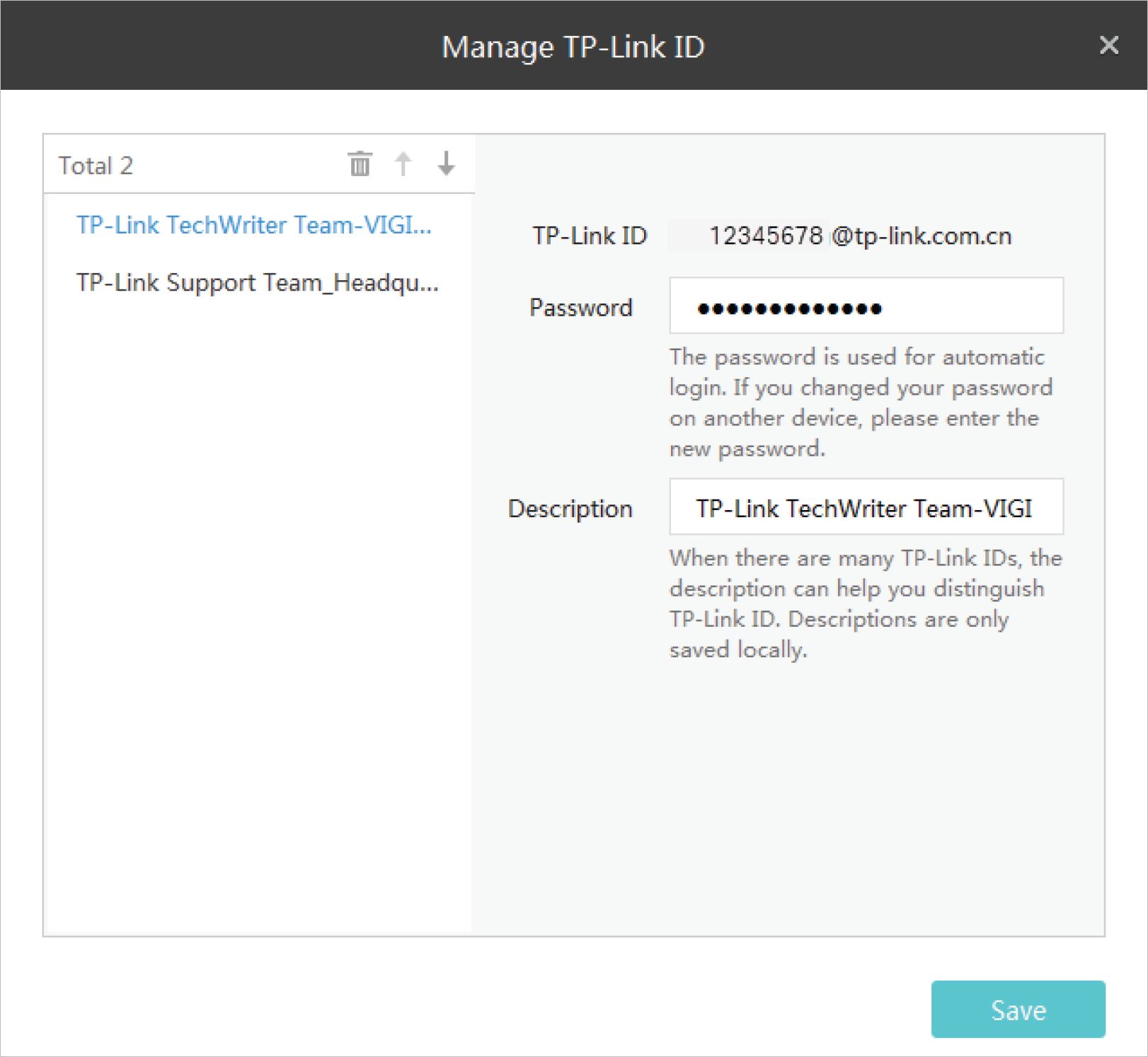
| Password | If you changed your password on another device, enter the new password here to pass the authentication and log in automatically. |
| Description | Specify the description of this account. The description is only saved locally.
Click to adjust the displayed order of the account. |
| m | Click to delete the account. |
26
Chapter 3
TP-Link ID Management
To change the password of a TP-Link ID, log in with the TP-Link ID first. Click the TP-Link ID on the topright corner and click Change Password. Enter the current password and specify a new password.
Click Save.
Change Password
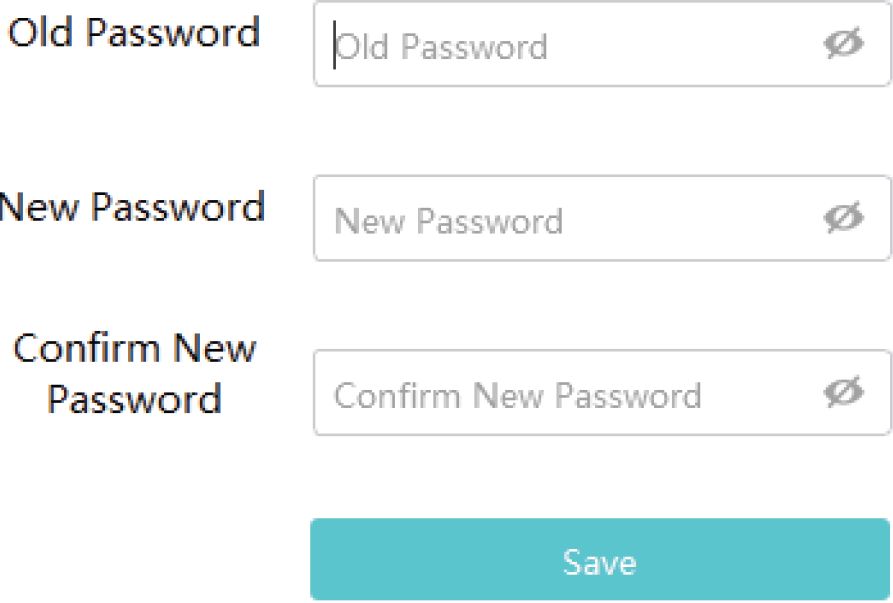
To log out the current account, click the TP-Link ID on the top-right corner and click Log Out.
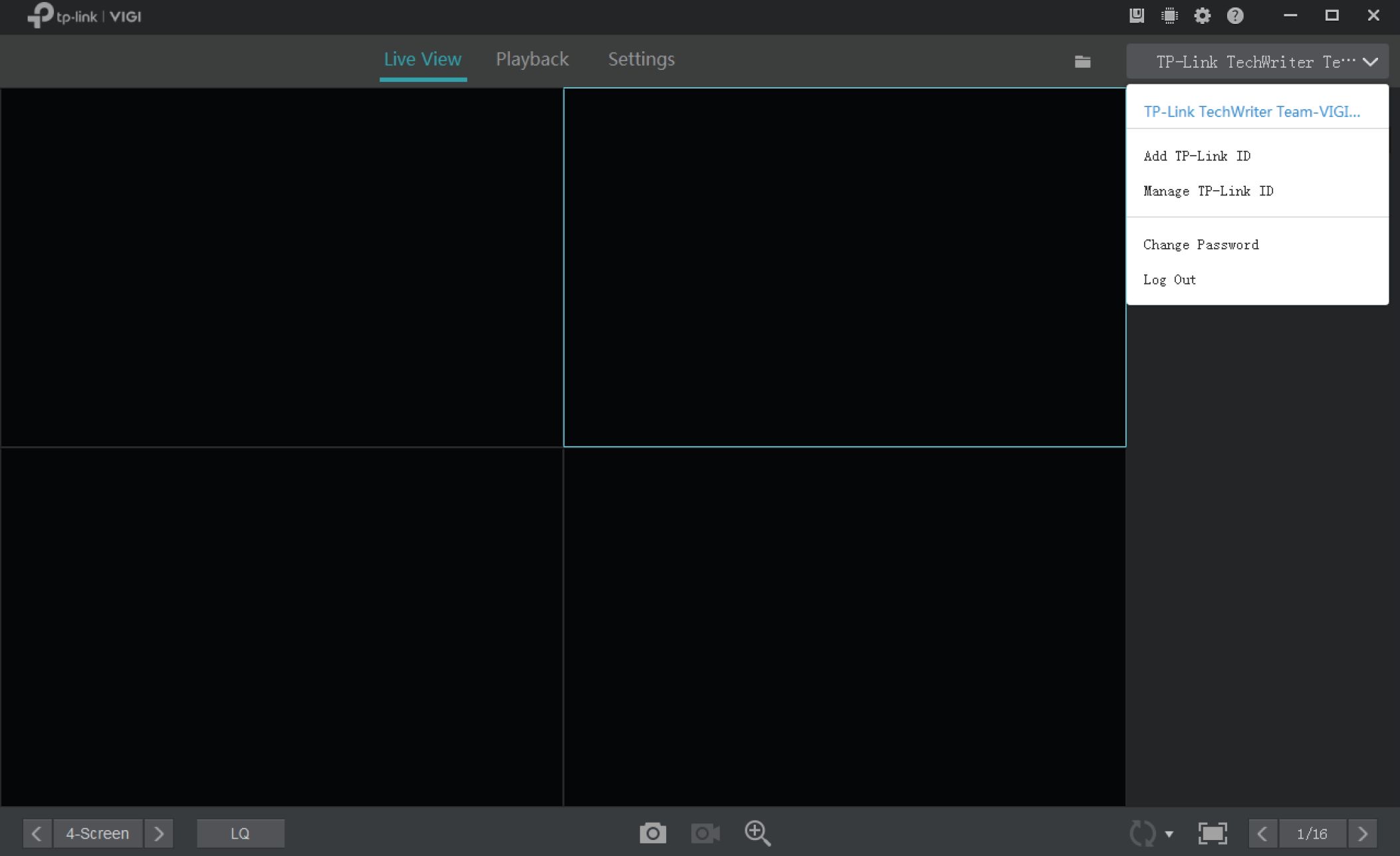
27
(4)
In Live View, you can monitor the channels in real time and respond to abnormal conditions with quick operations, such as starting recording and zooming in the image. This chapter contains the following sections:
Chapter 4
Live View
V 4. 1 Configure the Screen Layout
VIGI Security Manager displays the videos of each channel via several screens. Follow the steps below to flexibly enable or disable Live View function on channels to play the real-time video.
Enable/Disable Live View for a Channel
To enable Live View for a single channel, click a screen in Live View and click the channel on the right panel.
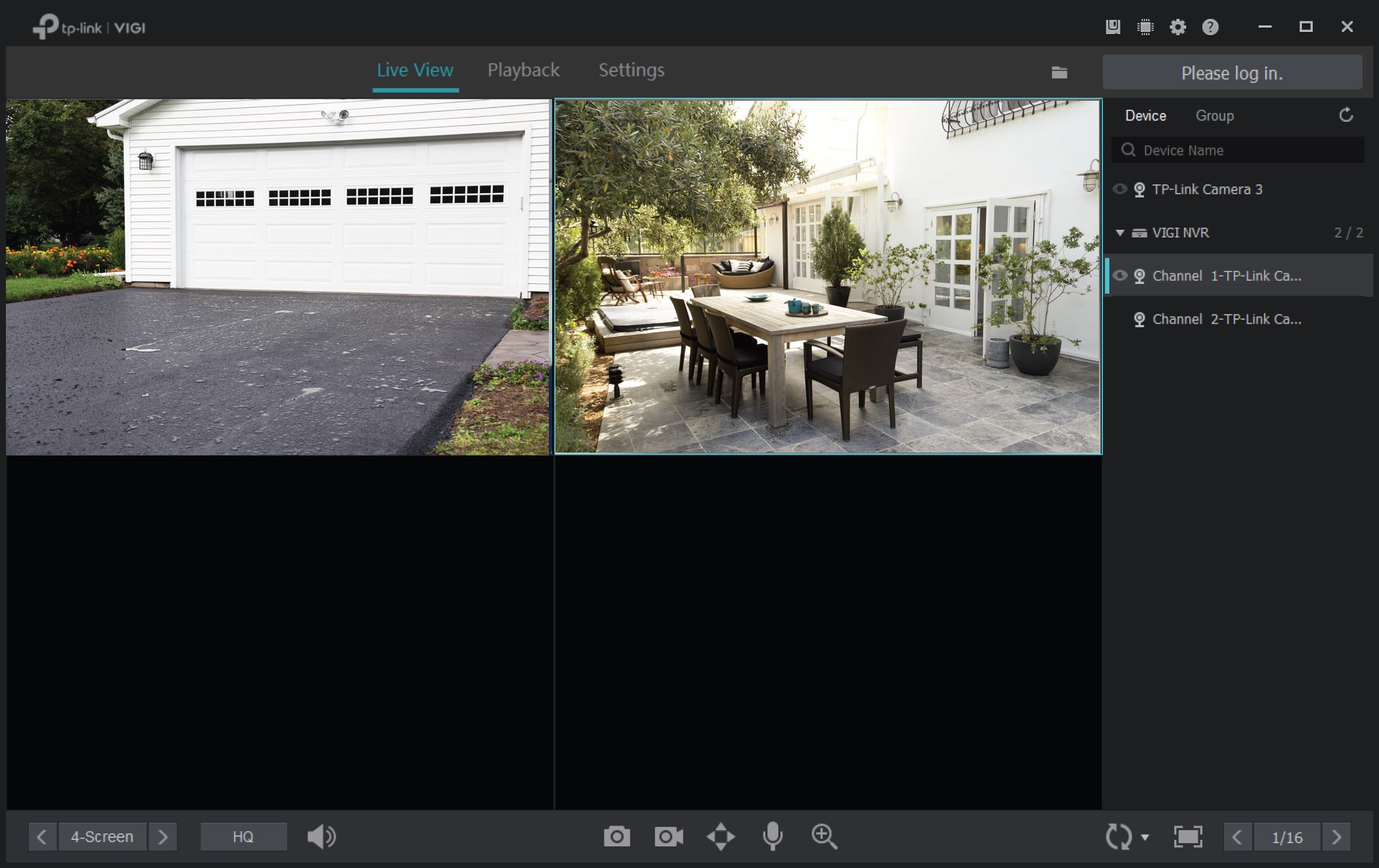
To disable Live View for a single channel, click a screen in Live View and click E3.
Enable/Disable Live View for Channels in Batch
For the cameras managed by the NVR or added to a group, you can enable or disable Live View for channels in batches. To create groups, refer to 4. 3 Add and Manage Groups.
29
Chapter 4
Live View
Right click an NVR or group on the right panel and click Enable Live View for All Channels. Then, Live View will be enabled on all channels that are managed by the NVR or added to the group.
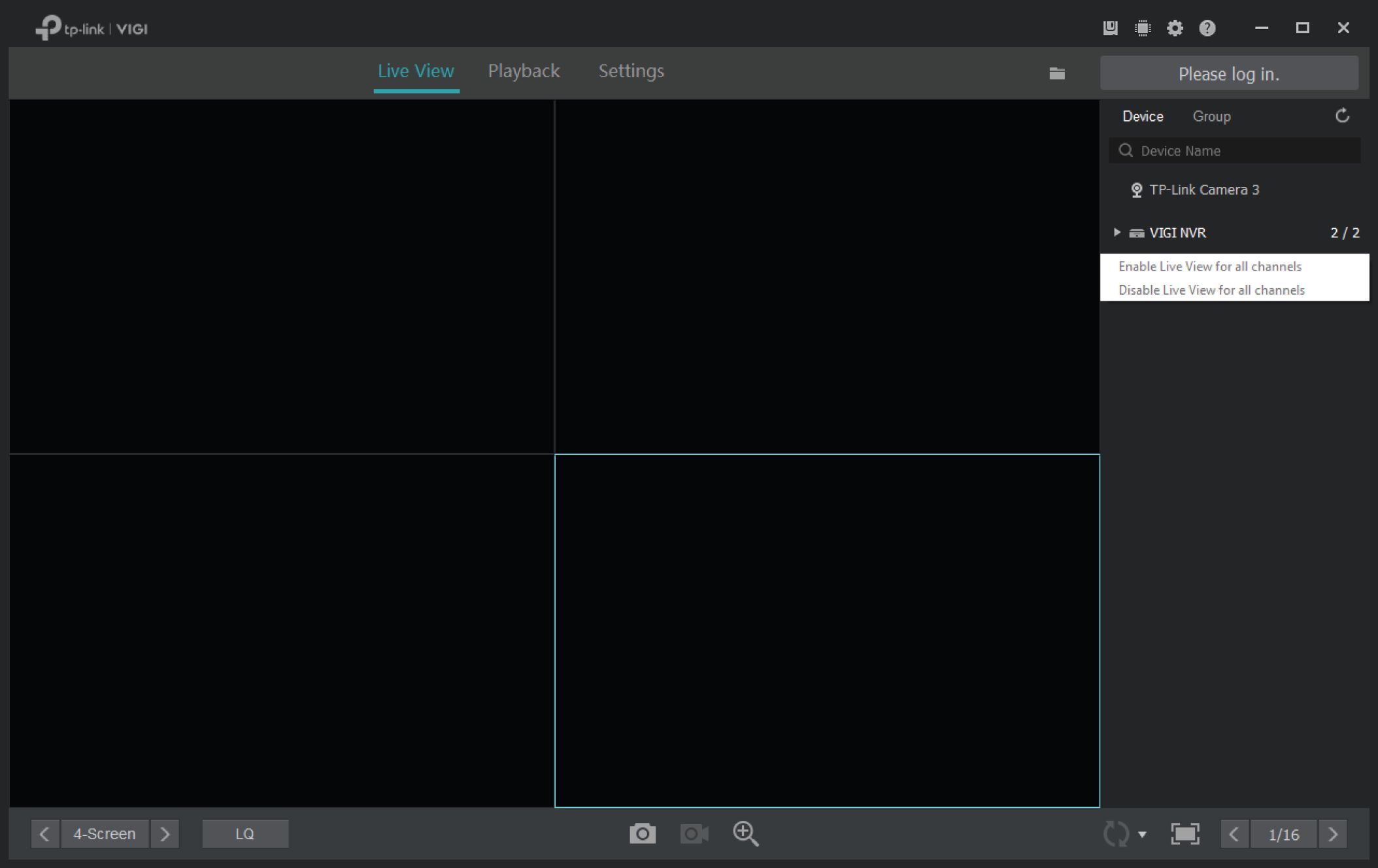
To disable Live View in batches, right click an NVR or group on the right panel and click Disable Live View for All Channels.
30
Chapter 4
Live View
The manager supports ten layout modes, and each mode displays different numbers of screens. Click

to select a layout mode and click
< 1/16 >
to change the page.
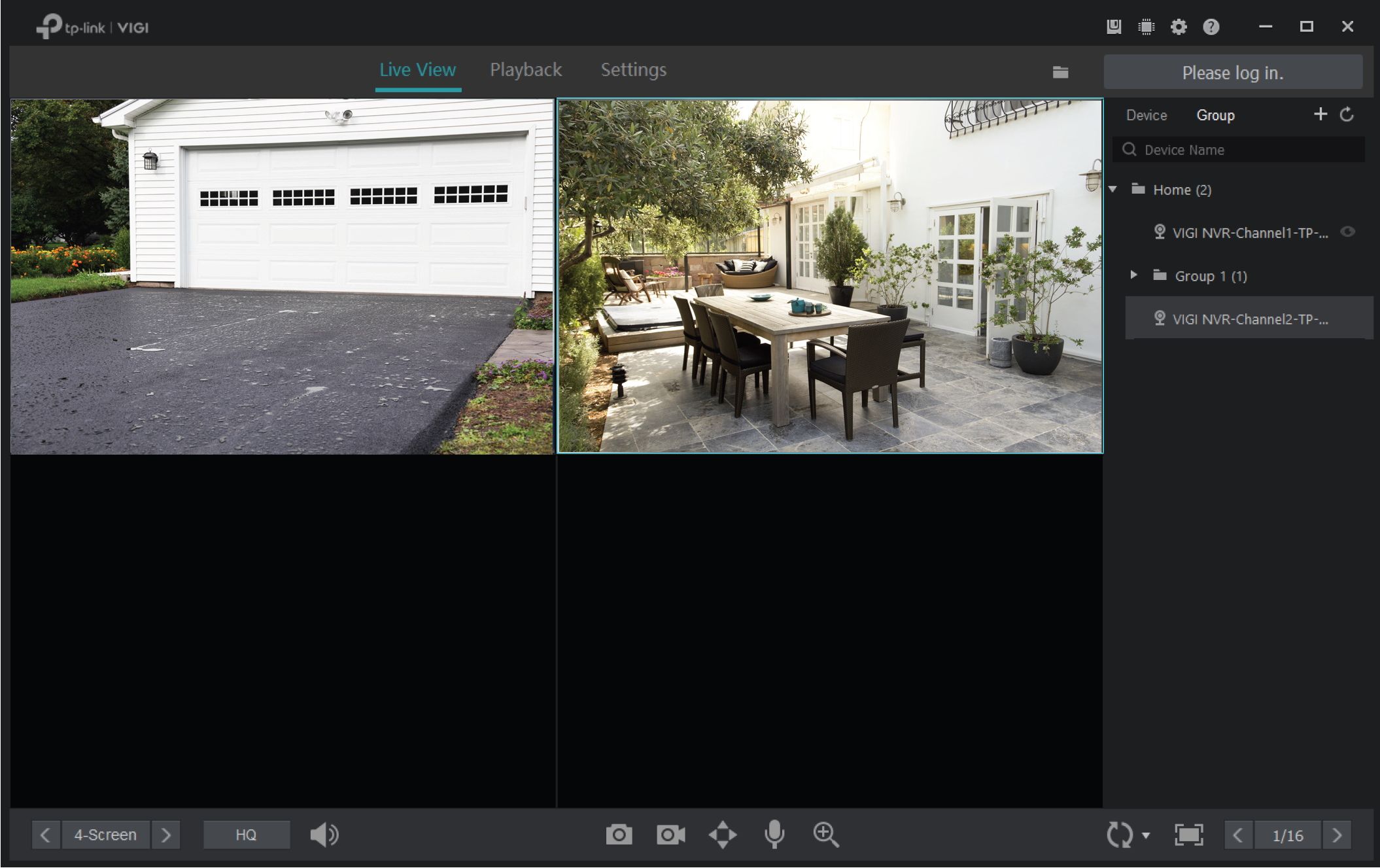
For the layout mode with multiple screens, you can change the location of a channel by clicking and dragging it to another location. To view a channel in the full screen, double click it. Double click it again to go back to multi-screen layout mode.
31
Chapter 4
Live View
V 4. 2 Configure Live View Settings
4. 2. 1 Configure Live View Settings via Toolbar
Click a screen in Live View and click the following icons to configure Live View settings, such as screenshot, digital zoom, and switching.
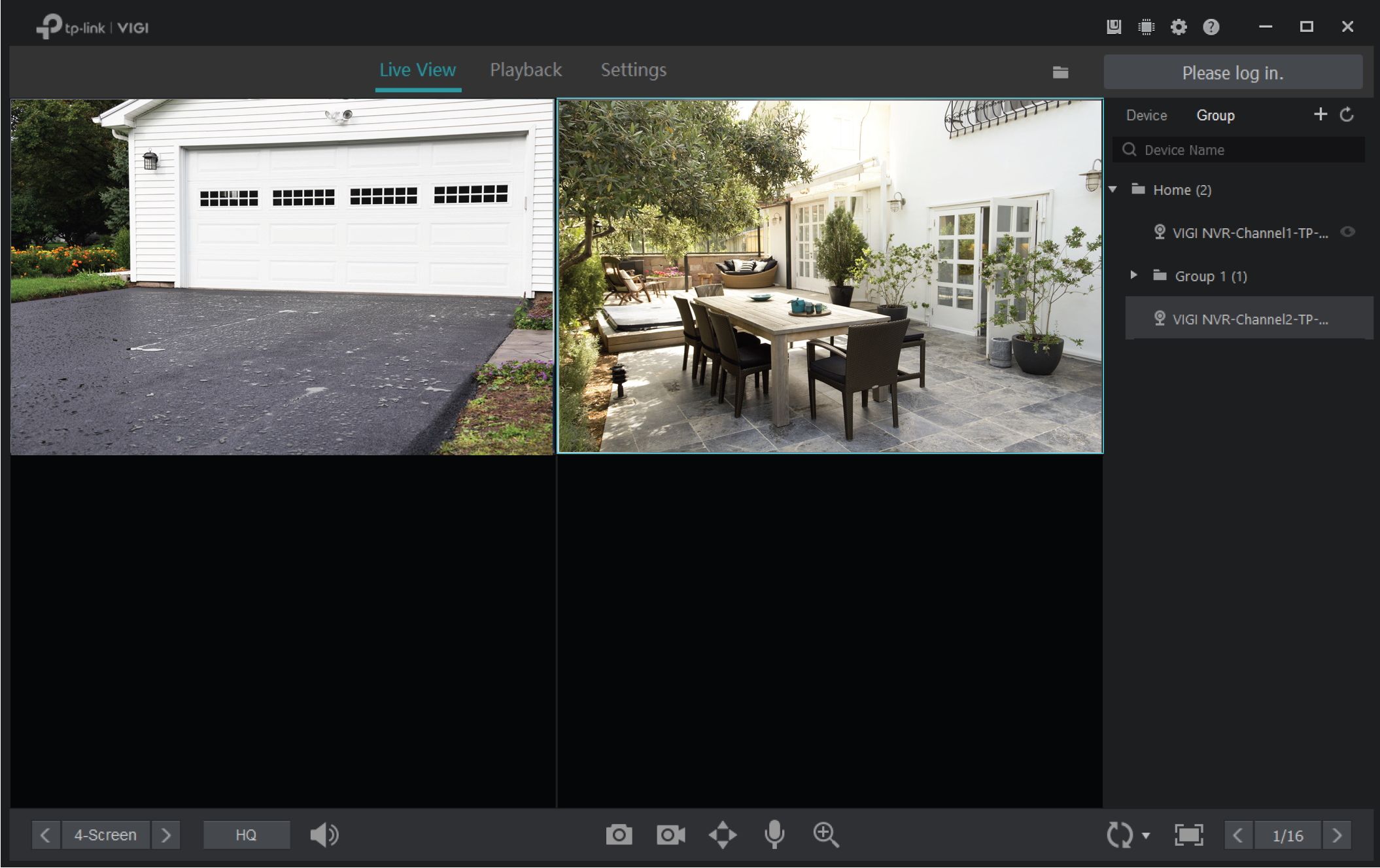

Click to switch between high quality (HQ) and low quality (LQ) for Live View.

(Only for certain cameras) Click to turn on or off the volume.



Click to take a screenshot. To show the screenshot in the folder, click E3 at the top right corner. To change the path where the screenshots are stored, refer to 6. 4 File Settings.
Click to start/end the recording manually. To show the recording in the folder, click B at the top right corner. To change the path where the recordings are stored, refer to 6. 4 File Settings.
(Only for the camera with Pan&Tilt) Click to enter the Preview of Pan&Tilt. You can adjust the camera location and call the presets.
32
Chapter 4
Live View

(Only for cameras with microphone) Click the icon and then hold d to talk. With this function, your can talk to people in the monitor area in real time.

SI

Click the icon to turn your cursor into a magnifying glass. To zoom in, scroll up the mouse wheel or left click on the screen. To zoom out, scroll down the mouse wheel or right click on the screen.
Click SI to start Switching, whereby the manager turns pages in Live View regularly if the channels are displayed in more than one page.
Click E3 to end Switching.
If you want to change the switching interval, click the triangle and then enter the value or drag the pointer.
Click to view the video in full screen,
4. 2. 2 Configure Live View Settings for a Single Camera
Right click a single camera on the right panel to configure the aspect ratio, delivery, stream and quality of its channel.
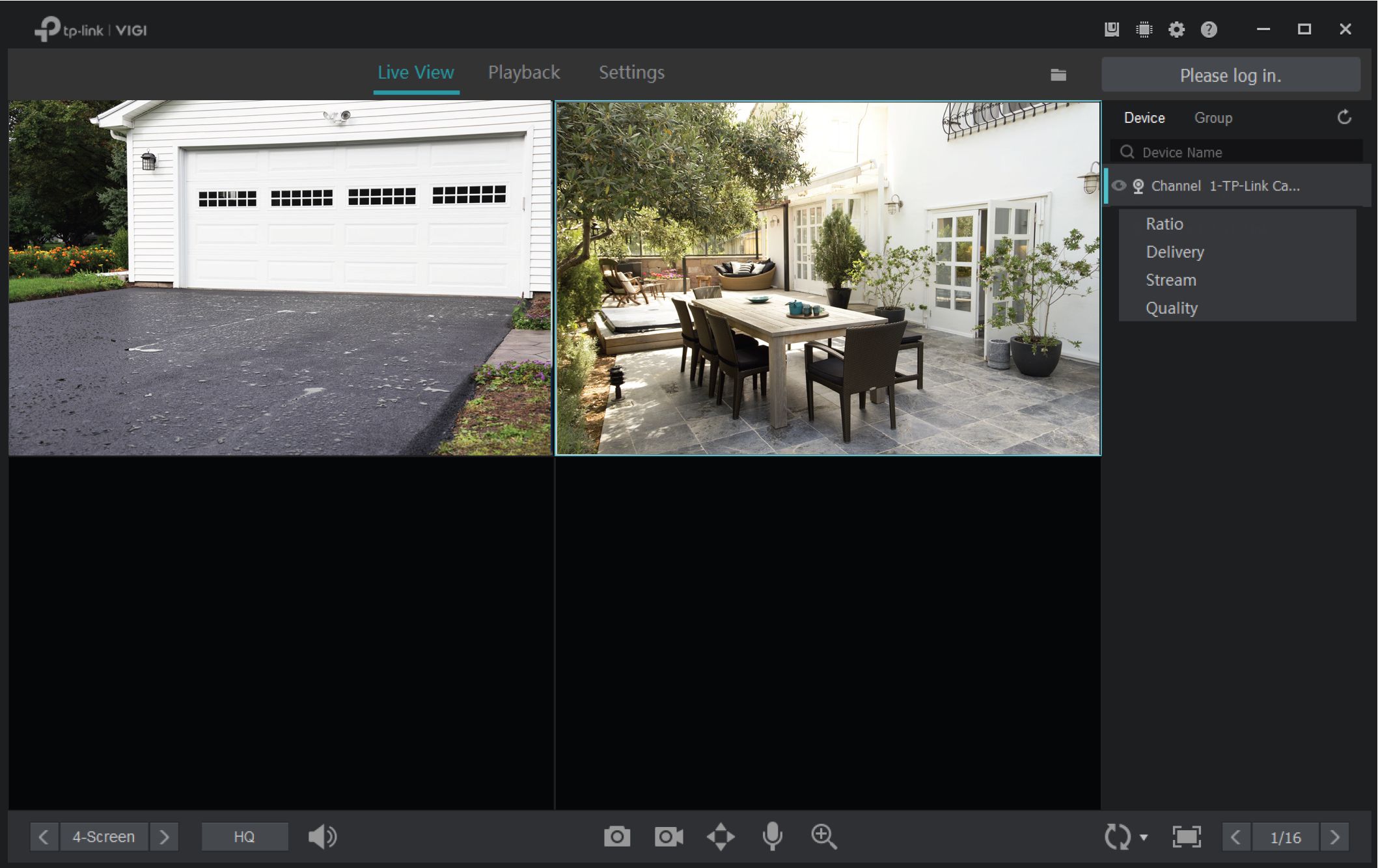
Ratio
Click to adjust aspect ratio. If you select 100%, the screen will automatically adjust the
ratio to fit the size of VIGI NVR Manager.
33
Chapter 4
Live View
| Delivery | Click to specify the channel as a unicast or multicast channel. For detailed configurations, refer to 7. 6. 5 Configure Multicast (Only for Cameras).
Click to apply mainstream or substream to this channel, which may influence the video |
| Stream | quality and fluency in Live View.
To view and configure Stream settings, refer to 7. 4. 1 Configure Stream Settings. |
| Quality | Click to change the video quality of Live View into high quality (HQ) or low quality (LQ). |
Main groups and subgroups are used to classify the channels for easier management. You can enable or disable Live View for channels in the group simultaneously.
Note: When enabling or disabling Live View based on groups, this operation is not applied to the subgroups.
Follow the steps below to add groups.
Add a Main Group
To add a group, click Group and then click E9 on the right panel. Enter the group name, select channels listed in Available Channels, and click Add. Click Up or Down to adjust the display order, or click Remove to remove the channel from the group. Click Confirm to add the main group.
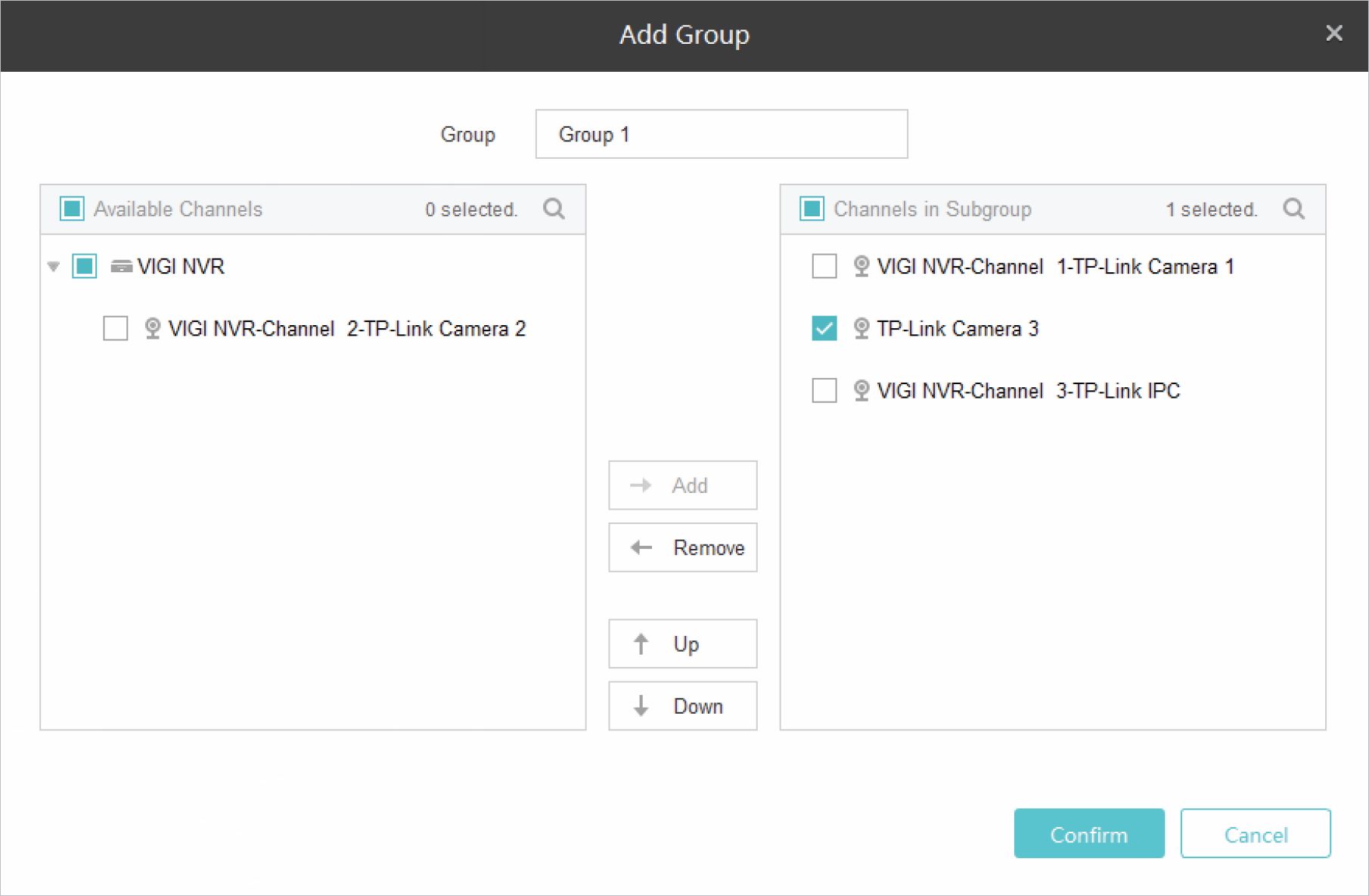
34
Chapter 4
Live View
Add a Subgroup
To add a subgroup, click Group and right click a group on the right panel. Click Add Subgroup and enter the name. Then, you can drag the channel in the main group to the subgroup.
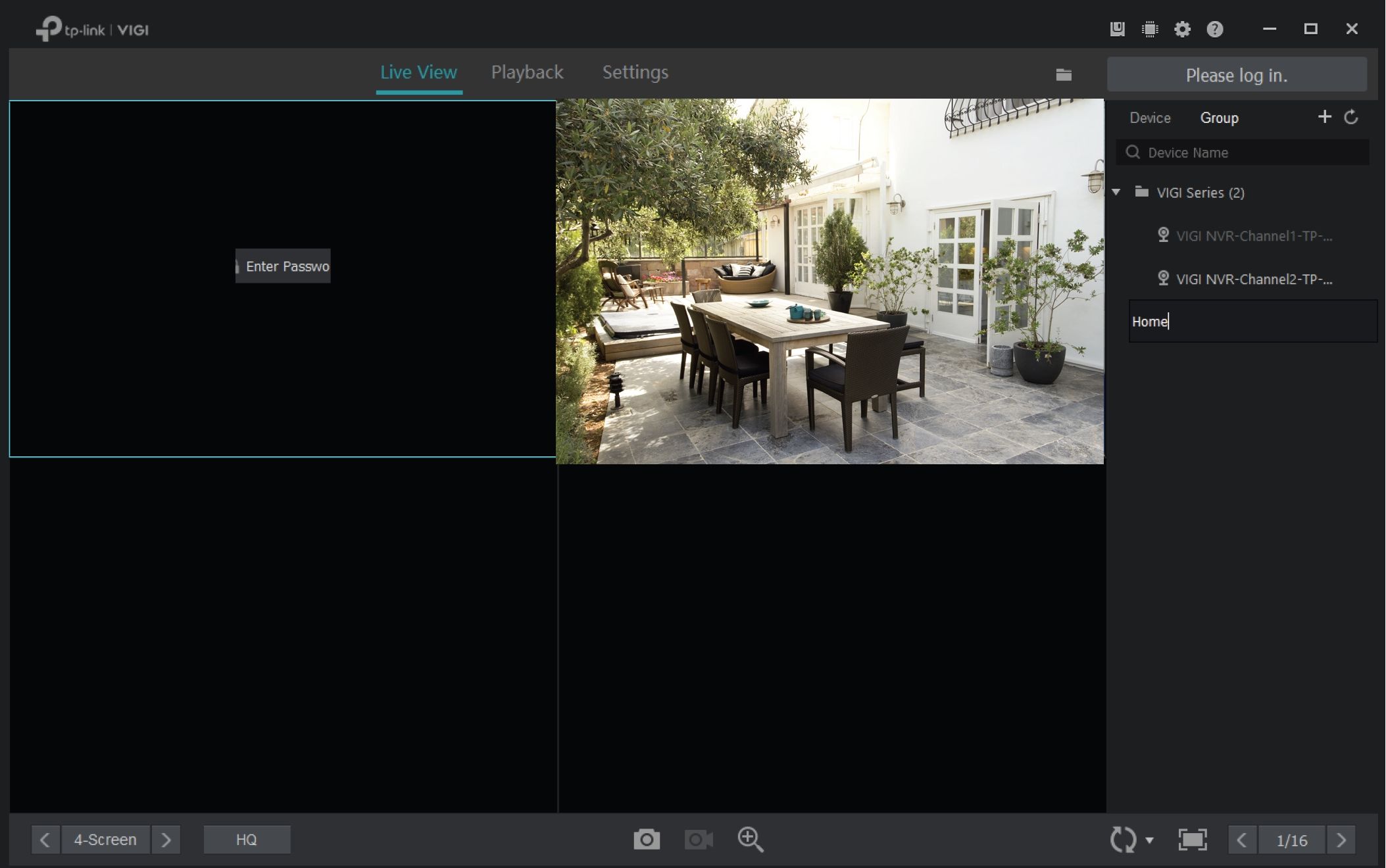
Manage Channels in the Group
To move a single channel to other groups or change its order in the list, drag the channel and move it.
35
Chapter 4
Live View
To manage the channels, click Group and right click a group on the right panel. Click Manage Group Channels. Select the channels to add, remove or reorder them in the group. Click Confirm.
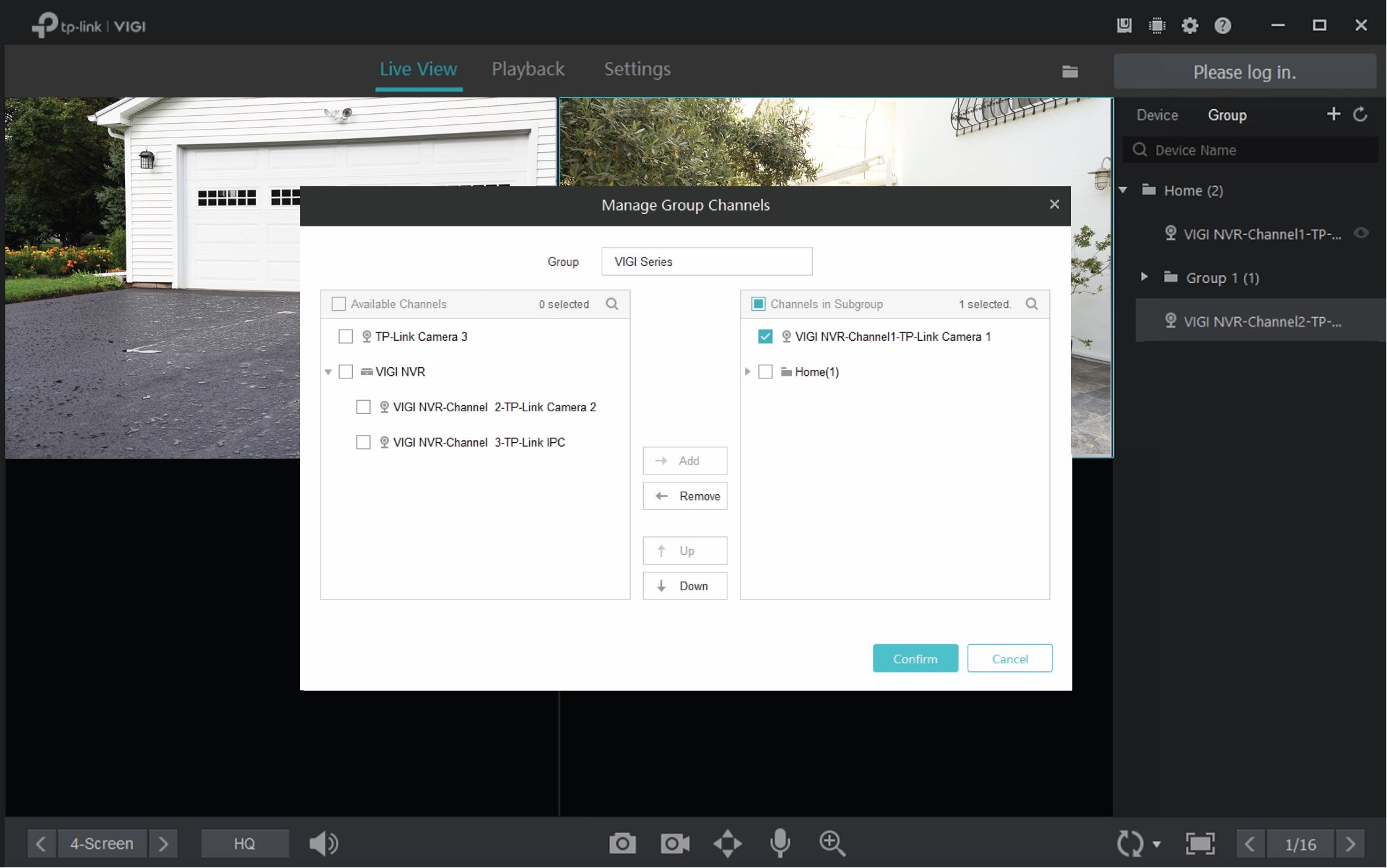
36
Chapter 4
Live View
Rename the Group
To rename a group, click Group and right click the group on the right panel. Click Rename and enter the name.
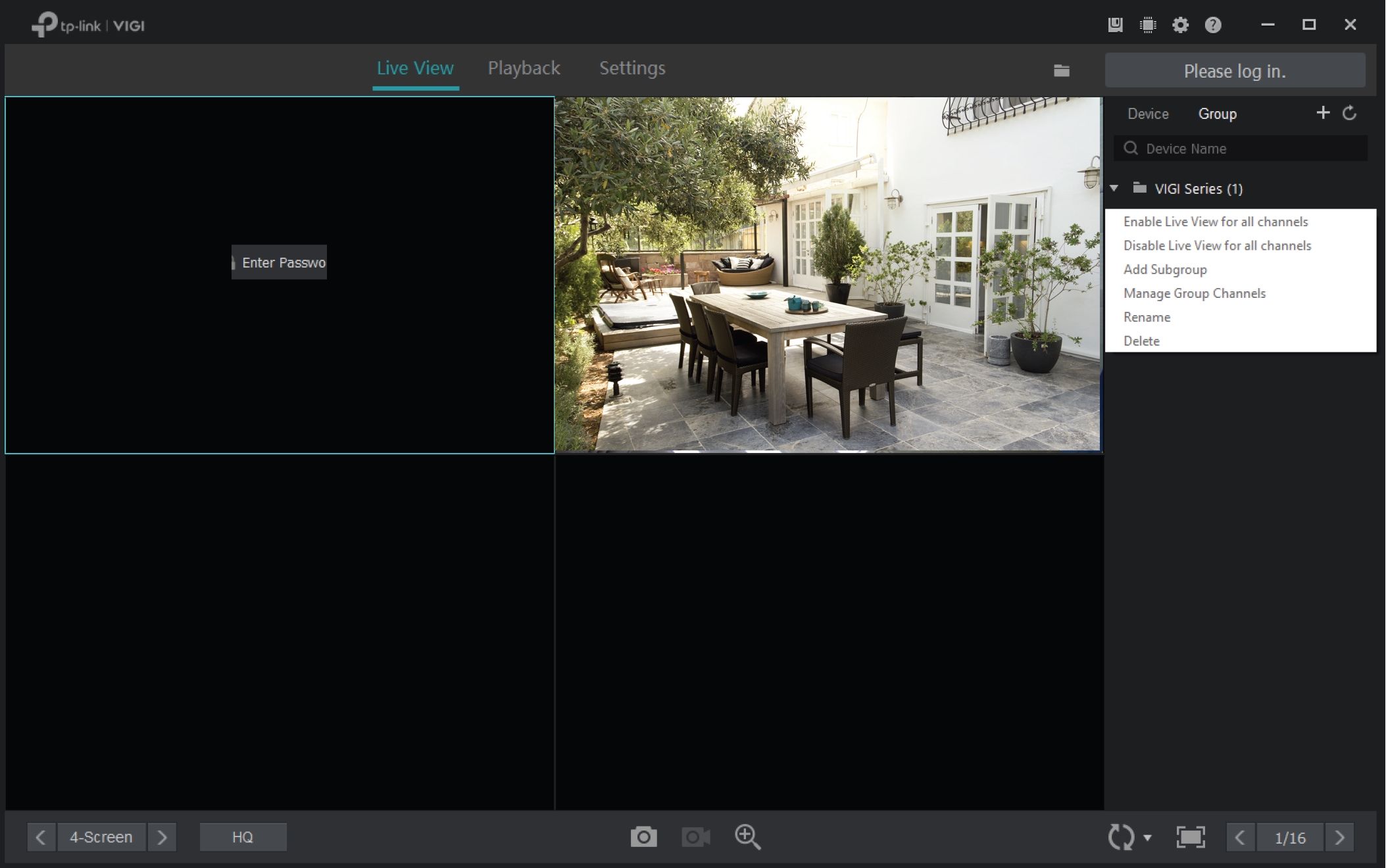
Delete the Group
To delete a group, click Group and right click the group on the right panel. Click Delete.
37
Playback
This function allows you to play the history recordings and edit them, such as taking schreenshots and exporting clips. You can easily find the recordings based on the channel, date, and recording types. This chapter contains the following sections:
Chapter 5
Playback
V 5. 1 Playback the Recordings
Follow the steps below to start playback.
- Click Playback on the top, and then click an NVR to select the channels from the right panel. Click Apply.
Note: All the cameras managed by VIGI Security Manager directly are listed under the virtual NVR, and you can play the recordings of them only when the host manages them locally.
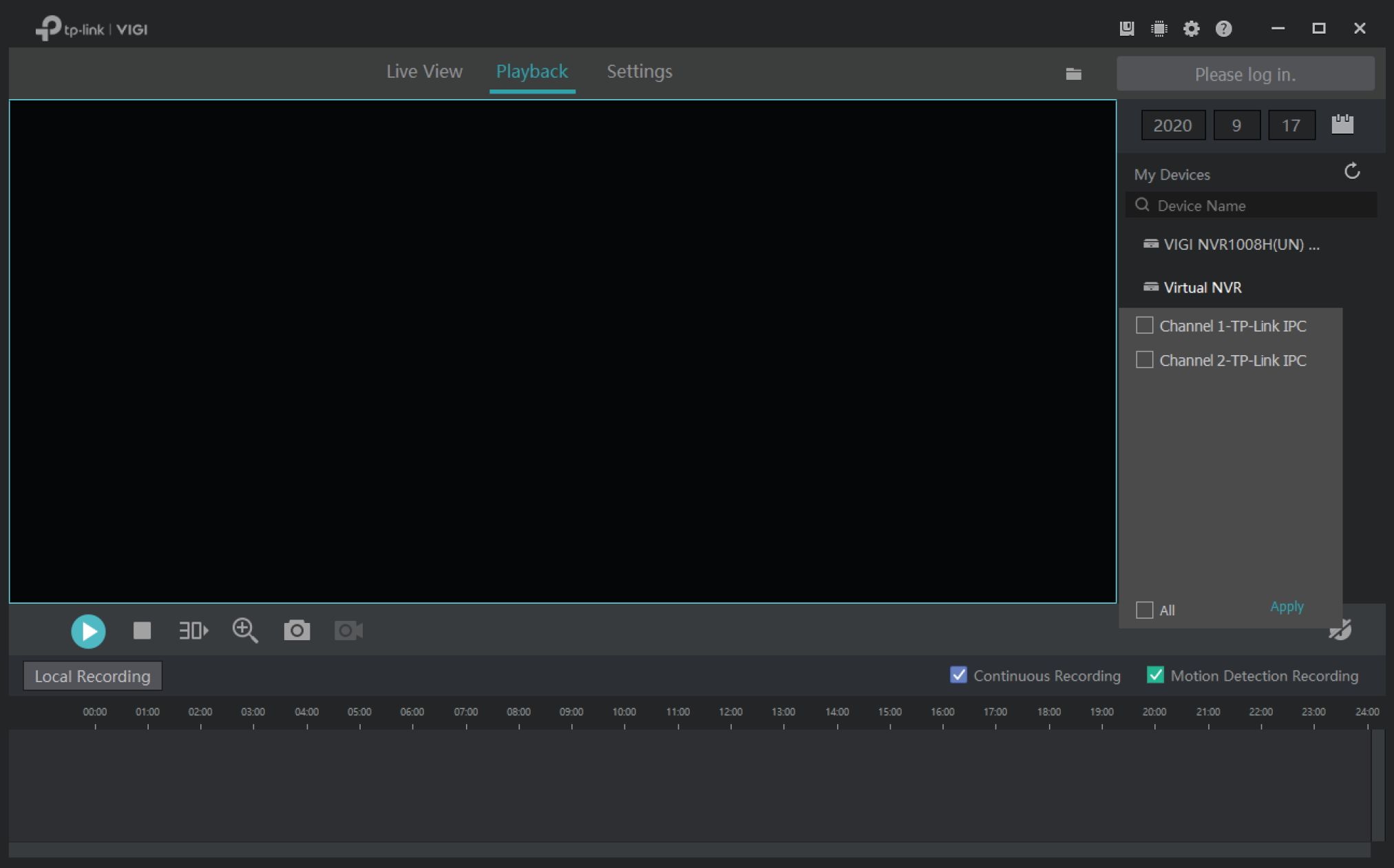
39
Chapter 5
Playback
- Select the date from the calendar. The blue points on the calendar mean that the channels have recordings on that day.
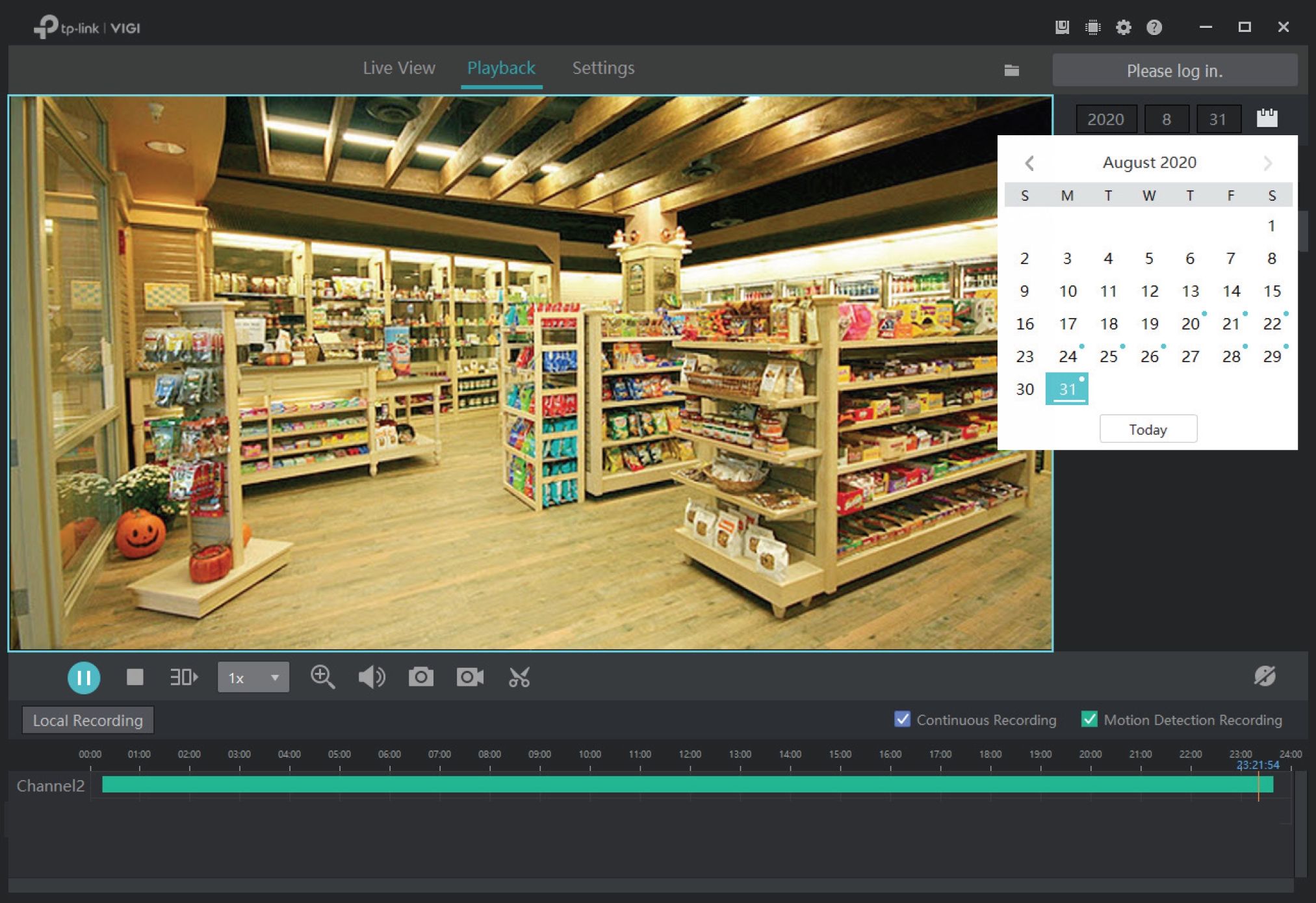
- (Optional) Select the recording types by clicking the checkboxes of Continuous Recording and Motion Detection Recordings.
In Playback, you can use the toolbar and time bar at the bottom to adjust the display, edit and export the recordings.
40
Chapter 5
Playback
5. 2. 1 Basic Playback Operations
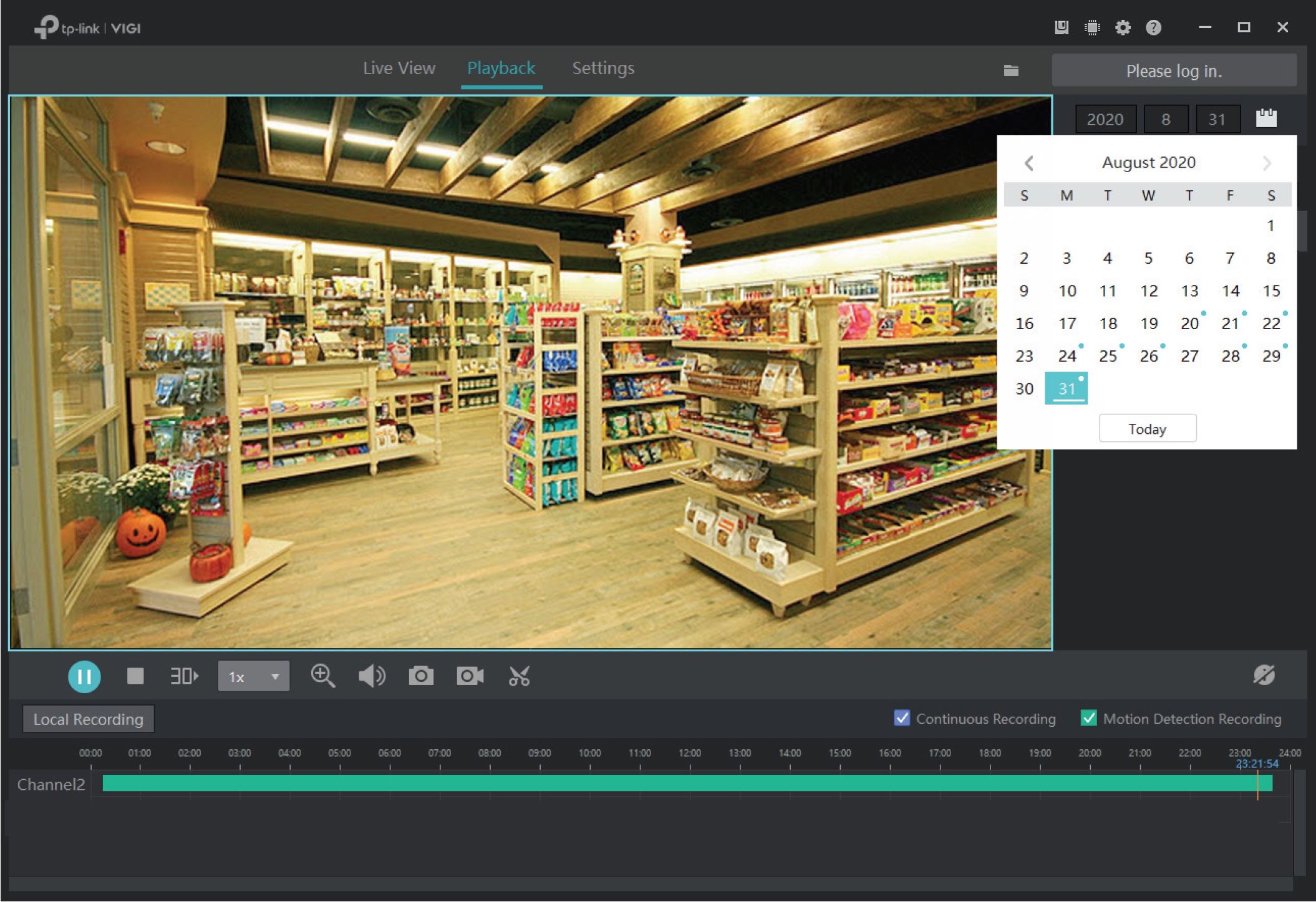
n Click to rewind the recording. Click again to stop.
02 Click to fast forward the recordings. Click again to stop.




Jump forward by 30 seconds.
Select from the drop-down list to change the playing speed.
a
Click the icon to turn your cursor into a magnifying glass. Scroll up/down the
mouse wheel on the screen to zoom in/out.
Click to turn on or off the volume.
0
Click to take a screenshot. To open the saved path, click E3 at the top right
corner. To change the saved path, refer to 6. 4 File Settings.
Click to start/end the recording manually. To open the saved path, click E3
at the top right corner. To change the saved path, refer to 6. 4 File Settings.
41
Chapter 5
Playback
□
Click to display/hide the channel number in Playback.
Follow the steps below to clip video files.
1. In Playback, specify a channel and date to list the recordings in the time bar. Click £3.
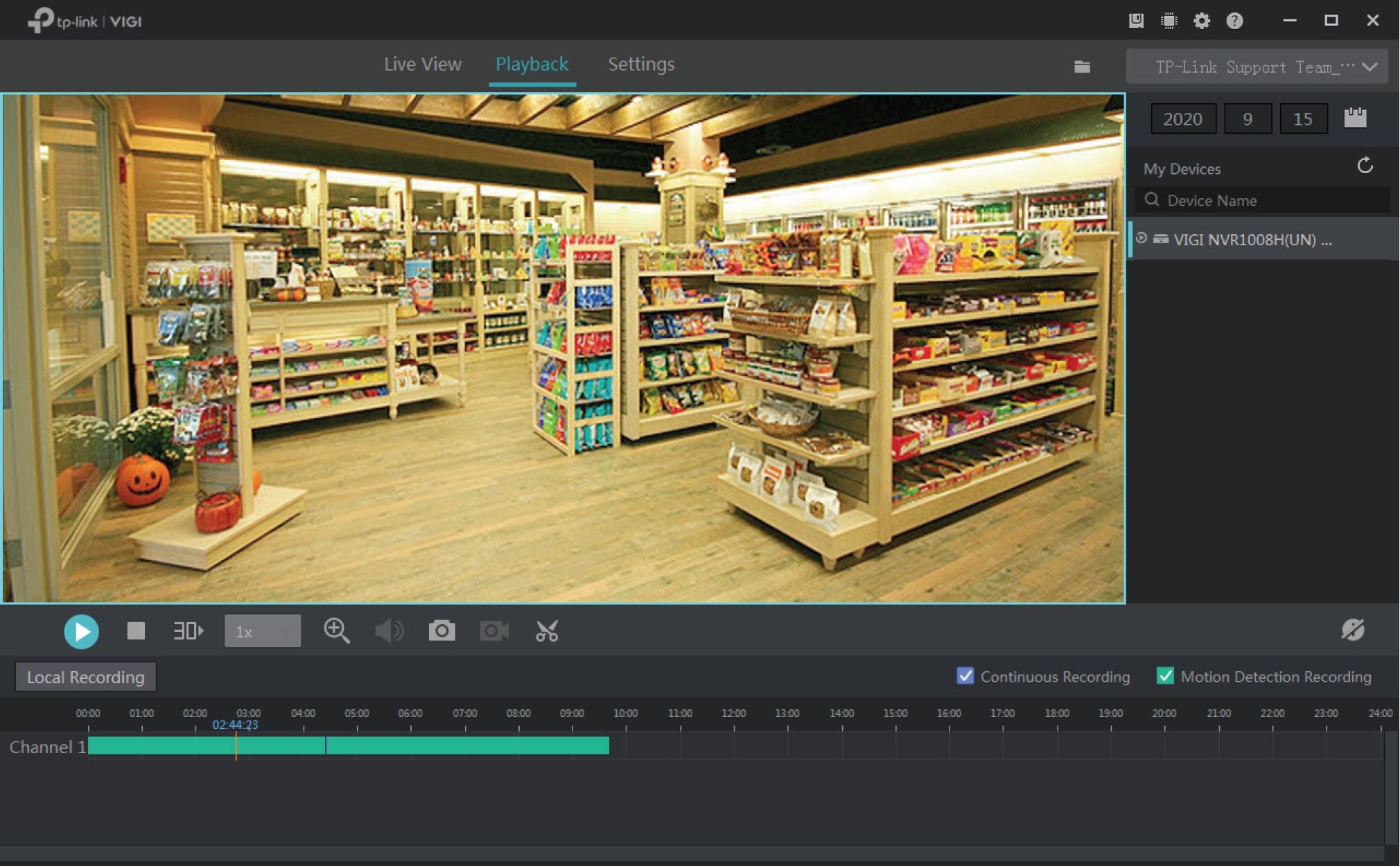
42
Chapter 5
Playback
2. Move on the time bar, or enter the start time and end time below to adjust the recording length. On the time bar, scroll up or down the mouse wheel to expand or contract the time line. Click Export.
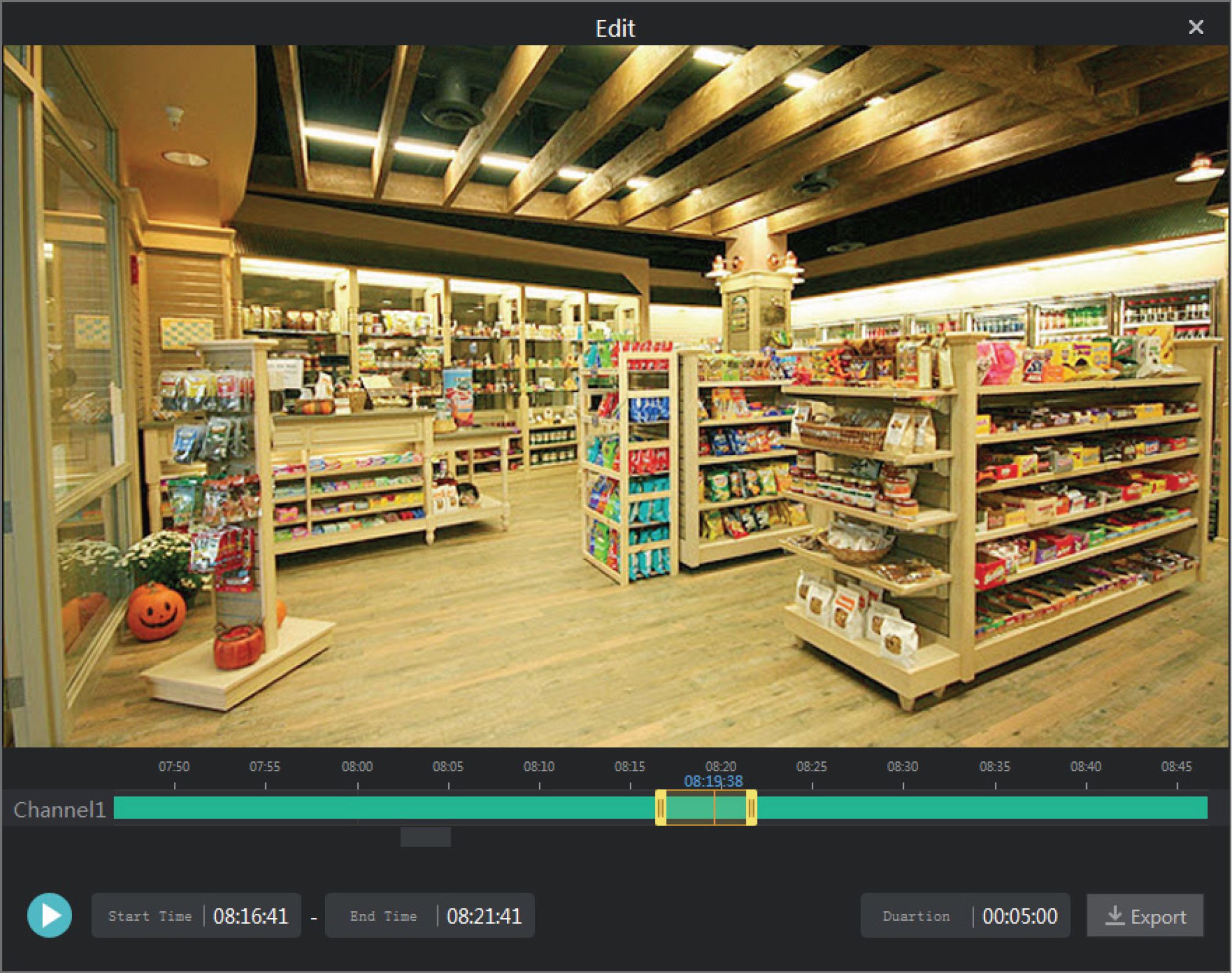
43
Chapter 5
Playback
3. Select an export format and click Export.
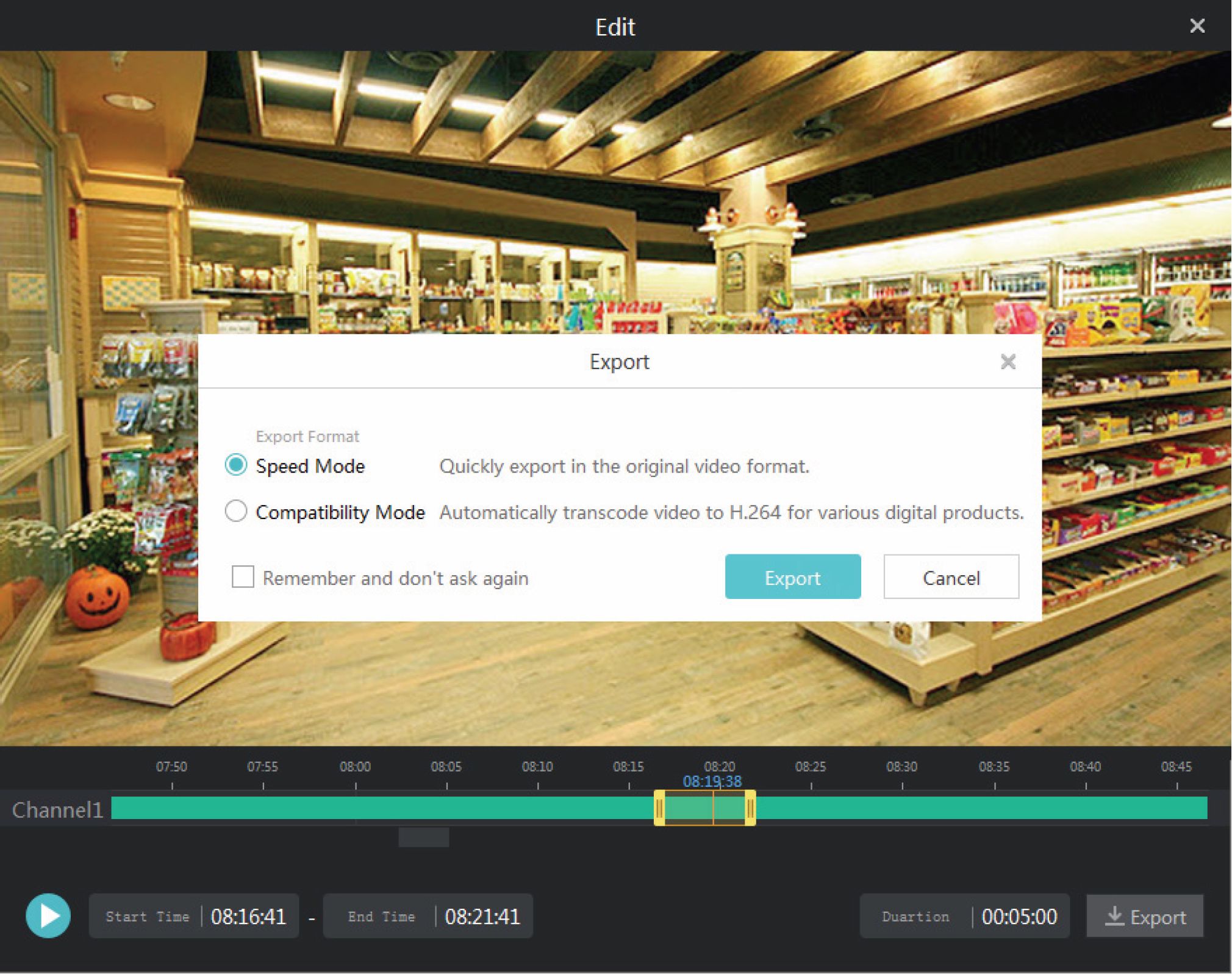
Note: This window will not pop up if you click Remember and don’t ask again or set the export format in Settings. For details, refer to 6. 5 Export Format.
44
This chapter guides you on how to export recordings and configure recording and storage settings for your cameras. VIGI Security Manager allows you to set recording schedule templates and apply these templates to different cameras. You can also check and configure the storage settings for recordings and exported files. This chapter includes the following sections:
- Arrange Schedules for a Single Camera
- Storage Management
- Export Recordings
- File Settings
- Export Format
Chapter 6
Recording and Storage
6. 1 Arrange Schedules for a Single Camera
Storage schedule section provides convenience and flexibility for the daily monitoring of your devices. You can enable and customize the recording schedule and storage settings for a single camera. Go to Settings > Storage Schedule to modify these settings.
Note: If you have logged in to your TP-Link ID, you can not arrange schedules for cameras. To modify these settings, log out of your TP-Link ID and manage devices locally.
Schedule
Filter Qİ Batch Operation Pi Edit Schedule Ö Refresh
TP-Link Camera 3
® Record on Computer
24/7 Recording
Recording…
Record on Computer: Displays the cameras whose recordings are stored in the computer.
Filter
Record on SD Card: Displays the cameras whose recordings are stored in the SD card.
Qİ Batch Operation
Enable/Disable record on your computer for all cameras.
Edit Schedule
Click to edit schedule templates for recording.
Refresh
Click to refresh the camera list.
6. 1. 1 Customize Schedule Template
Recording schedules include 4 fixed templates and 4 custom templates. In Storage Schedule, click (Z Edit Schedule on the top right to enter Edit Schedule Template.
46
Chapter 6
Recording and Storage
■ 24/7 Recording
24/7 Recording allows your camera to record continuously all the time.
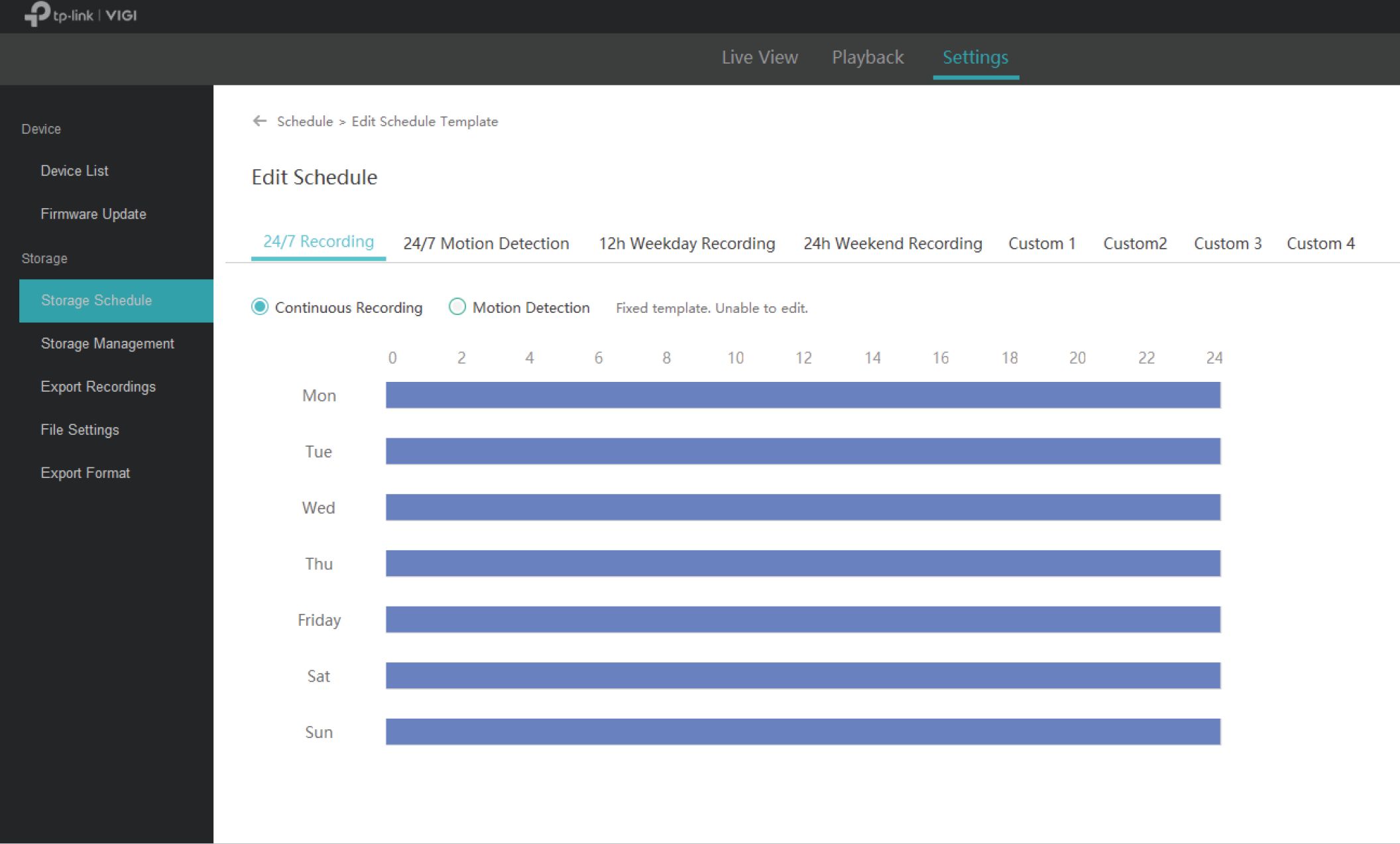
■ 24/7 Motion Detection
24/7 Motion Detection allows your camera to record when motion detection is triggered.
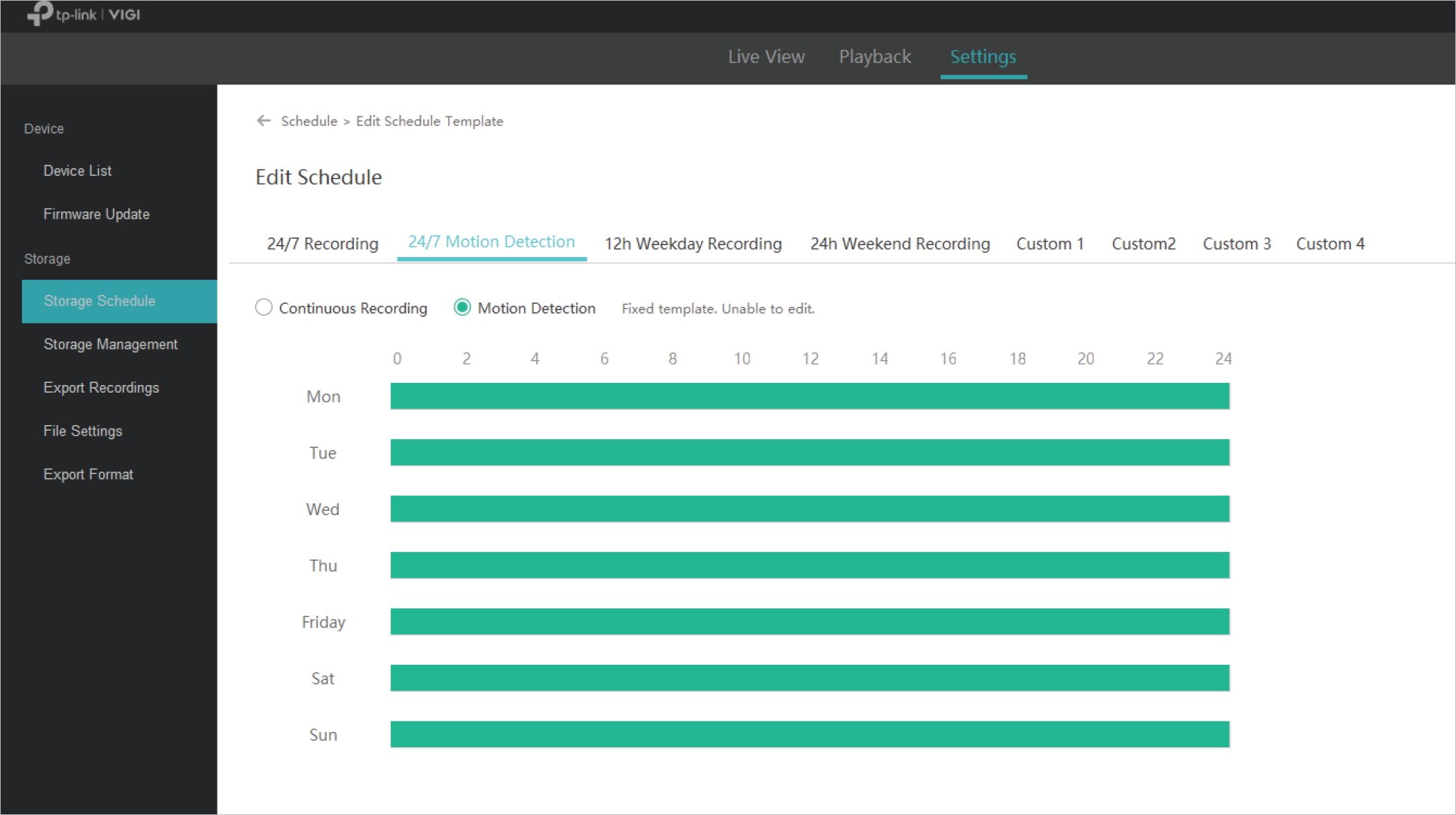
47
Chapter 6
Recording and Storage
■ 12h Weekday Recording
12h Weekday Recording allows your camera to record continuously from 8:00 to 20:00 on weekdays.
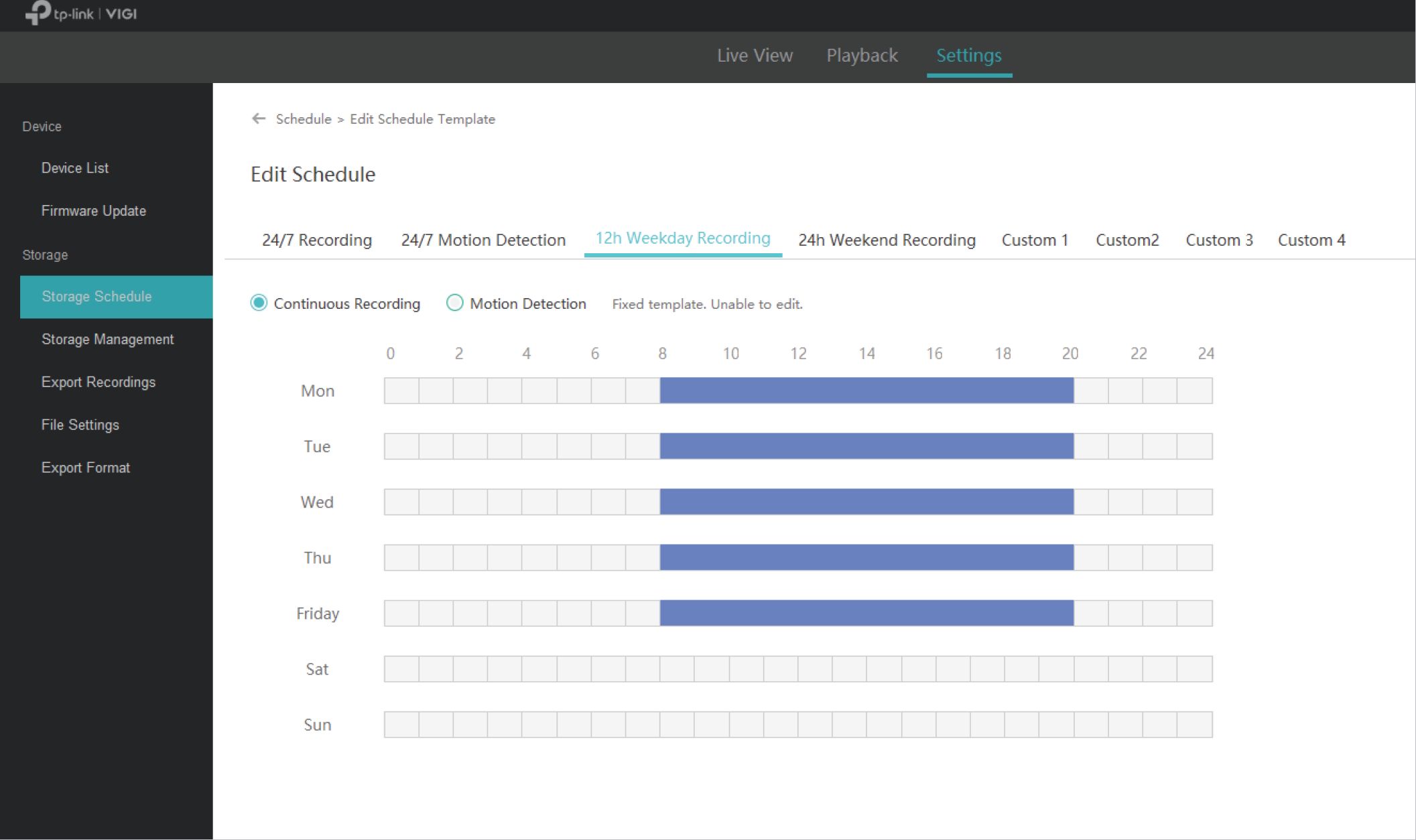
■ 24h Weekend Recording
24h Weekend Recording allows your camera to record continuously all day on weekends.
J tp-link I VIGI
Live View Playback Settings
Device
Schedule > Edit Schedule Template
Device List
Edit Schedule
Firmware Update
Storage
24/7 Recording 24/7 Motion Detection 12h Weekday Recording 24h Weekend Recording Custom 1 Custom2 Custom 3 Custom 4
Storage Schedule
@ Continuous Recording O Motion Detection Fixed template. Unable to edit,
Storage Management
Export Recordings
Mon
File Settings
Tue
Export Format
Wed
Thu
Friday
Sat
Sun

48
Chapter 6
Recording and Storage
■ Custom Schedule
You can customize the recording schedule according to your needs. For example, the camera will record based on a schedule of motion detection from 5:00-16:00 on weekdays; On weekends, the camera will record continuously from 1:30-23:00. Follow the steps below to finish the configuration.
- Select a custom template (custom 1).
- Click Motion Detection and drag the cursor on time bar to set 5:00 to 16:00 for continuous recording from Monday to Friday. The color of these rectangles will be changed to green.
- Select Continuous Recording and drag the cursor to set 1:30 to 23:00 for motion detection recording on Saturday and Sunday. The color of these rectangles will be changed to blue. To enter the start and end time manually, click the time bar to select a rectangle first, then click the rectangle again.
- Click Save.
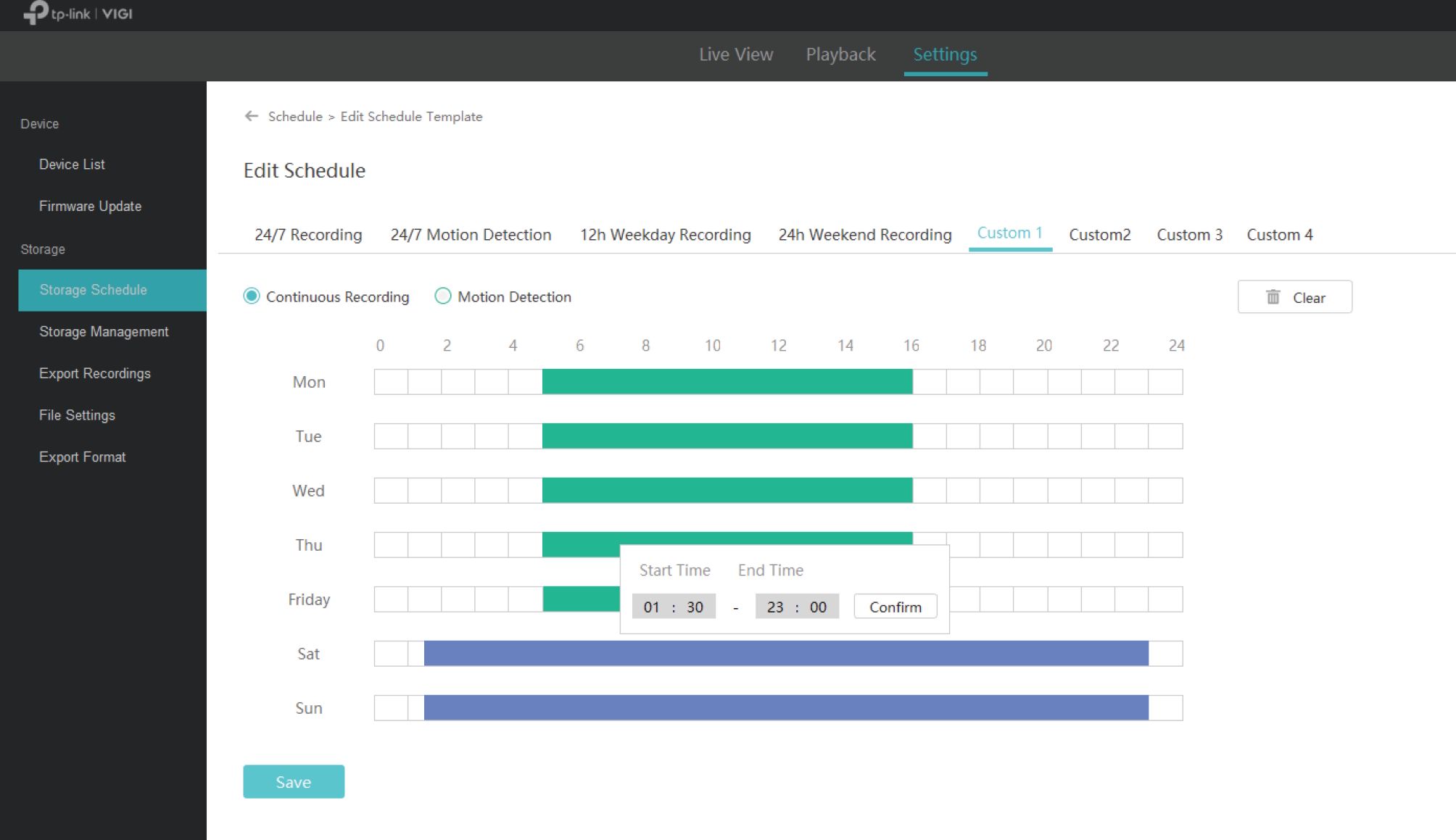
If you have not enabled recording function when adding the camera to VIGI Security Manager, follow the steps below to configure the storage settings. If you have already enabled this function, you can skip this section.
49
Chapter 6
Recording and Storage
1.
Click the camera you want from the list.
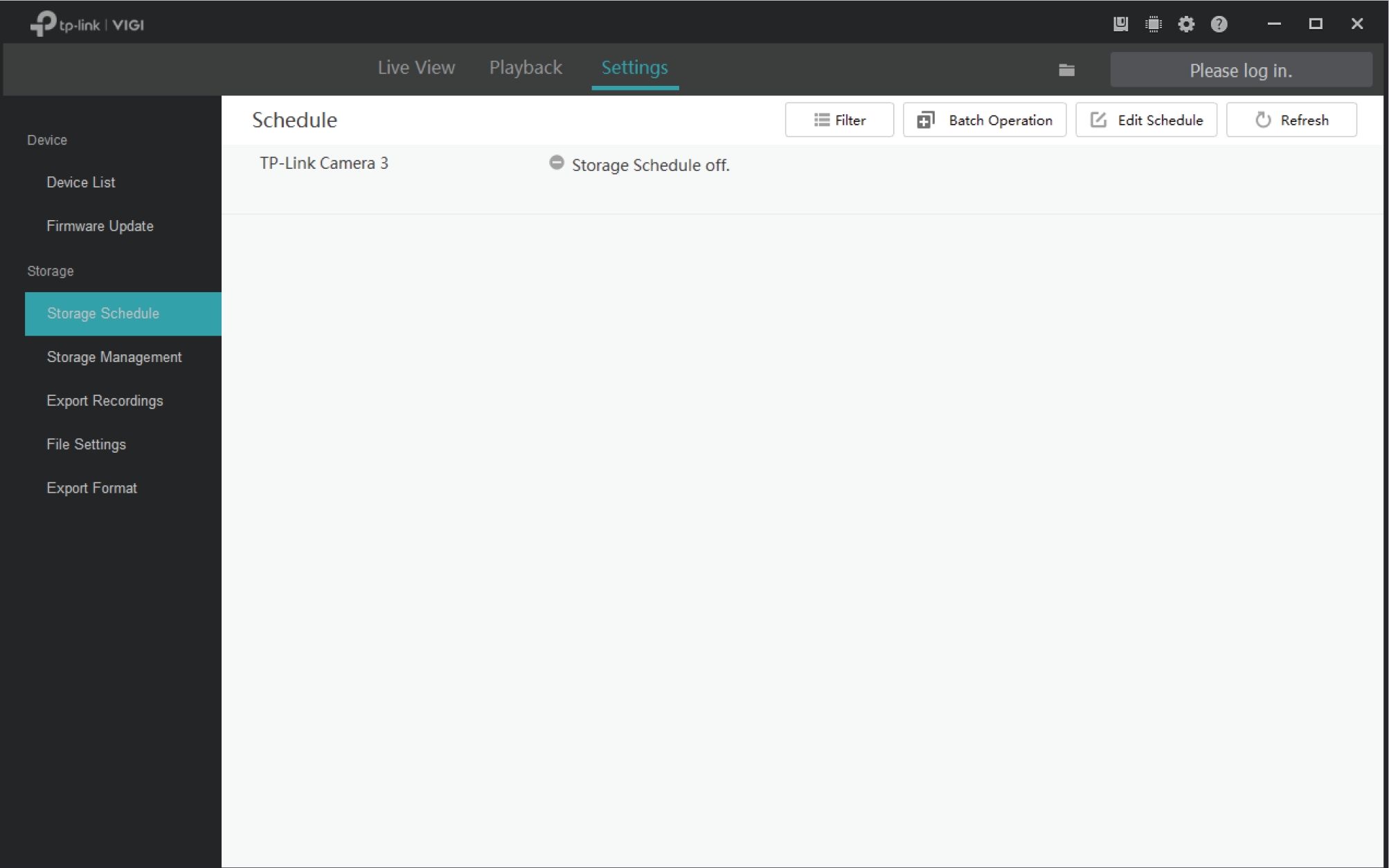
2.
Click Enable Record on computer to configure storage settings.
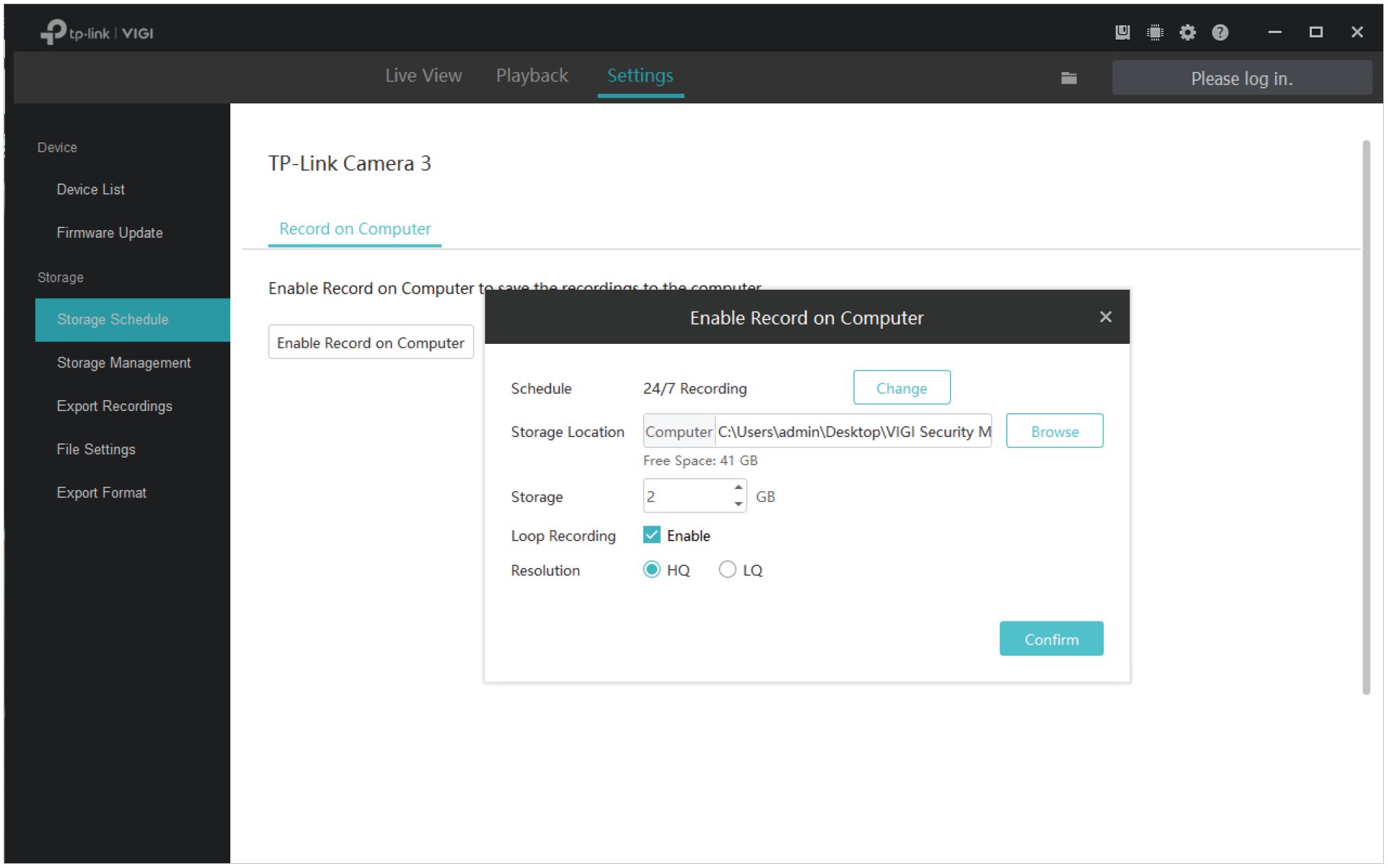
50
Chapter 6 Recording and Storage
3. Set the storage and recording settings.
| Schedule | Click 1 Change 1 to customize the recording schedule of the camera on computer. |
| Storage Location | Click Browse to select the storage location of files. |
| Storage | Set the storage space for storing the recordings on your computer. |
| Enable Loop Recording | Click the checkbox to enable loop recording. |
| Resolution | Select the recording resolution. HQ and LQ refers to the high and low recording resolution respectively. |
4. Click Confirm.
You can check storage settings and apply the schedule templates to the cameras directly added to VIGI Security Manager.
Note: The recording schedule of camera set on VIGI Security Manager will not be synchronized if you add this camera to your NVR later.
To apply the recording schedule to the camera, follow the steps below:
- Go to Settings > Storage Schedule, and click the camera you want to configure.
- Enable Record on Computer.
- Click i: u-» Template to select the schedule template according to your needs.
Note: Only the cameras supporting motion detection function can apply the schedule of motion detection.
| Storage Location | Displays the location where recordings are stored.
Click Browse to check the storage location of files. |
| Storage | Displays the assigned capacity for storing camera recordings.
Click Clear Recordings to delete all the recordings stored on your computer. |
| Enable Loop Recording | Displays the status of loop recording. |
| Resolution | Select the recording resolution. HQ and LQ refers to the high and low recording resolution respectively. |
51
Chapter 6
Recording and Storage
5. Click Save.
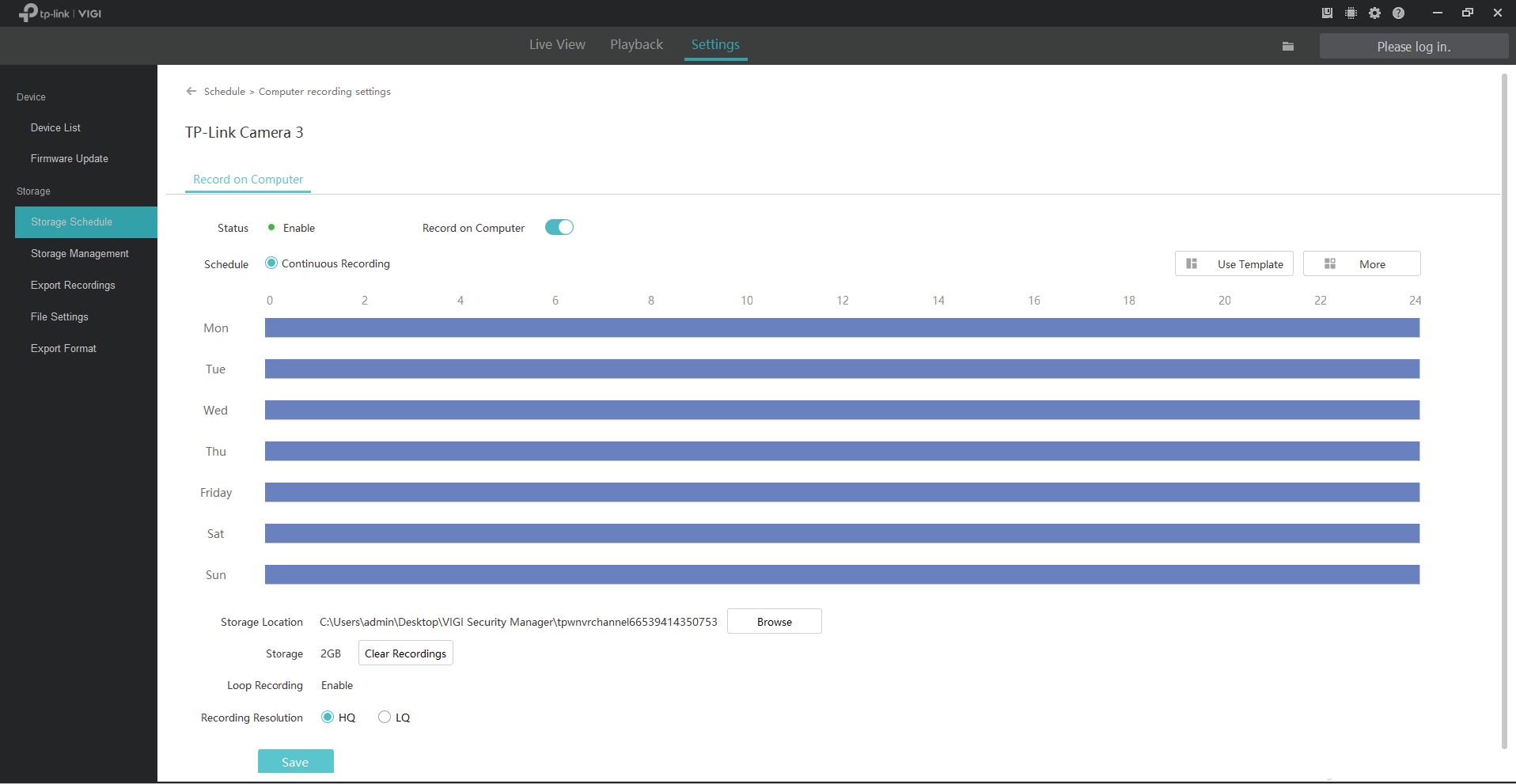
52
Chapter 6
Recording and Storage
To check the storage settings of your cameras directly added to VIGI Security Manager, go to Settings
> Storage Management.
Note: If you have logged in to your TP-Link ID, you can not modify storage settings. To modify these settings, log out of your TP-Link ID and manage devices locally.
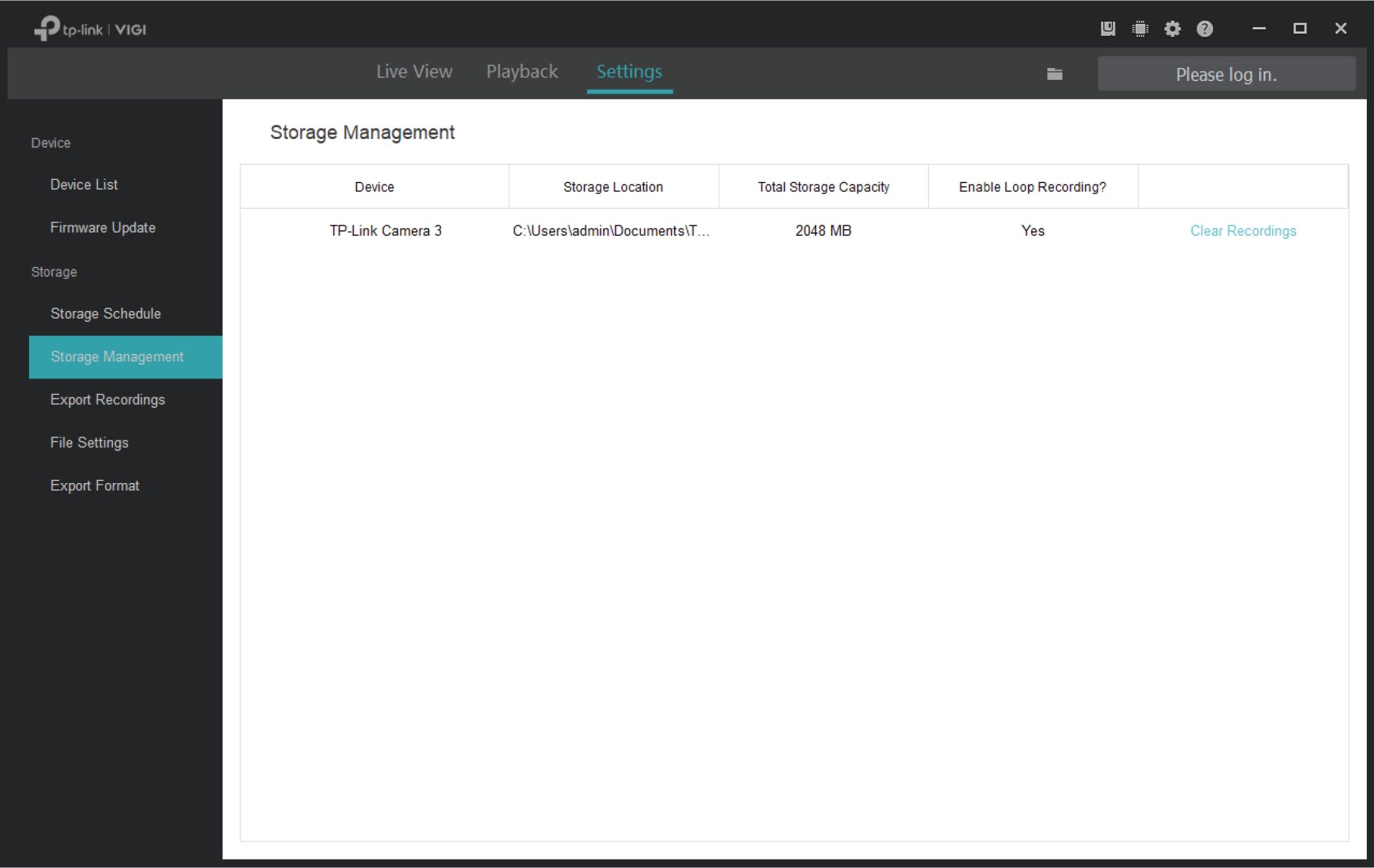
| Device | Displays the name of camera. |
| Storage Location | Displays the location where recordings are stored. |
| Total Storage Capacity | Displays the capacity for storing recordings. |
| Enable Loop Recording | Displays the status of loop recording. |
| Clear Recording | Click to delete all the recordings stored on your computer. |
To export the recordings of the NVR and cameras according to your needs, go to Settings > Storage > Export Recordings and follow the steps below.
Note: If you have logged in to your TP-Link ID, you can not export recordings. To export recordings, log out of your TP-Link ID and manage devices locally.
53
Chapter 6
Recording and Storage
■ Export Recordings From NVR
1. Select the NVR you want and specify the channel from the drop-down list, select date and recording type, then click Search to filter files.


0 file(s) selected B Export 03 Export All
| □ | No. | Device | Channel | Start Time | End Time | Recording Type | File Size |
| □ | 1 | VIGI NVR | Channel? | 2020-08-26 23:50:33 | 2020-08-26 23:50:37 | Continuous Recording | 228.18KB |
| □ | 2 | VIGI NVR | Channel? | 2020-08-26 23:50:37 | 2020-08-27 08:58:32 | Motion Detection | 885.65MB |
| □ | 3 | VIGI NVR | Channel | 2020-08-27 08:58:3? | 2020-08-27 08:59:56 | Motion Detection | 2.95MB |
| □ | 4 | VIGI NVR | Channel? | 2020-08-27 08:59:56 | 2020-08-27 16:58:46 | Motion Detection | 1004.44MB |
| □ | 5 | VIGI NVR | Channel? | 2020-08-27 16:58:46 | 2020-08-27 21:22:49 | Motion Detection | 546.51MB |
| □ | 6 | VIGI NVR | Channel? | 2020-08-27 23:14:?5 | 2020-08-27 23:23:35 | Motion Detection | 16.26MB |
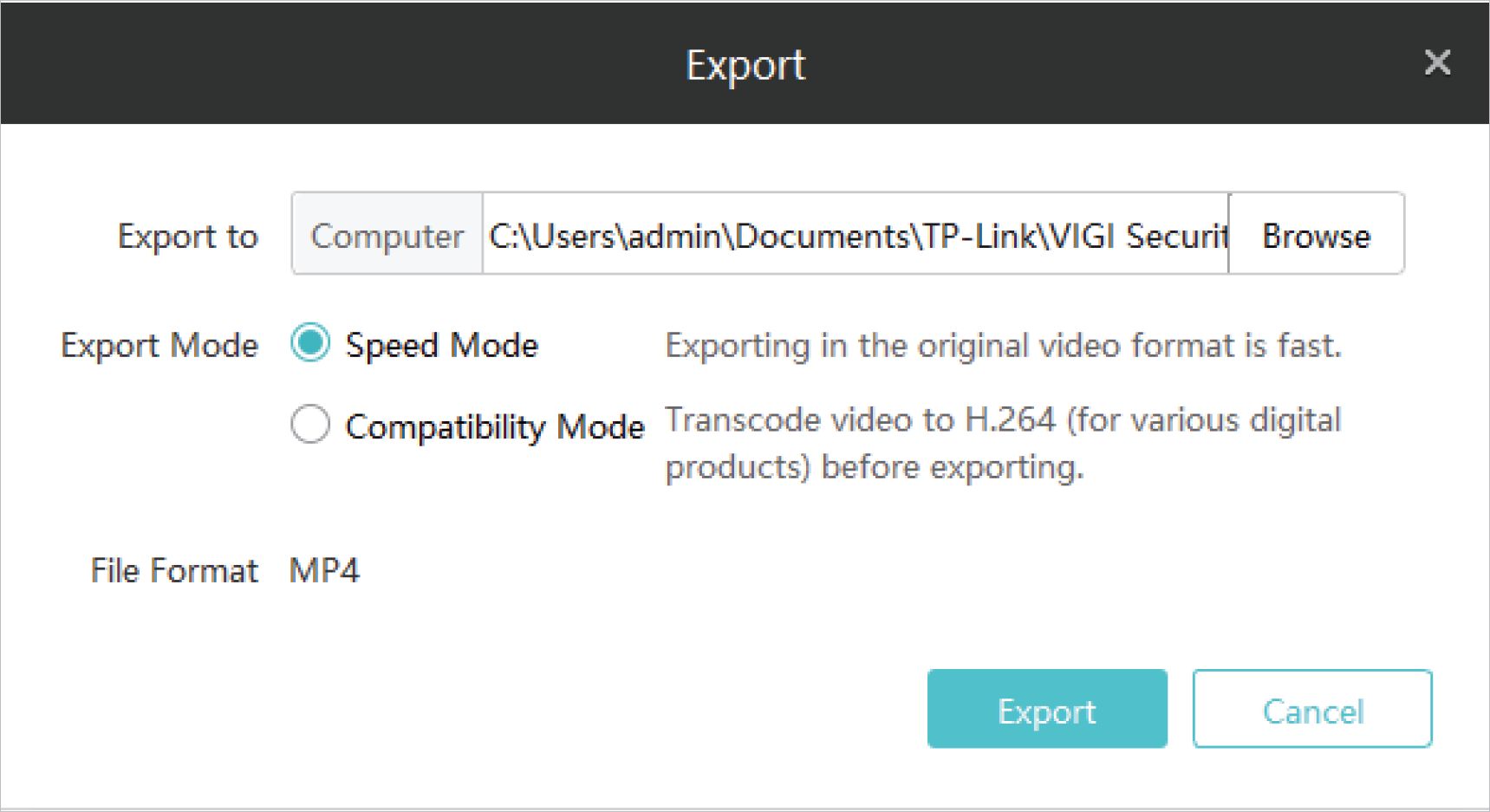
Speed Mode: The export process is faster than that of compatibility mode.
54
Chapter 6
Recording and Storage
Compatibility Mode: The exported recordings will be transcoded to H.264 which is compatible with various digital products.
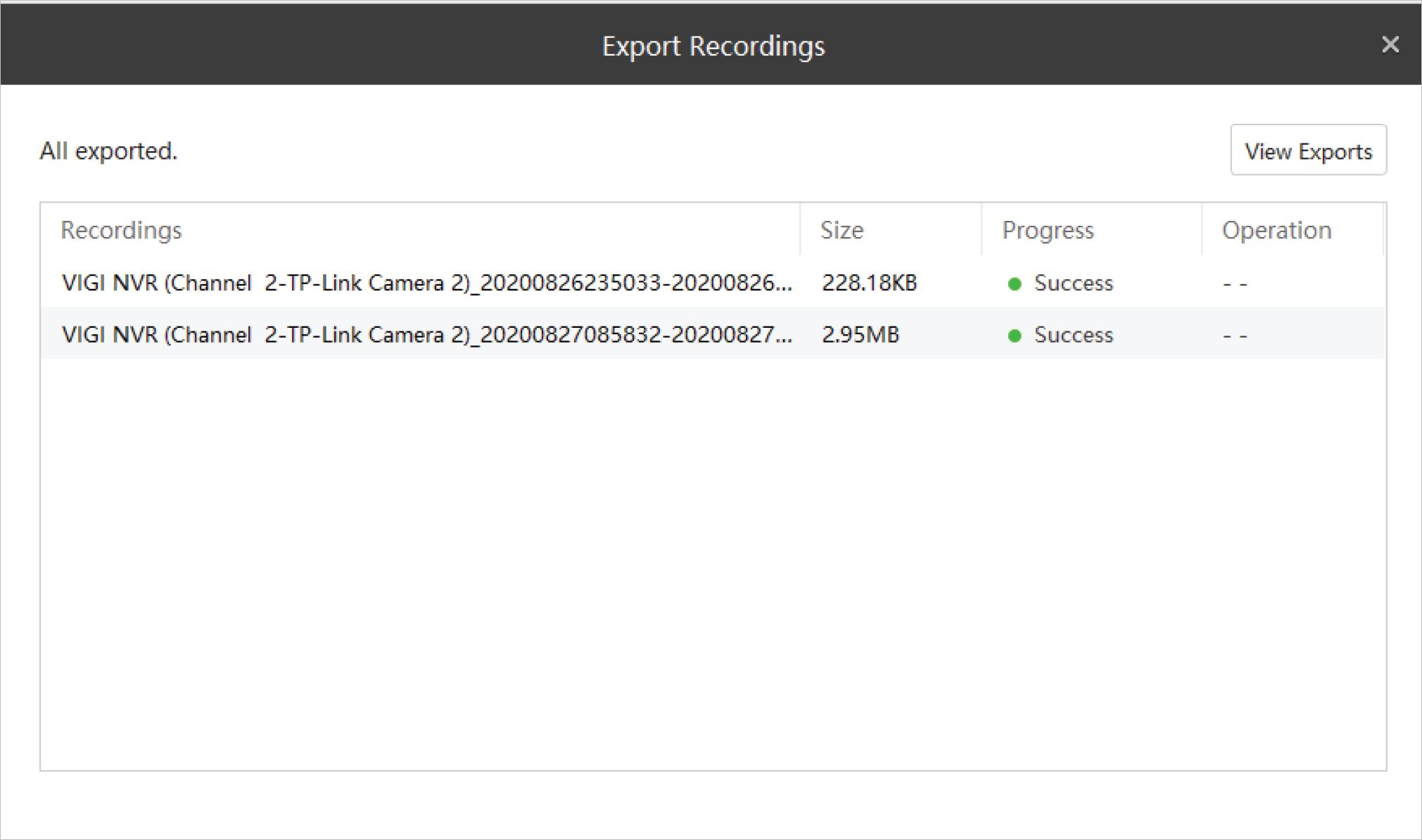
■ Export Recordings From Camera
1. Select the camera you want and the recording source from the drop-down list, select date and recording type, then click Search to filter files.
,Op -link I VIGI
IEJ
Device
Device List
Firmware Update
Storage
Storage Schedule
Storage Management
Export Recordings
Live View Playback Settings
Please log in.
Export Recordings

End Time
$ O
□ X
55
Chapter 6
Recording and Storage
2.
Select the recording files you want to export and click E Export .

Click Browse to select the folder on your computer to store the exported files.
3.
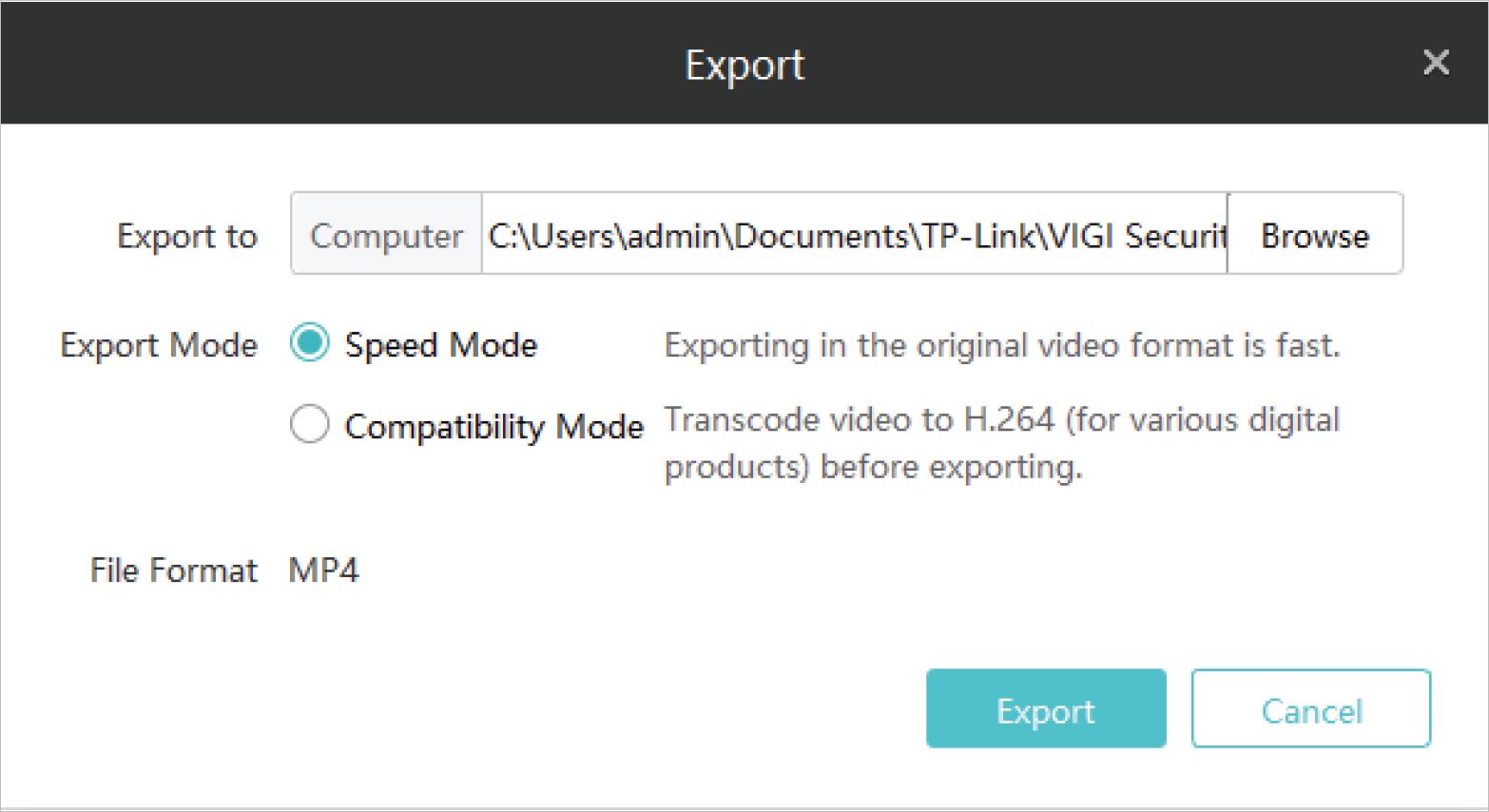
4.
Select the export mode.
Speed Mode: The export process is faster than that of compatibility mode.
Compatibility Mode: Transcode the exported recordings to H.264 which is compatible with
various digital products.
56
Chapter 6
Recording and Storage
5. Click Export, and the files will be successfully exported.
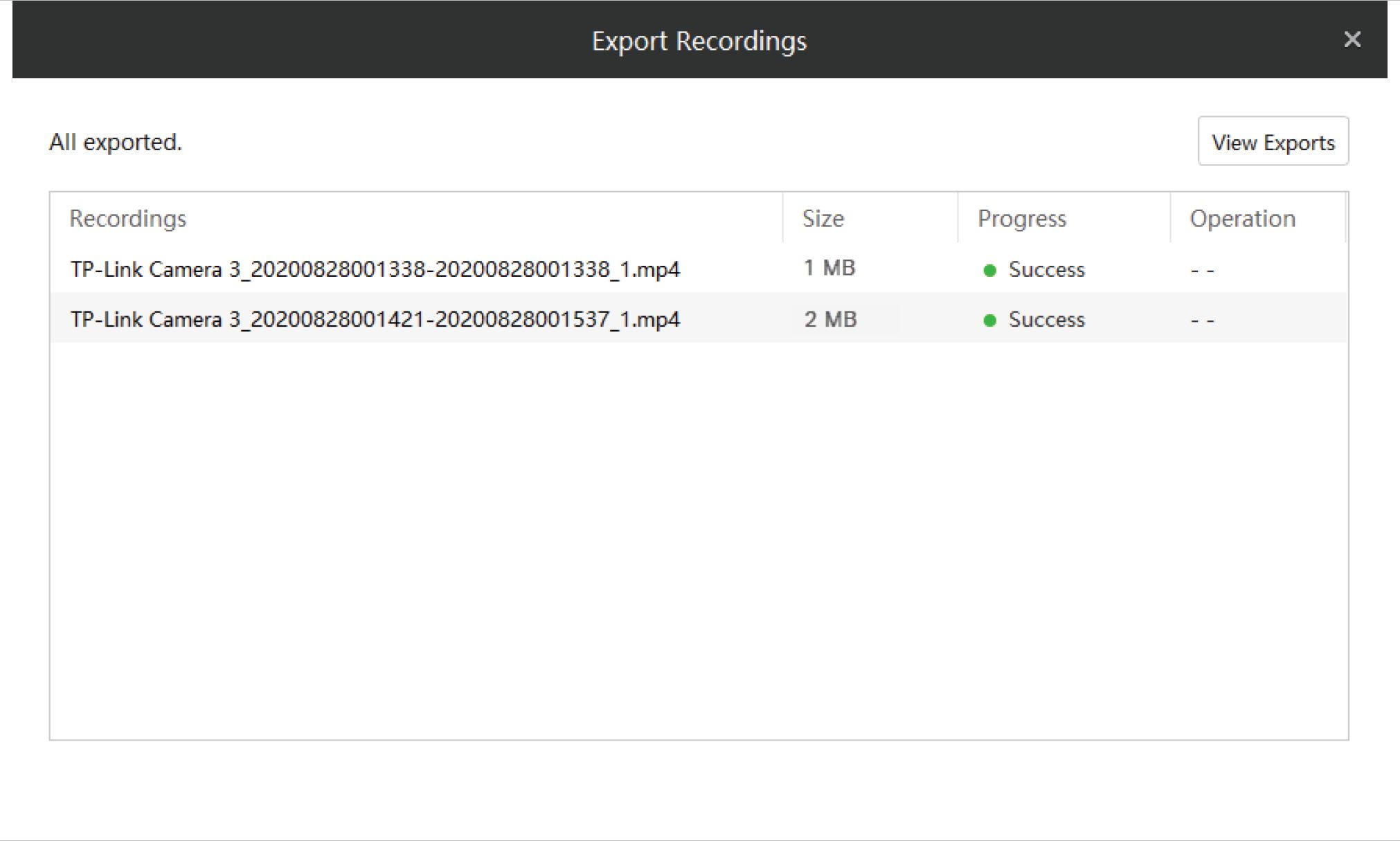
You can select the storage location for the screenshots, videos recorded in playback and video clips. Go to Settings > Storage > File Settings and click Browse to select the path. After you click Save, three folders, Picture, Video and Cloud, will be automatically created to store the corresponding files.
■ Stp-link I VIGI
IEI
Device
File Settings
Device List
Save to
Firmware Update
Storage
Storage Schedule
Storage Management
Export Recordings
File Settings
Export Format
Live View Playback Settings
C:\Users\admin\Documents\TP-Link\VIGI Security Managed
Browse
After you take screenshots, record videos, or edit clips, folders will be automatically created by date under this path. The folders include:
Picture: Save the screenshot.
■i Video: Save recordings and clips.
Afolder named “Cloud” will be created automatically in this path. The cloud recordings downloaded will be saved to this folder.
■ Cloud: Download cloud recordings.

Please log in.
3 o
x
57
Chapter 6
Recording and Storage
You can set the export mode in advance to simplify the export process.
| Ask before each export | You should select the export mode every time before exporting files.
Skip the pop-up window of export mode when exporting files. All the files will be exported using the selected mode. |
| Using the following mode | Speed Mode: The export process is faster than that of compatibility mode.
Compatibility Mode: The exported recordings will be transcoded to H.264 which is compatible with various digital products. |
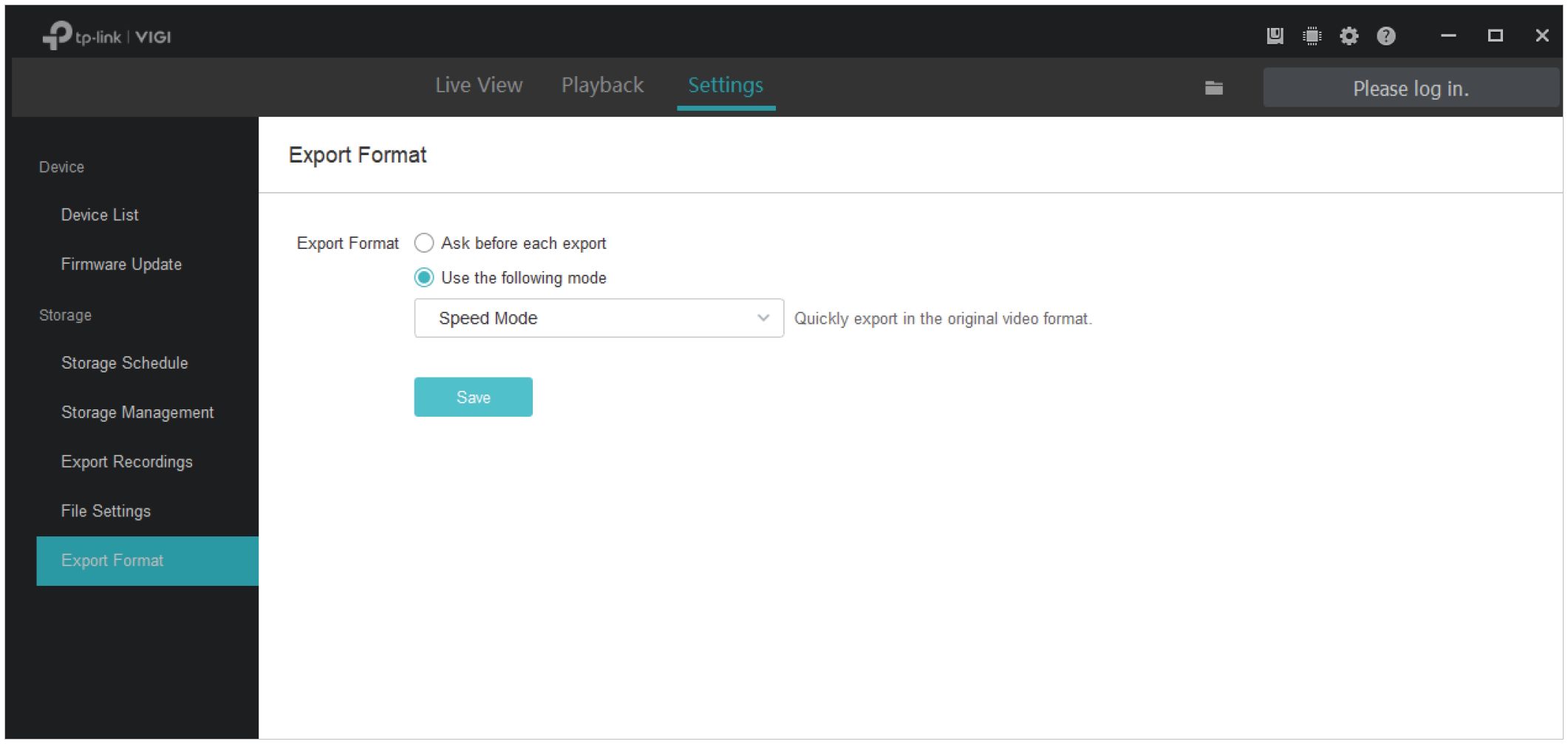
58
Configure Your Cameras and NVRs
This chapter guides you on how to configure cameras and VIGI NVRs added to VIGI Security Manager. You can configure events on cameras, the information, display parameters and network settings of devices. For VIGI Security Manager, You can also check and configure system settings and upgrade its firmware. This chapter includes the following sections:
Configure Events (Only for Cameras)
Chapter 7
Configure Your Cameras and NVRs
V 7. 1 View Device Information
In Device List, all devices added to VIGI Security Manager are listed. If you have logged in with your TP- Link ID, only the devices bound with the TP-Link ID are listed.
| q^tp-link 1 VIGI | Bl ■ O O – □ x |
| Live View Playback Settings a TP-Link Support Team_'” v | |
| My Devices Discovered Devices | |
| Device | — |
| Device List | Q Device Name | Ö Refresh j | W Delete |
| Firmware Update | □ Device Name Status IP Address MAC Address Operation |
| Storage | □ VIGI NVR1008H(UN) 1.0 Online Remote Device 08^07-06-00-1 B-E4 |
| Storage Schedule | □ TP-Link Camera Online Remote Device 60-32-B1-5F-2C-B5 |
| Export Recordings | |
| File Settings | |
| Export Format |
| Device Name | Displays the device name. |
| Status | Displays the connection status. If the device is offline, hover your cursor on O and follow the instructions for troubleshooting. |
| IP Address | Displays the IP address of the device when the device is in the same subnet with the manager host. When the device is not in the same subnet, Remote Device is displayed. |
| MAC Address | Display the MAC address of the device. |
| Operation | @: Click to view more information of the device. For all managed NVRs and cameras, you can view their information in Device List. For cameras, you can also view system logs to monitor them.
O: Click to configure the device functions, such as display information, network settings, and cloud service. |
60
Chapter 7
Configure Your Cameras and NVRs
Go to Settings > Device List > My Devices and click in the list. Click Device Info. The following information are listed in the window.
| Device Information | X | ||
| TP-Link Camera | |||
| System Logs | Device Information | ||
| Device Info | Device Information | ||
| System Time: | 2020-09-17 00:38:55 | ||
| Model: | VIGI C300HP-4 | ||
| Device Name: | TP-Link Camera | ||
| Firmware Vers | 1.0.1 Build 200529 Rel 58651n | ||
| Network Information | |||
| IP Address: | 10.0.0.4 | ||
| MAC: | 3C-84-6A-AF-96-50 | ||
| Stream Info | |||
| Resolution: | 2304*1296 | ||
| Bit Rate: | 20 | ||
| Device QR Code | |||
| Device Information | Displays the system time, device model, device name, and firmware version. |
| Network Information | Displays the IP address and MAC address of the device. If the manager does not display the IP address, check the network and try again later. |
| Stream Info | (Only for cameras) Displays the resolution and bit rate. |
| Device QR Code | Display the QR code. You can scan it to add the device to VIGI app. |
61
Chapter 7
Configure Your Cameras and NVRs
System Logs are used to record the messages of cameras. To view system logs, go to Settings > Device List > My Devices and click in the list. Click System Logs on the left. Select a time range and click Search. The logs recorded in the time range will be listed in the table.
| 2020 | | nr | |
| Time | Activity | ||
| 09/16/2020 | 19:40:04 | Switch to NIGHT (ILMN_236 < d2n[4]_1525) | |
| 09/16/2020 | 19:17:09 | Switch to DAY (ILMN_171895 > n2d[4]_9373) | |
| 09/16/2020 | 18:05:49 | Switch to NIGHT (ILMN.1511 < d2n[4]_1525) | |
| 09/16/2020 | 07:21:12 | Switch to DAY (ILMNJ25317 > n2d[4]_9373) | |
| 09/16/2020 | 00:04:50 | Switch to NIGHT (ILMN_46 < d2n[4]_1525) | |
| 09/15/2020 | 16:06:49 | The user admin logged in. IP address: 10.0.3.110 | |
| 09/15/2020 | 16:06:49 | The user admin logged in. IP address: 10.0.3.110 | |
| | Clear | Total: 7 result(s) | 1/1 |
If needed, you can click Clear to delete all the logs.
V 7. 2 Configure Basic Information
You can modify the device name and channel name (only for NVR) in Basic Information. For local devices, you can also modify the password.
Note: To modify the password, log out the TP-Link ID first.
62
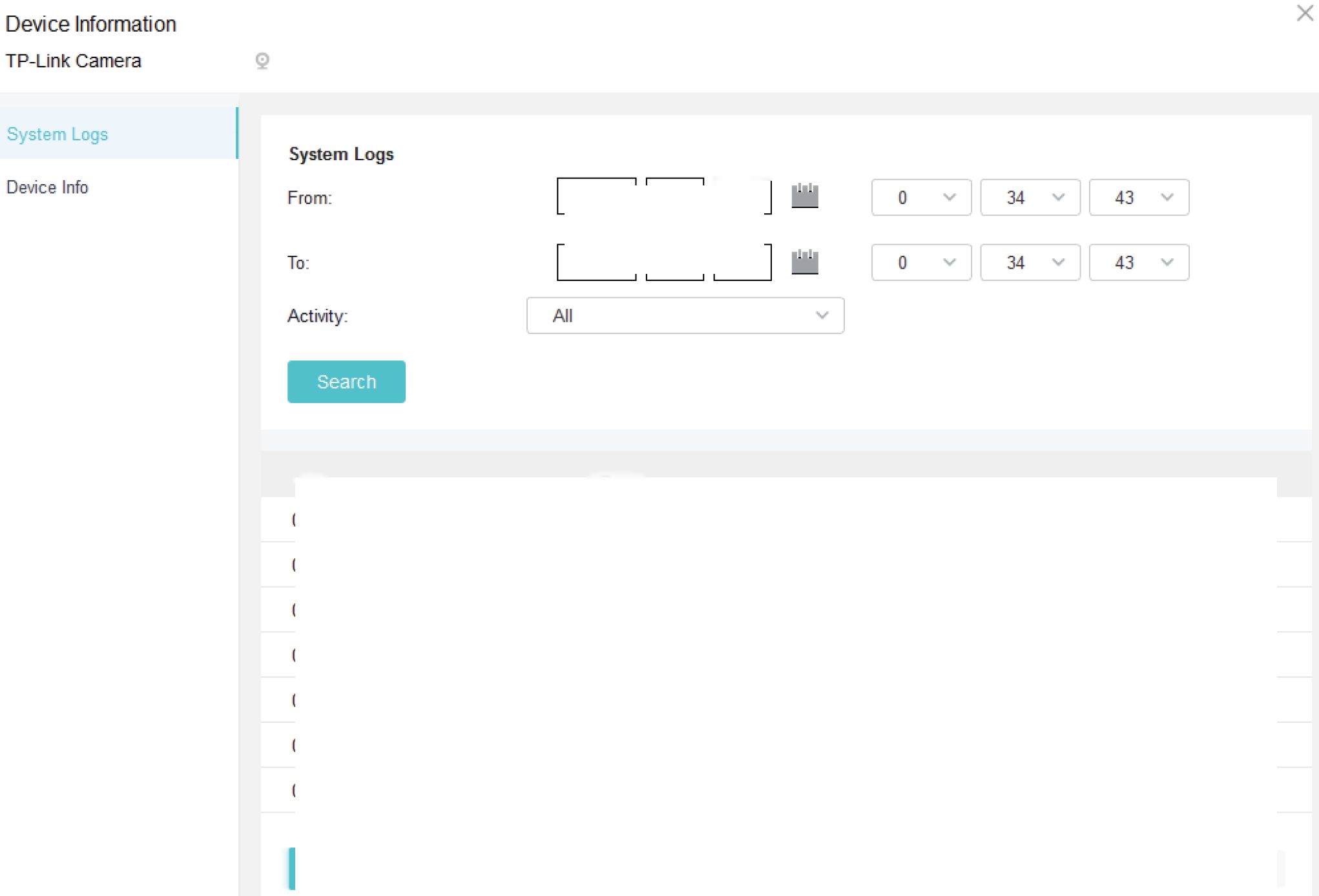
Chapter 7
Configure Your Cameras and NVRs
Go to Settings > Device List > My Devices and click J in the list. Click Basic Information. To modify the name, enter the name and click Save. To modify the password, click Modify, enter the password and email address, and click Confirm.
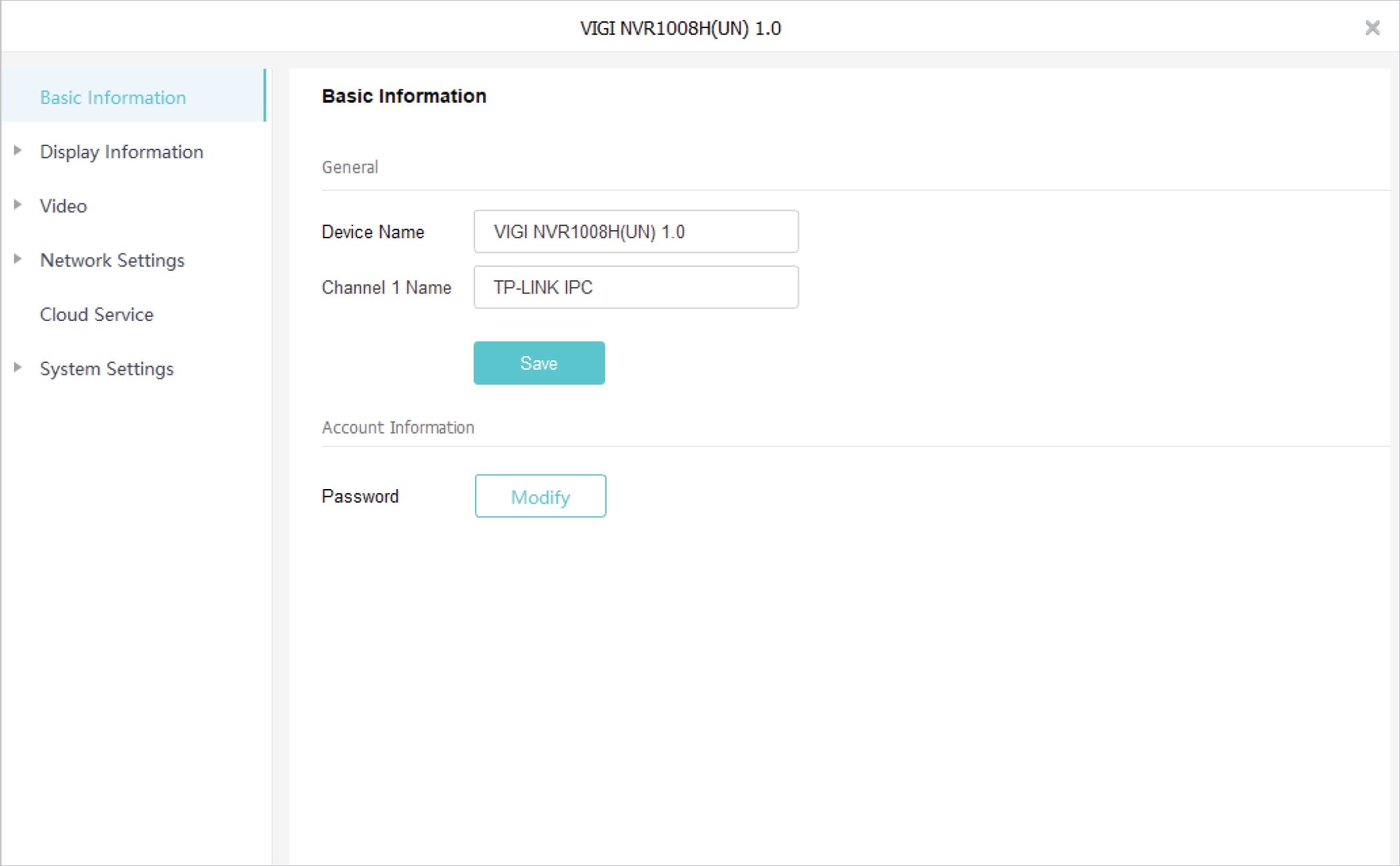
V 7. 3 Configure Display Information
In Display Information, you can configure the image effects, specify the privacy areas, and decide the information to display on the screen.
7. 3. 1 Configure Image Effects
In Image, you can configure the parameters and functions to adjust the image effects.
Follow the steps below to configure image settings.
- Go to Settings > Device List > My Devices and click O in the list. Go to Display Information > Image.
- Configure the parameters and functions.
63
Chapter 7
Configure Your Cameras and NVRs
For cameras, configure the following parameters and functions.
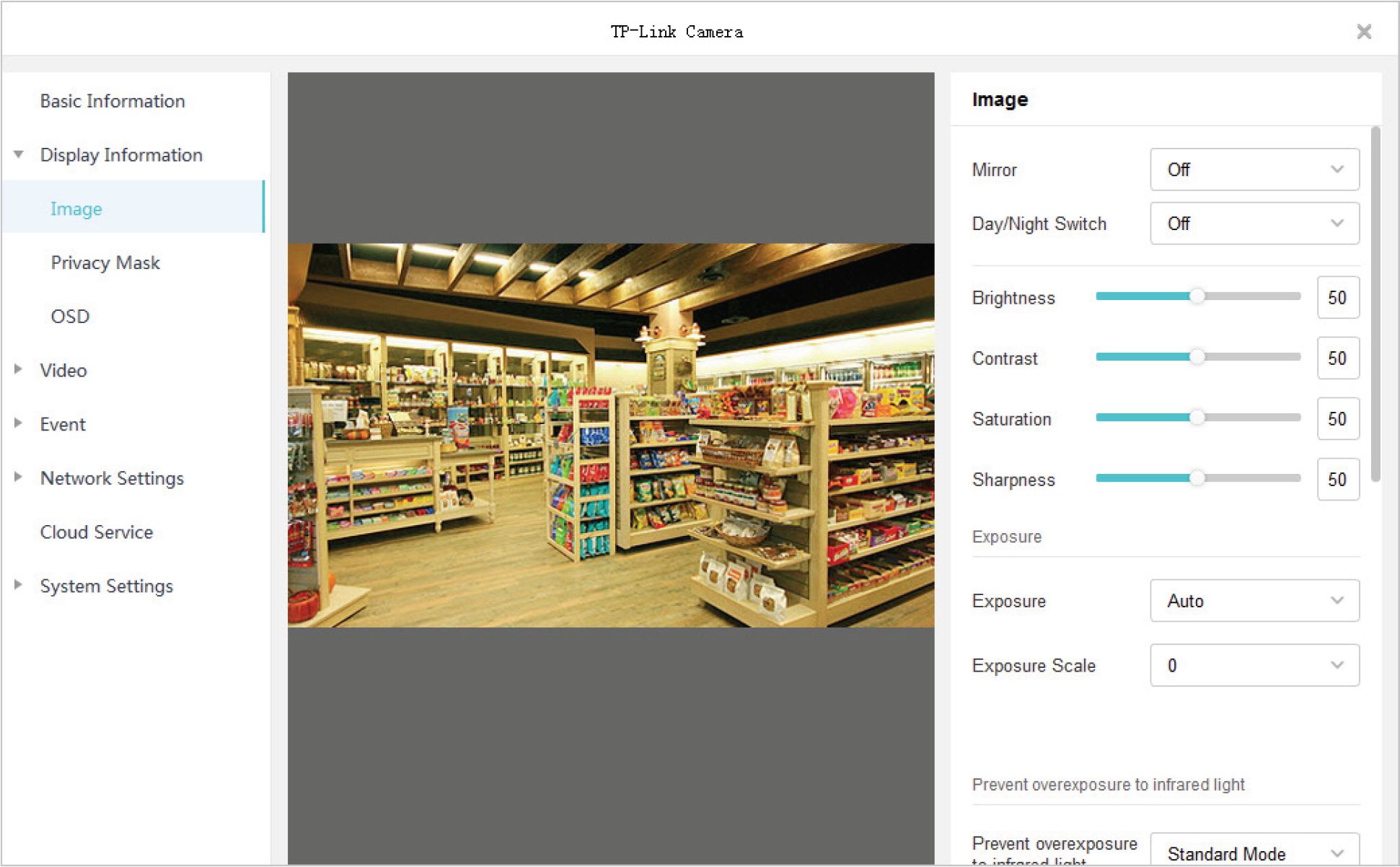
| Mirror | Select a mirror mode. When you select Off, the image displays normally. |
| Day/Night Switch | Select a method to switch the image settings of day and night. If you select Auto or Scheduled, click the Day/Night tab and configure the settings respectively.
Off: The camera applies the same image settings in a day. Auto: The camera switches the image mode of day and night automatically based on the light intensity. Scheduled: The camera switches the image mode of day and night at specified time. If you select this method, adjust the slide bar to specify the switch time. |
| Brightness | Adjust the brightness of image. The image gets brighter when the value increases. |
| Contrast | Adjust the contrast of image. The image contrast gets stronger when the value increases. |
| Saturation | Adjust the saturation of image. The color of image gets richer when the value increases. |
| Sharpness | Adjust the sharpness of image. The image gets sharper when the value increases. |
64
Chapter 7
Configure Your Cameras and NVRs
| Exposure | Select a exposure mode.
Auto: The camera adjusts the exposure automatically. If you select Auto, specify the exposure scale. The image gets brighter when the scale increases. Manual: The image exposure is fixed. If you select Manual, adjust the slide bar of Gain to specify the exposure gain, and select a shutter speed. The image gets brighter when the gain increases or the shutter speed gets slower. |
| Prevent
Overexposure to infrared light |
Select a mode to prevent overexposure to infrared light when objects get close to the camera at night. If you select Manual, adjust the slide bar to specify an exposure scale. |
| Infrared Light | Select a mode to decide the usage of infrared light. The available options vary due to the mode you select in Day/Night Switch.
Auto: The camera enables the infrared light automatically when it detects the environment turns dark, and disables when the environment is bright enough. Specify Sensitivity to decide the light intensity that can trigger the switch of infrared light. The infrared light is easier to be triggered when the sensitivity decreases. Enter Delayed Switch to decide how long the camera waits to enable or disable the infrared light when the environment reaches the light condition. Scheduled On/Off: Specify the time to enable and disable infrared light. Always On/Off: The camera enables/disables the infrared light all the time. |
| WDR | WDR (Wide Dynamic Range) can improve the image effects in backlit scenes. If you select On, the camera balances the light of the brightest and darkest areas automatically. |
| BLC Area | BLC (Backlight Compensation) can clear the dark area of the video. Select a position and the camera adjusts the exposure based on the light intensity in the area. |
65
Chapter 7
Configure Your Cameras and NVRs
| White Balance | Select a mode and the camera will adjust the color temperature to display the image approximated to the realistic vision effects.
Auto: The camera adjusts the color temperature automatically. Daylight/Natural Light/Incandescent/Warm Light: The camera adjusts the color temperature to remove the color casts caused by the corresponding light. Current: The camera keeps the current color settings all the time. Custom: Adjust the slide bar to configure the color temperature, and the camera keeps the settings all the time. |
For NVR, select a channel and configure the following parameters.
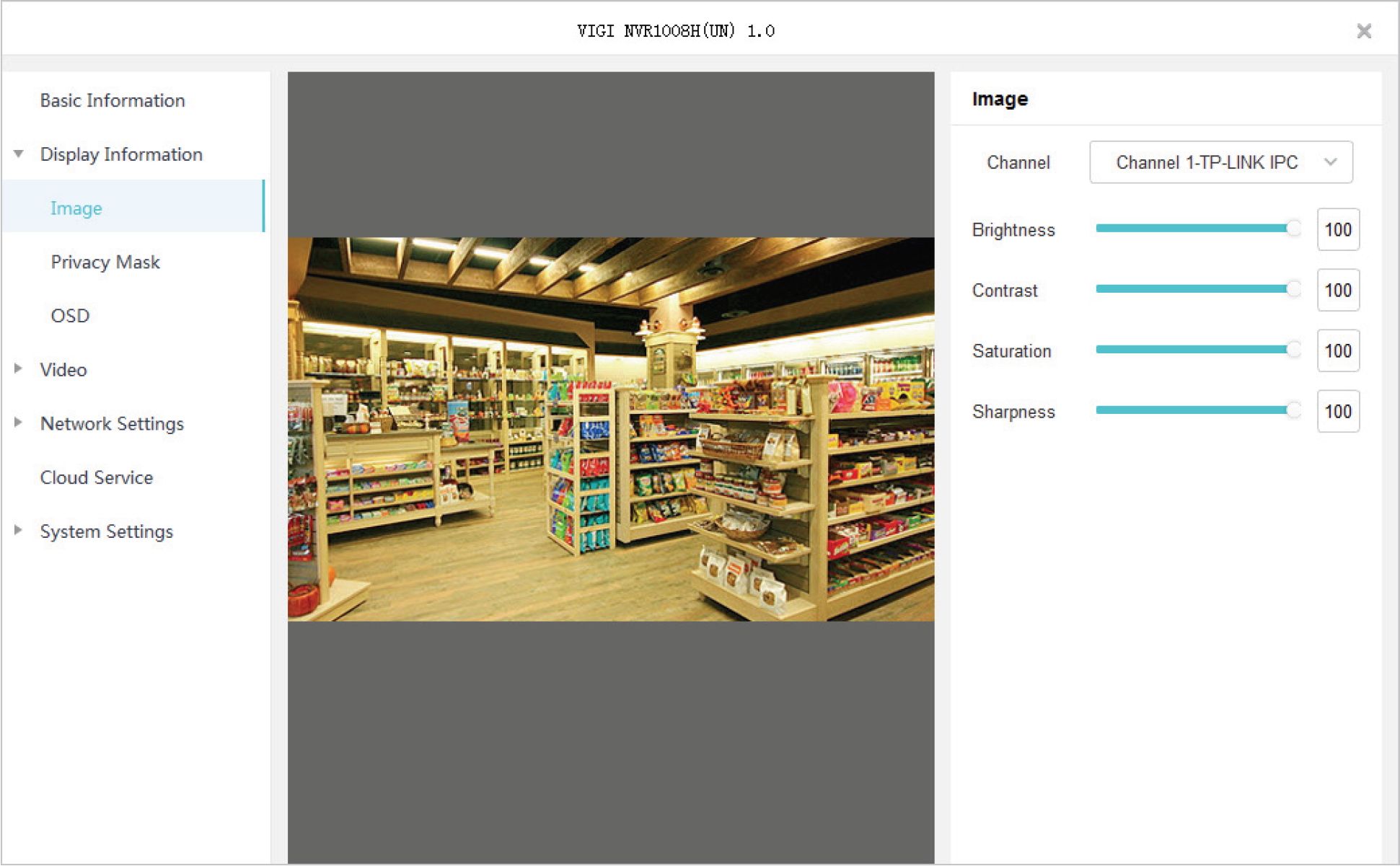
| Brightness | Adjust the brightness of image. The image gets brighter when the value increases. |
| Contrast | Adjust the contrast of image. The image contrast gets stronger when the value increases. |
| Saturation | Adjust the saturation of image. The color of image gets richer when the value increases. |
| Sharpness | Adjust the sharpness of image. The image gets sharper when the value increases. |
If you want to reset to the default settings, click Reset.
66
Chapter 7
Configure Your Cameras and NVRs
7. 3. 2 Configure Privacy Mask
In Privacy Mask, you can set privacy area in the image. The area cannot be recorded and monitored.
Follow the steps below to configure Privacy Mask.
1. Go to Settings > Device List > My Devices and click O in the list. Go to Display Information >
Privacy Mask.
- Enable Privacy Mask, select a channel (only for NVR), and draw the privacy areas on the preview screen (the dark squares in the picture below). Use the mouse to adjust the size and location of areas. To remove a certain privacy area, select it and click Delete. To remove all privacy areas, click Clear.
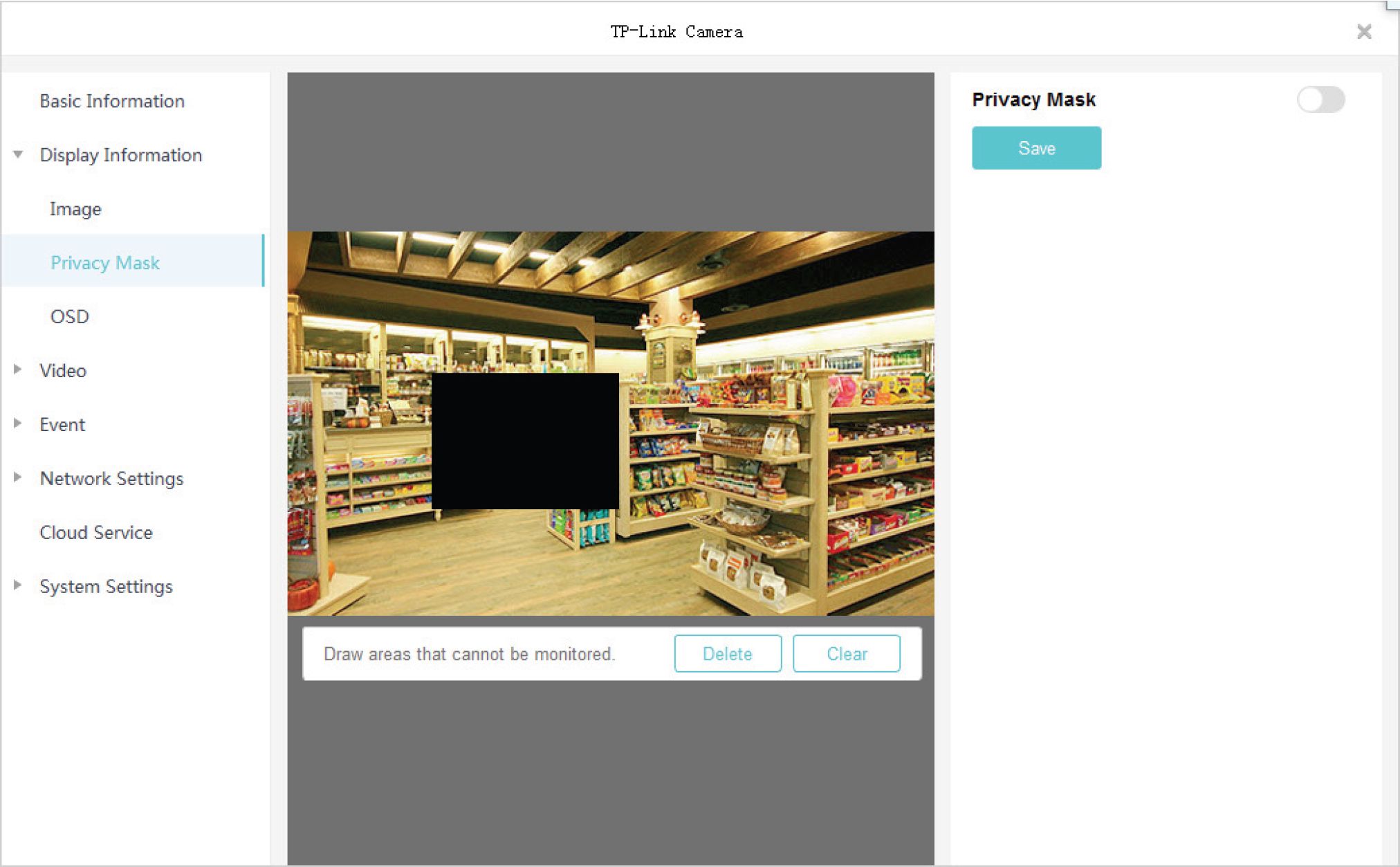
If you want to reset to the default settings, click Reset.
In OSD, You can configure OSD (On Screen Display) to edit the information displayed in Live View and recordings.
Follow the steps below to configure OSD.
1. Go to Settings > Device List > My Devices and click 0 in the list. Go to Display Information > OSD.
67
Chapter 7
Configure Your Cameras and NVRs
- Select a channel from the drop-down list (only for NVR), configure displayed information and display effects. Click and drag the information in the preview screen to adjust the place. Click Save.
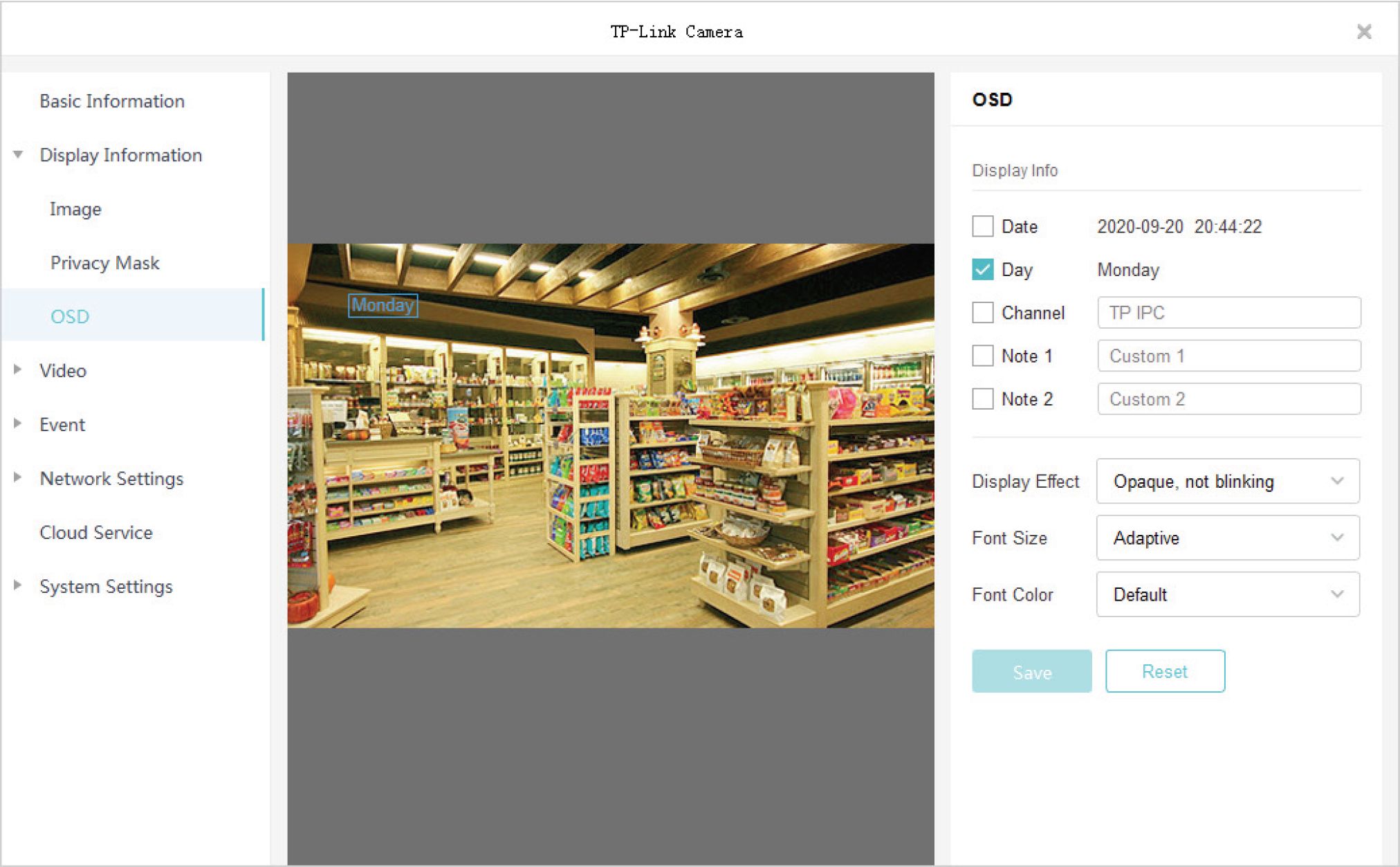
| Date/Day | Click to display or hide the time information. |
| Channel | Click the checkbox and enter the channel name to be displayed. |
| Note 1/2 | (Only for cameras) Click the checkbox and enter the note to be displayed. |
| Display Effect | Select a display effect to display the information. |
| Font Size/Color | (Only for cameras) Select the font size and color of displayed information. |
If you want to reset to the default settings, click Reset.
The NVRs and cameras supports two stream levels, main stream and substream, which determine the video parameters of live view and playback, such as resolution, image quality and so on. You can configure the stream settings and apply them to the NVR and cameras added to VIGI Security Manager. For cameras directly added to VIGI Security Manager, you can draw an area for your special concern and the image quality of this area will be better.
68
Chapter 7 Configure Your Cameras and NVRs
7. 4. 1 Configure Stream Settings
Stream settings can be adjusted to increase or decrease recording resolution and fluency. They also impact recording file size and available recording bandwidth. To select the main stream or substeam, go to Live View, right click the camera in the device list or the Live View screen, and click Stream.
Follow the steps below to configure the stream settings.
3. Go to Settings > Device List > My Devices and click O’ in the list. Go to Video > Stream.
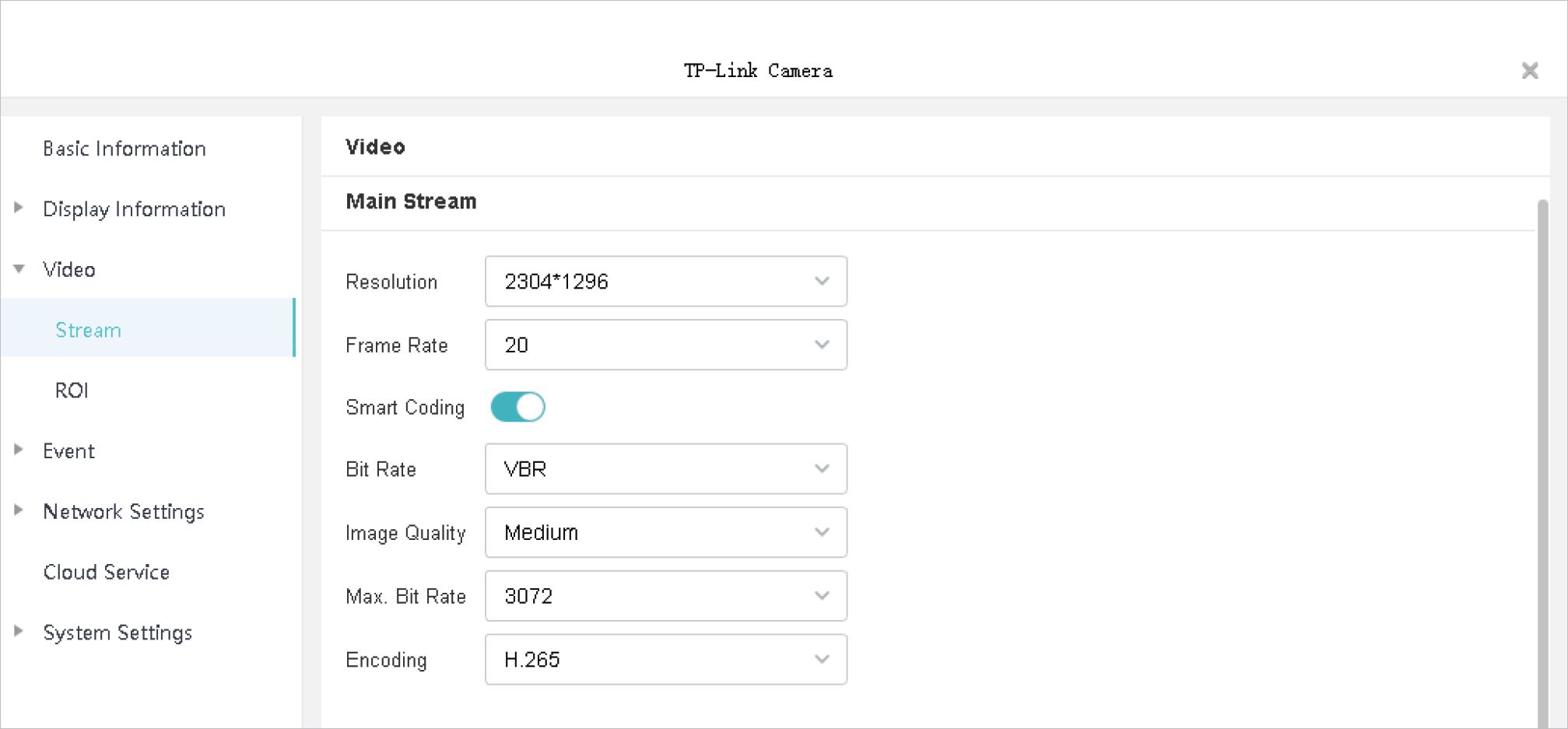
Resolution
Frame Rate
Smart Coding
Specify the resolution of the video stream. The screen displays images
more clearly when the resolution increases.
Specify the frame rate of videos. The video is more fluent when the rate
increases.
Enable Smart Coding to improve compression performance. The size
of recording files will be smaller and recordings will use less bandwidth.
Select a type of bit rate.
VBR: The bit rate changes with the image within Maximum Bit Rate.
CBR: The bit rate is Maximum Bit Rate all the time.
When VBR selected as the bit rate type, set the video quality as high,
medium, or low.
When VBR selected as the bit rate type, specify the upper limit of bit
rate.
When CBR selected as the bit rate type, specify the bit rate.
Bite Rate
Image Quality
Max. Bit Rate
69
Chapter 7
Configure Your Cameras and NVRs
| Encoding | Select the encoding type of the stream. Compared with H.264, H.265 is improved in reducing the file size and saving the bandwidth. |
7. 4. 2 Configure ROI (Only for Cameras)
In ROI (Region of Interest), you can configure the interest level of a specified area in each camera. The level ranks from 1 to 6, and the higher the ROI level, the better image quality.
1. Go to Settings > Device List > My Devices and click 0 in the list. Go to Video > ROI.
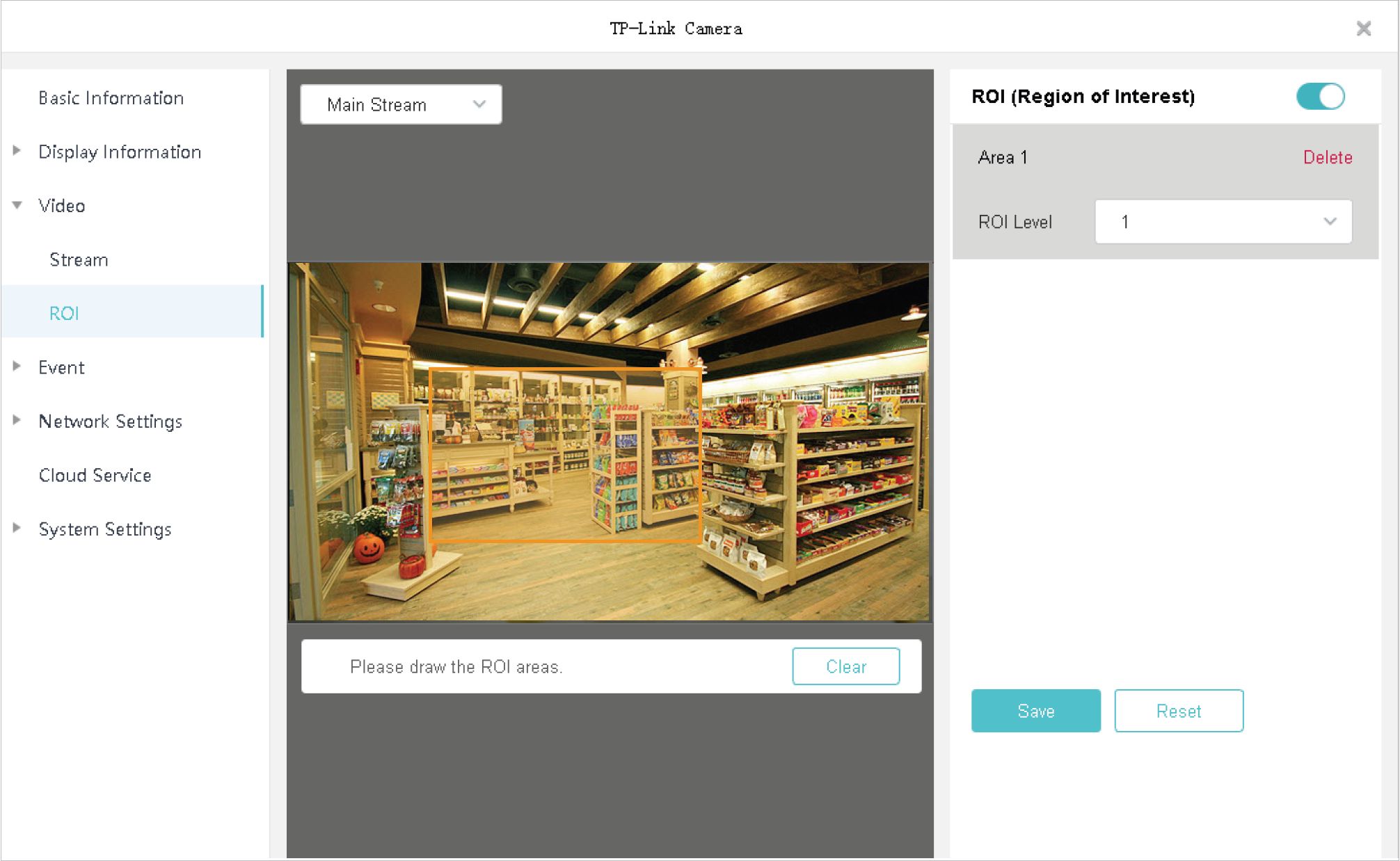
- Enable ROI.
- Select the stream type and draw an area on the preview screen (the yellow square in the picture above). Use the mouse to adjust the size and location of areas.
- Specify the ROI level and click Save.
V 7. 5 Configure Events (Only for Cameras)
VIGI Security Manager allows you to configure the event settings for cameras to detect different types of events. You cameras monitor the user-defined areas and you’ll be automatically alerted to any suspicious activity in your home and office.
It is recommended to bind the cameras to your TP-Link ID and log in to your TP-Link ID on VIGI Security Manager before setting the events. To bind your devices, go to Settings > Device List > My Devices
70
Chapter 7 Configure Your Cameras and NVRs
and click in the list. Then go to Network Settings > Cloud Service. You can receive alerts on your phone after you download VIGI app and log in with your TP-Link ID.
7. 5. 1 Configure Basic Events
■ Motion Detection
Motion detection allows cameras to detect the moving objects in the monitored area and triggers alarm actions. You can draw the monitored areas and customize the motion detection settings. Follow the steps below to finish the configuration.
1. Go to Settings > Device List > My Devices and click & in the list. Go to Event > Basic Event.
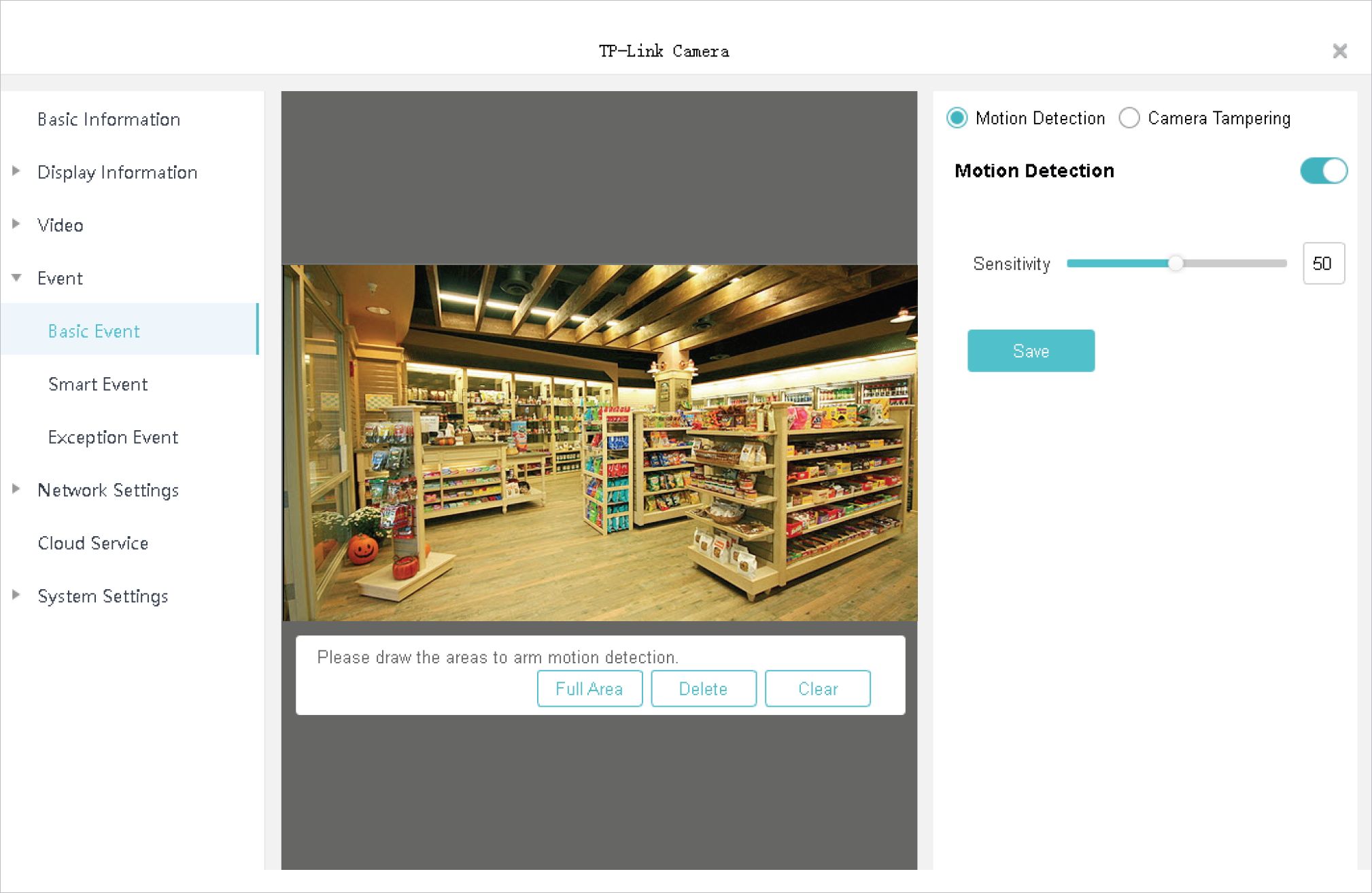
- Click Motion Detection on the top right and enable Motion Detection.
- Adjust the sensitivity of motion detection. A higher value can trigger the motion detection more easily.
- Draw the areas on the preview screen. If you click Full Area, the entire live view screen will be selected.
- Click Save.
■ Camera Tampering
Camera tampering is triggered when an area of camera’s lens is blocked, obstructed or vandalized. You can customize the camera tampering settings. Follow the steps below to finish the configuration.
71
Chapter 7
Configure Your Cameras and NVRs
1. Go to Settings > Device List > My Devices and click 0 in the list. Go to Event > Basic Event.
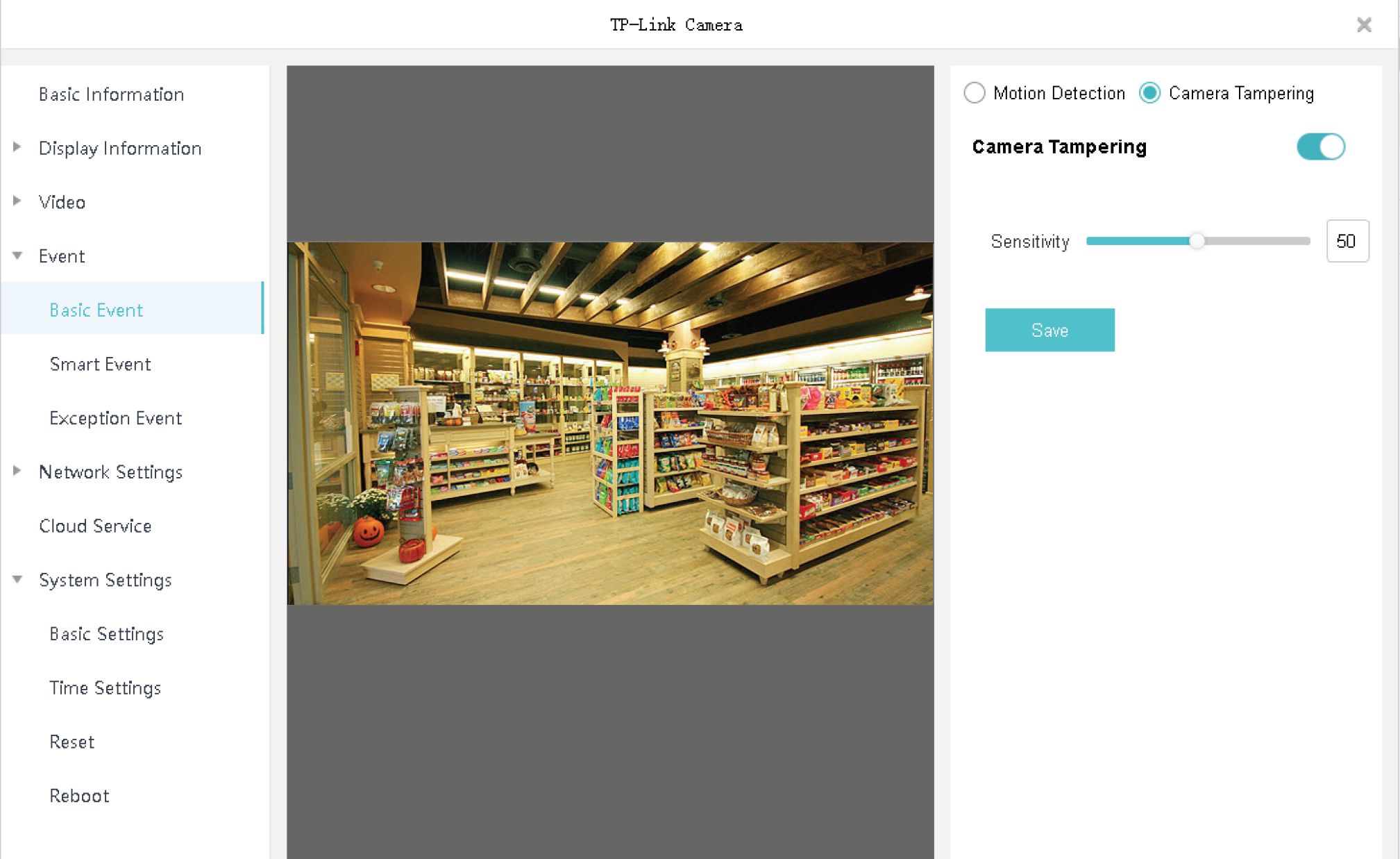
- Click Camera Tampering on the top right and enable Camera Tampering.
- Adjust the sensitivity of camera tampering. A higher value can trigger the camera tampering more easily.
- Click Save.
7. 5. 2 Configure Smart Events
■ Line Crossing Detection
Line crossing detection is triggered when cameras detect that moving objects cross a customized virtual line. You can customize the line crossing detection settings and set the schedule for them to take effect. Follow the steps below to finish the configuration.
72
Chapter 7
Configure Your Cameras and NVRs
1. Go to Settings > Device List > My Devices and click 0 in the list. Go to Event > Smart Event.
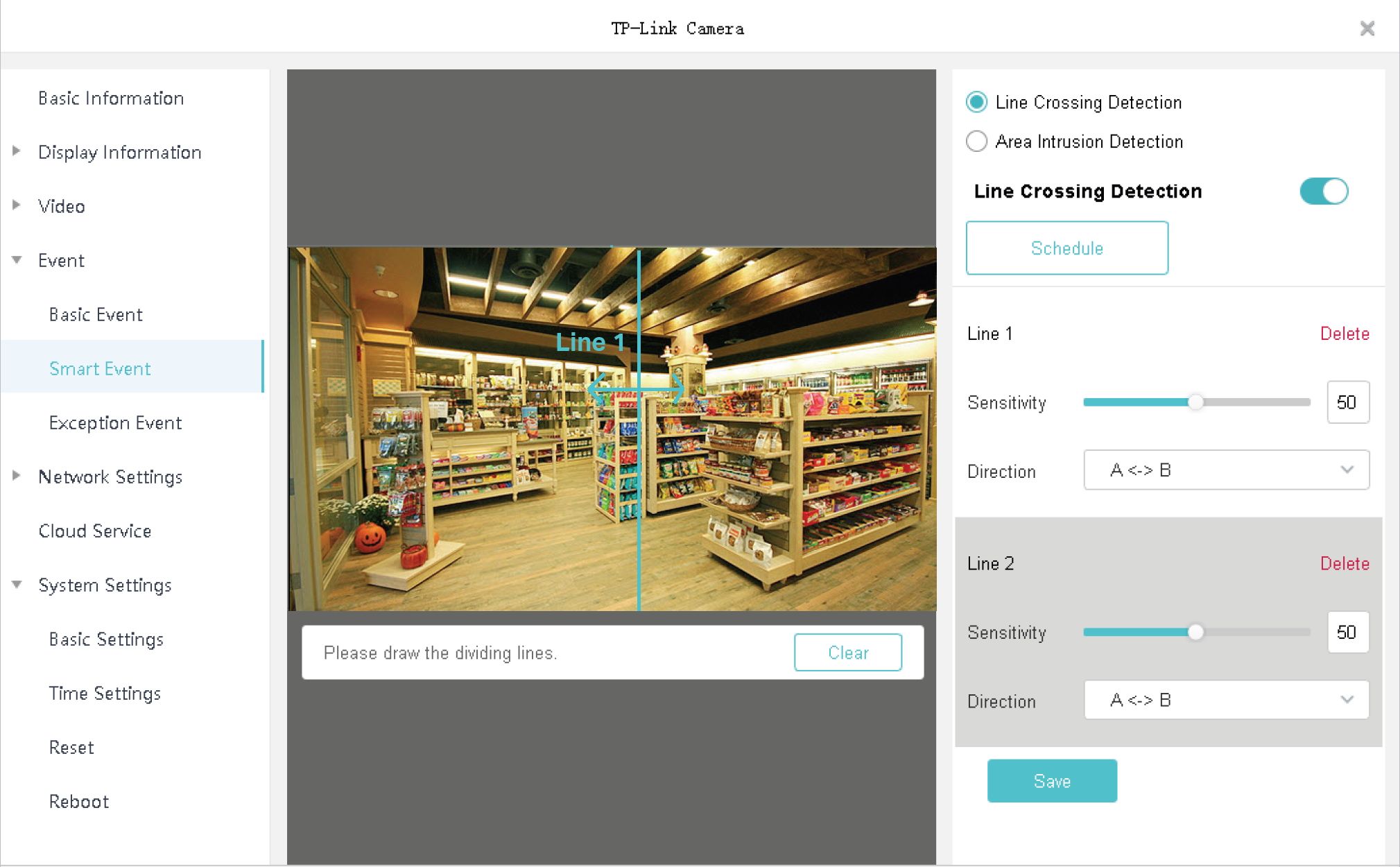
2. Click Line Crossing Detection on the top right and enable Line Crossing Detection.
73
Chapter 7
Configure Your Cameras and NVRs
3. Click Schedule. Click the time bar and enter the start time and end time manually. Click Save to save the week schedule for line crossing detection.
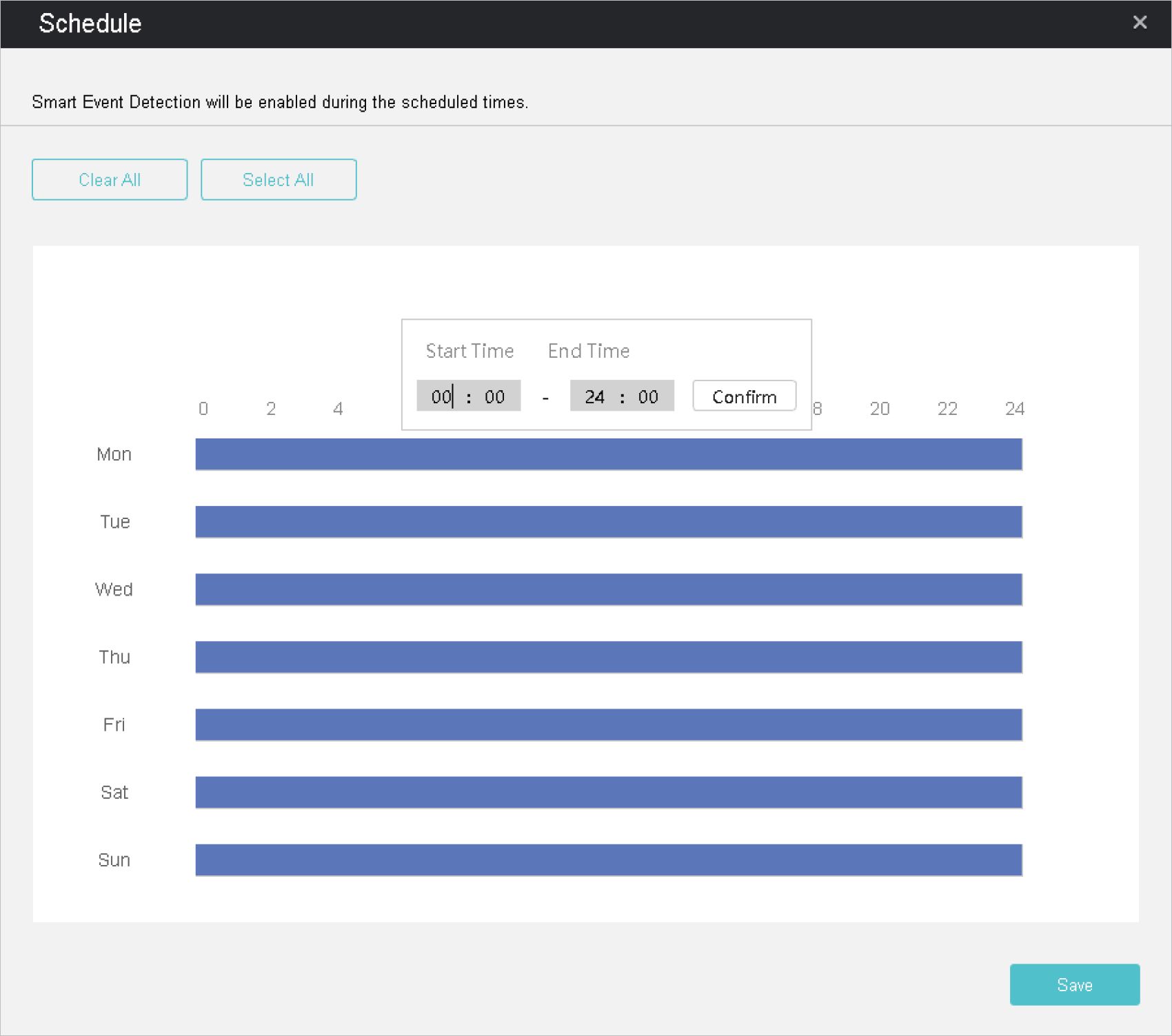
4. Draw lines on the preview screen. Select the area and configure its settings. The maximum number of customized lines is 4.
| Sensitivity | Set the sensitivity of line crossing detection. A higher value can trigger the line crossing detection more easily.
A->B: Only the object crossing the configured line from the A side to the B side can be detected. |
| Direction | A<-B: Only the object crossing the configured line from the B side to the A side can be detected.
A<->B: The object goes across the configured line with both directions can be detected. |
■ Area Intrusion Detection
Area intrusion is triggered when the camera detects an intrusion in the specified areas. You can customize the area intrusion settings and set the schedule for them to take effect. Follow the steps below to finish the configuration.
74
Chapter 7
Configure Your Cameras and NVRs
1. Go to Settings > Device List > My Devices and click 0 in the list. Go to Event > Smart Event.
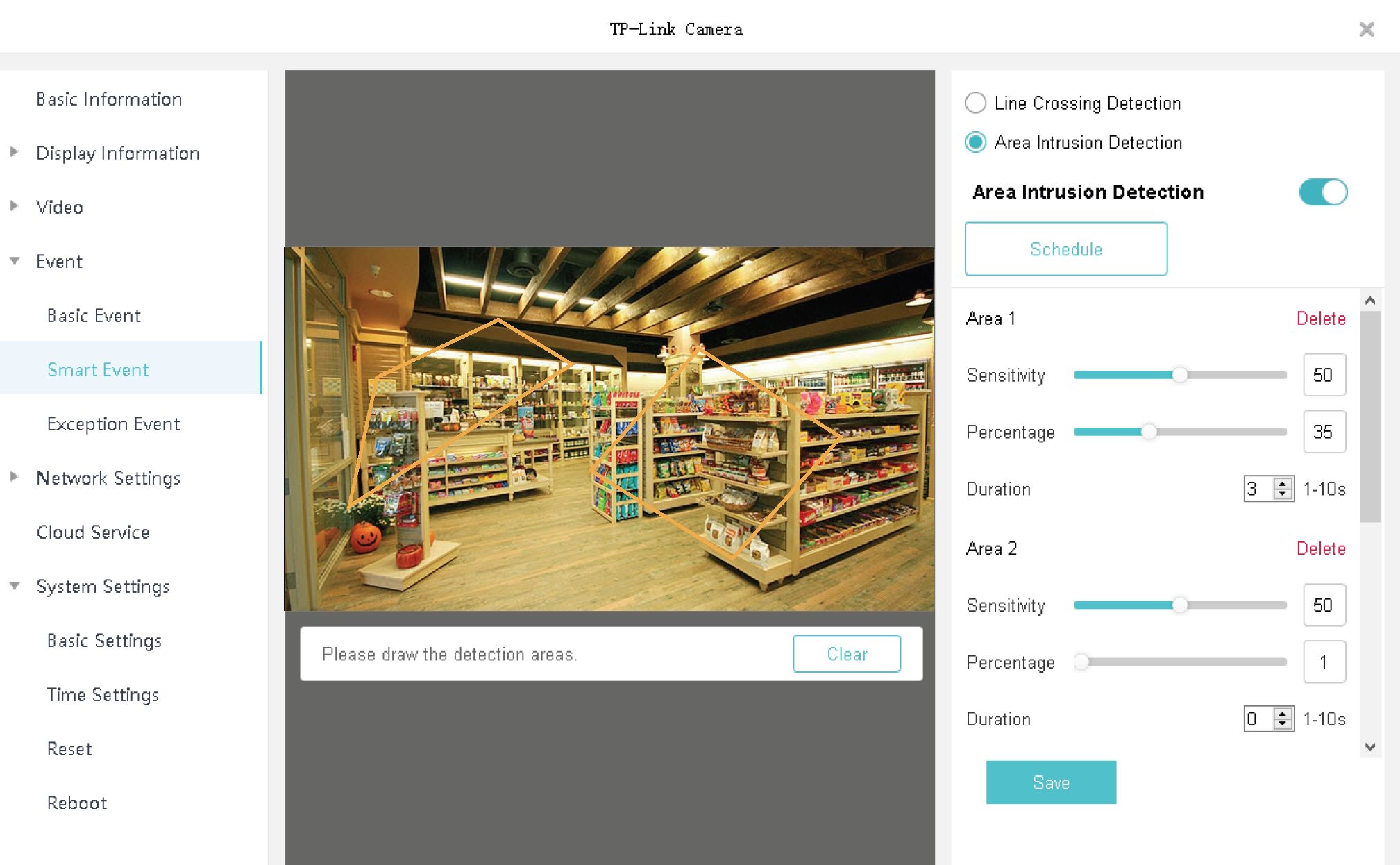
- Click Area Intrusion on the top right and enable Area Intrusion.
- Click Schedule. Click the time bar and enter the start time and end time manually. Then click Save to save the week schedule for area intrusion detection.
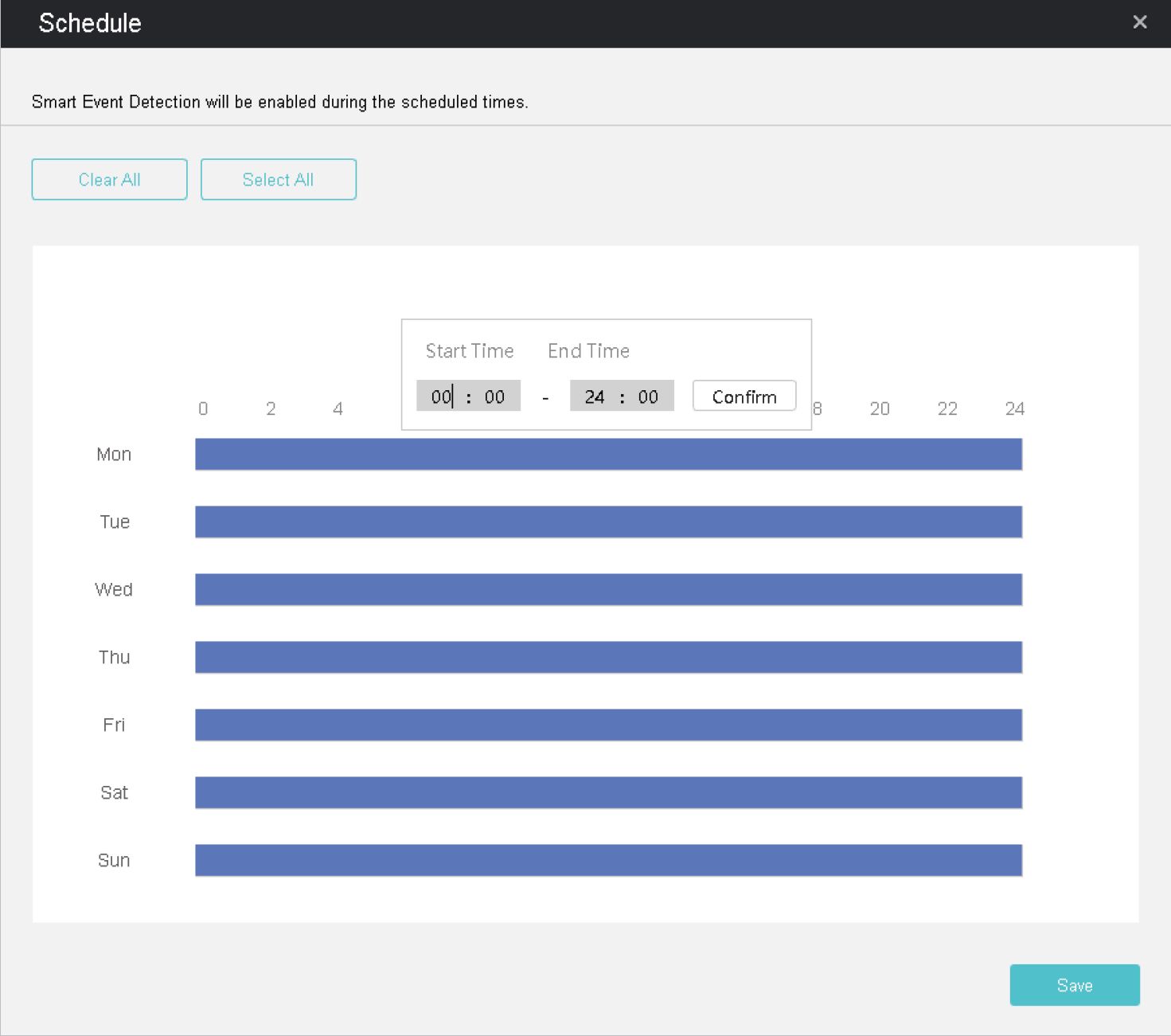
75
Chapter 7 Configure Your Cameras and NVRs
- Draw areas on the preview screen. Select the area and configure its settings. The maximum number of customized areas is 4.
| Sensitivity | Set the sensitivity of area intrusion detection. A higher value can trigger the area intrusion detection more easily. |
| Percentage | The area detection will be triggered when the ratio of the size of intrusive object to the intrusion area reaches the percentage. |
| Duration | Set the time for detecting the intrusion of objects. The interval should be no more than 10 seconds. |
7. 5. 3 Configure Exception Event
Exception event sets the maximum login attempts to protect the security of your cameras. VIGI Security Manager will be locked for 30 minutes if you enter the wrong password of your camera more than the specified attempts. Follow the steps below to finish the configuration.
1. Go to Settings > Device List > My Devices and click 0 in the list. Go to Event > Exception Event.
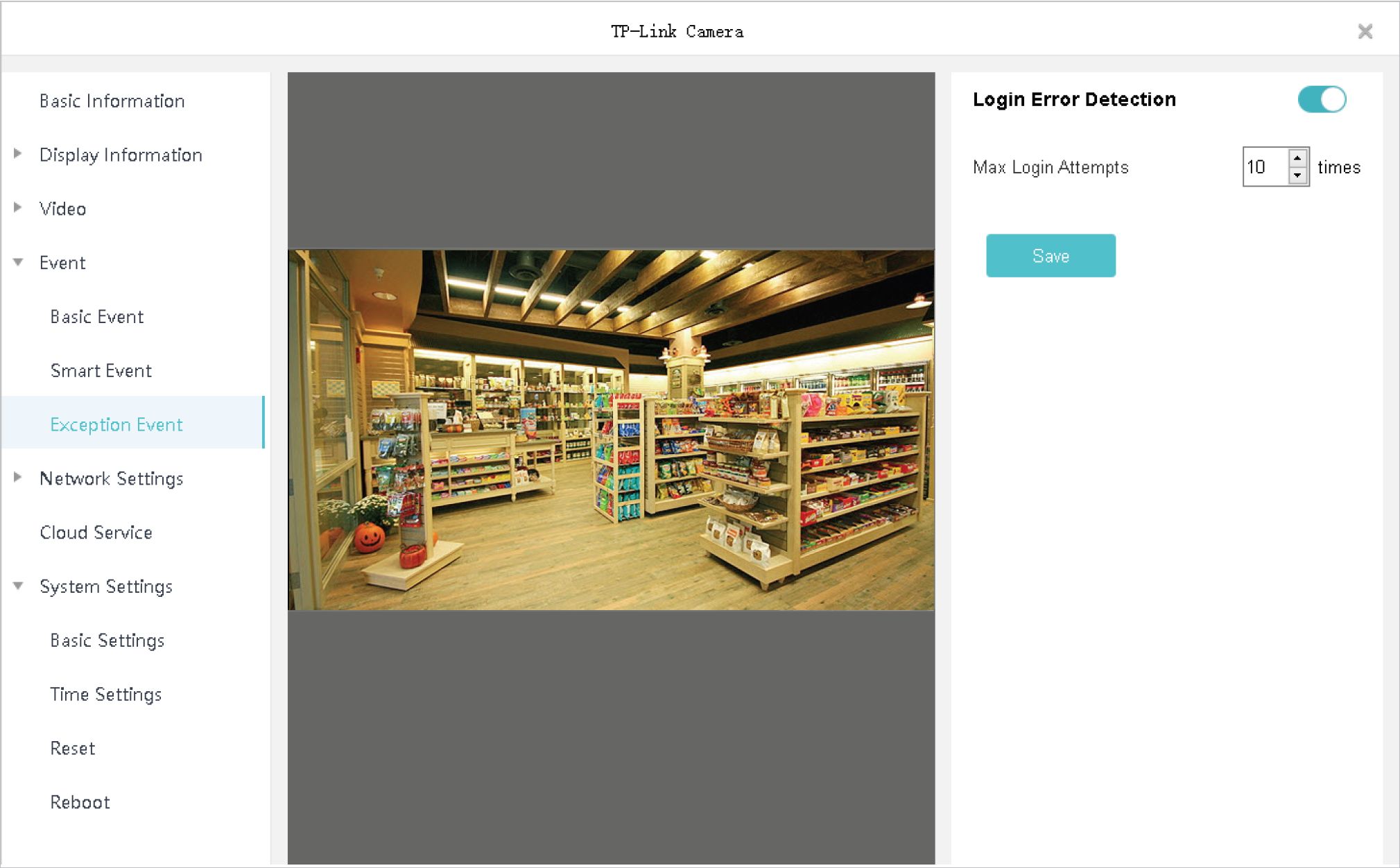
- Enable Login Error Detection on the top right.
- Set Max Login Attempts. The range is from 3 to 10.
- Click Save.
76
Chapter 7
Configure Your Cameras and NVRs
V 7. 6 Configure Network Settings
In Network Settings, you can configure the IP address, MTU (Maximum Transmission Unit). For cameras not managed by the NVR, you can also configure the management ports and enable advanced functions, such as Port Forwarding, IP Restriction and Multicast.
7. 6. 1 Basic and Advanced Network Configuration
In Network Configuration, you can configure the device to obtain an IP address automatically or assign a static IP address to it. If needed, you can also modify MTU.
Follow the steps below to configure the network.
- Go to Settings > Device List > My Devices and click O in the list. Go to Network Settings > Configuration.
- Configure basic settings to configure the IP address.
• To assign a static IP address to the device, select Static IP as the mode and configure the following parameters.
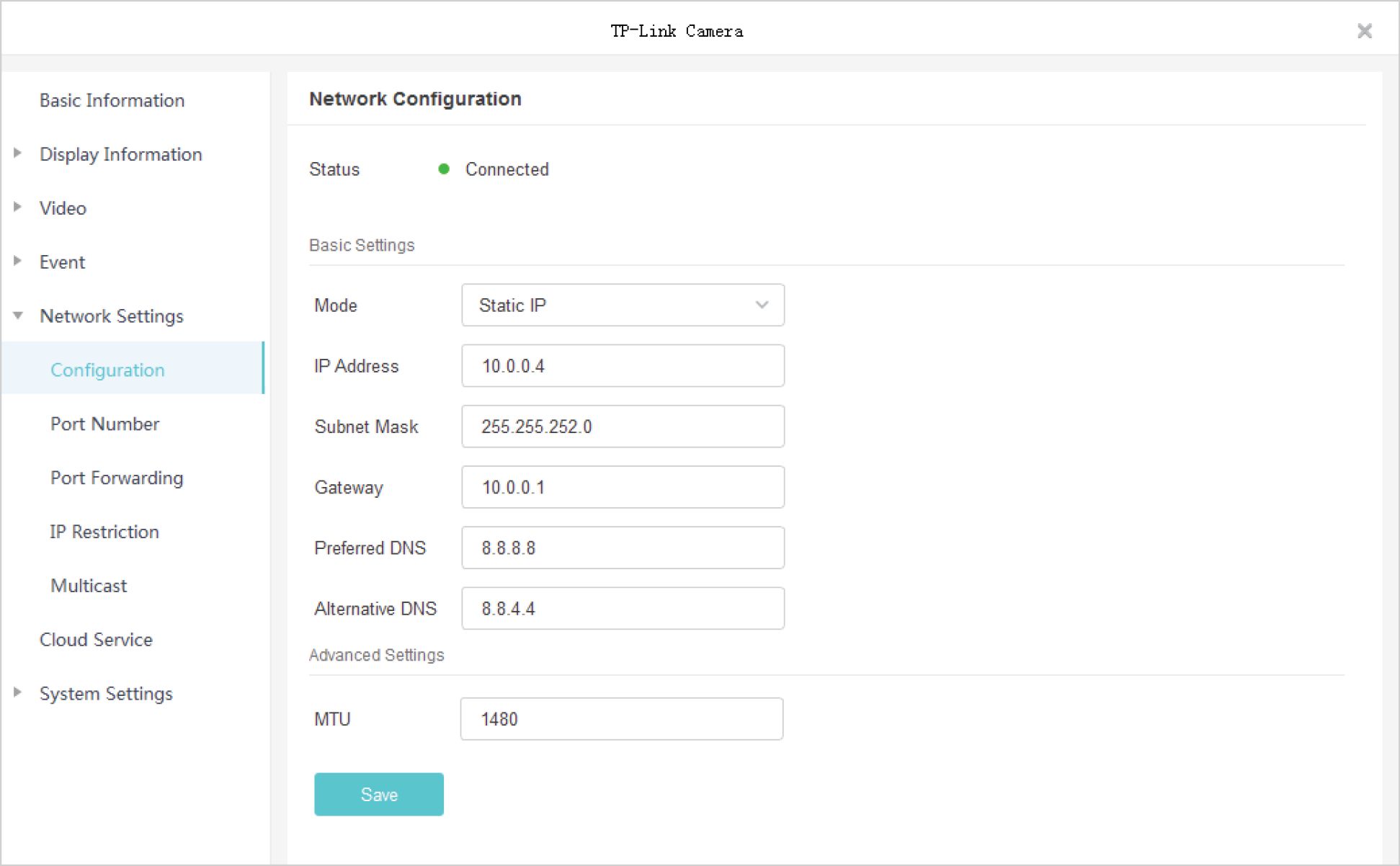
| IP Address | Specify an IP address for the device. The IP address should be in the same segment as the gateway; otherwise, the device cannot connect to the internet. |
| Subnet Mask | Enter the subnet mask. |
77
Chapter 7
Configure Your Cameras and NVRs
Gateway
Enter the IP address of the gateway device. This IP address
should be in the same segment as the device’s IP address.
Preferred/Alternate DNS Enter the IP address of the DNS server.
• To configure the device to obtain a dynamic IP address, select DHCP as the mode.
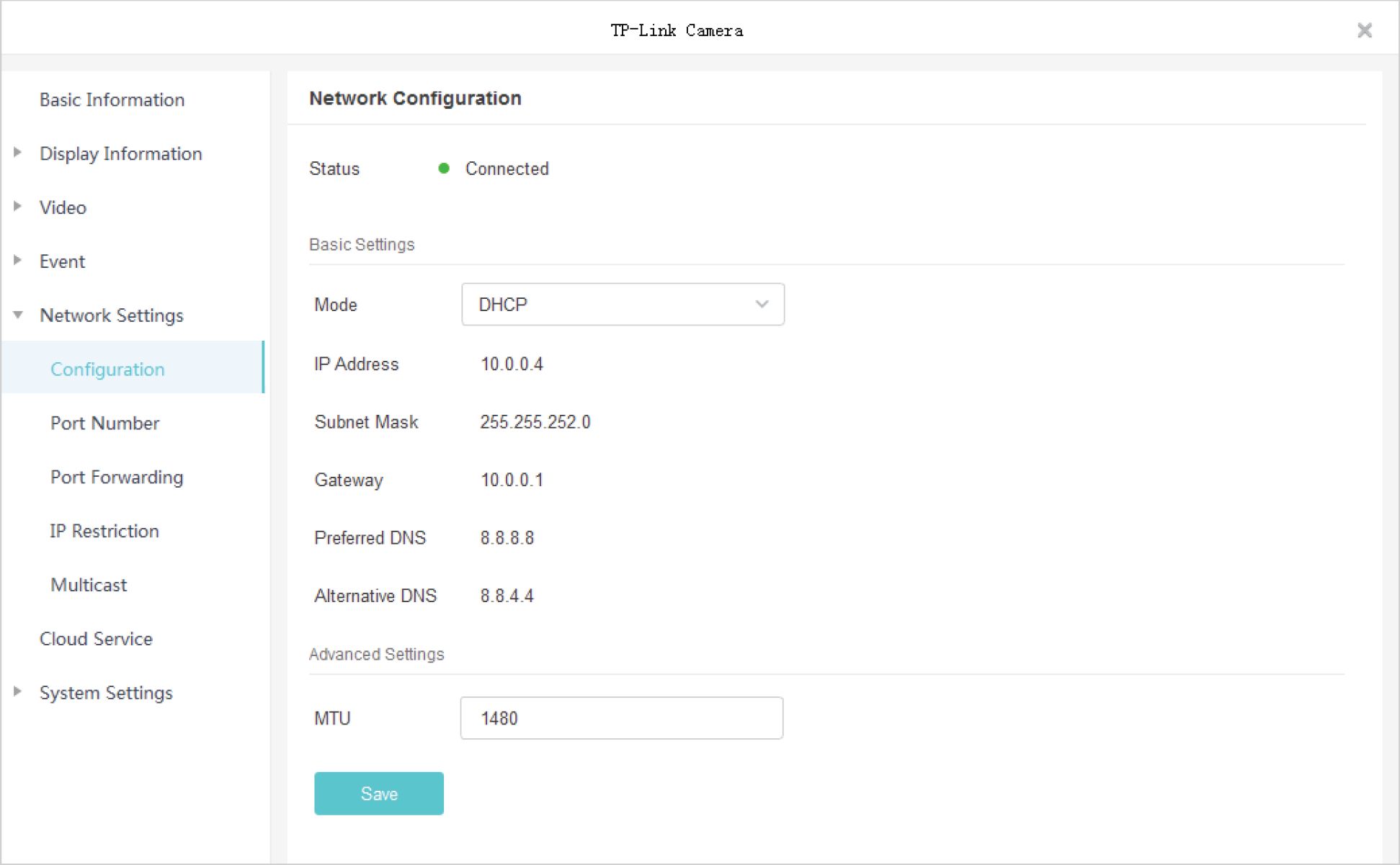
Note: A DHCP server (usually a router) is needed for the device to obtain a dynamic IP address.
- (Optional) Specify MTU (Maximum Transmission Unit) to decide the largest size of data unit that can be transmitted in the network. A larger unit can transmit more data in each packet, but it may increase the network delay because it needs more time to transmit.
- Click Save.
7. 6. 2 Configure Port Number (Only for Cameras)
In Port Number, you can configure the HTTP port, RTSP port and service port that can be used to access the camera through the network. Also, the ports configured here are used for communications of corresponding protocols.
78
Chapter 7
Configure Your Cameras and NVRs
To configure ports, go to Settings > Device List > My Devices and click 0 in the list. Go to Network Settings > Port Forwarding. Configure the ports and click Save.
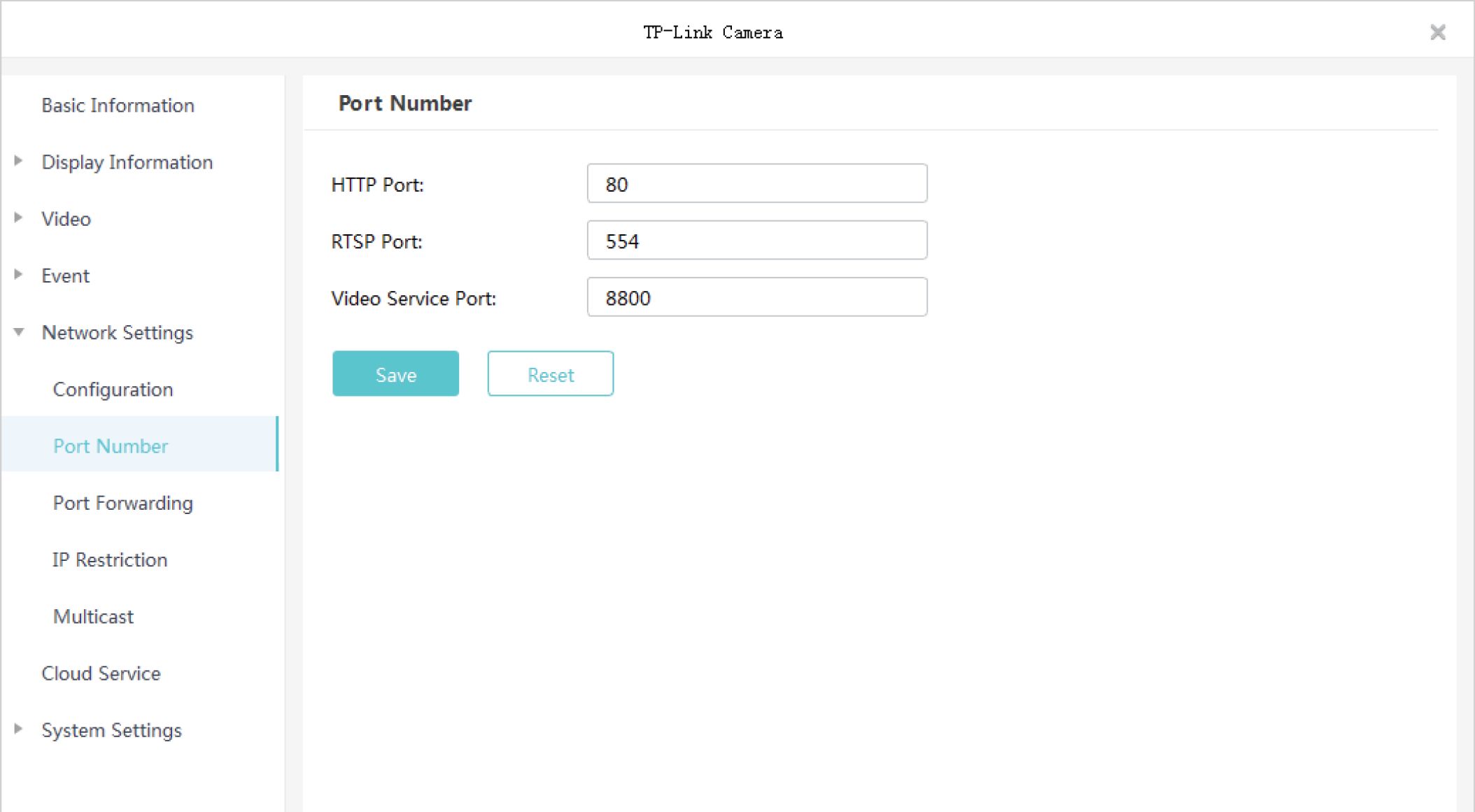
HTTP Port Specify a port for HTTP protocol.
RTSP Port Specify a port for RTSP protocol.
Video Service Port Specify a port for protocols of video services.
If you want to reset to default settings, click Reset.
7. 6. 3 Configure Port Forwarding (Only for Cameras)
Port Forwarding is used to establish the mapping between the internal port and external port. When Port Forwarding is enabled, you can access the device and watch the videos when accessing the external port remotely.
Note: The device should be connected to the internet, and Port Forwarding should be enabled on the gateway.
Follow the steps below to configure Port Forwarding.
1. Go to Settings > Device List > My Devices and click O in the list. Go to Network Settings > Port Forwarding.
79
Chapter 7
Configure Your Cameras and NVRs
- Enable Port Forwarding and specify a mapping type. If you select Auto as the mapping type, the mappings are established automatically. If you select Manual as the mapping type, click 3 to specify the external port.
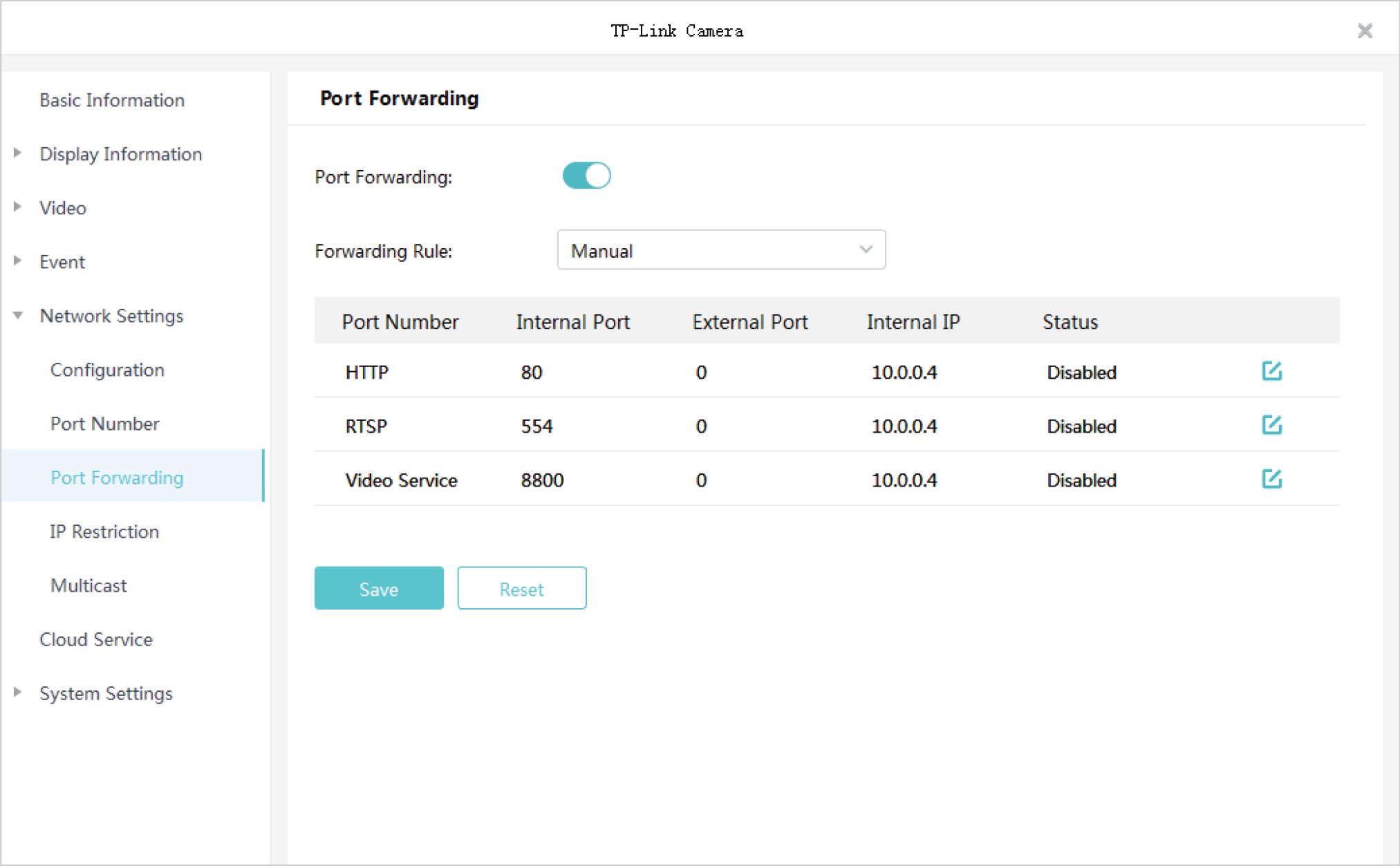
| Port Type | Displays the protocol type. |
| Internal Port | Displays the port of the device to be converted. |
| External Port | Displays the external port opened by the gateway. |
| Internal IP | Displays the IP address of the device that needs to be converted. |
| Status | Displays the status of mapping. |
With Port Forwarding enabled, you can remotely watch the videos with the URL rtsp://A.B.C.D:Port/ streamN, for example, rtsp://10.0.1.47:28736/stream1. A.B.C.D is the WAN IP address of the gateway, and Port is the number of RTSP external port. N can be number 1 or 2 that indicates the stream, 1 for main stream and 2 for substream.
If you want to reset to default settings, click Reset.
7. 6. 4 Configure IP Restriction (Only for Cameras)
When IP Restriction is enabled, you can add IP addresses to the deny list or allow list to restrict the access to the camera. The IP address in the deny list cannot access the camera, while only the IP addresses in the allow list can access the camera.
80
Chapter 7 Configure Your Cameras and NVRs
Follow the steps below to add an IP address to the deny or allow list.
- Go to Settings > Device List > My Devices and click O in the list. Go to Network Settings > IP Restriction.
- Enable IP Restriction and select Deny List or Allow List. Click Add to enter the IP address and description. Click Save. Then the IP address is in the corresponding list.
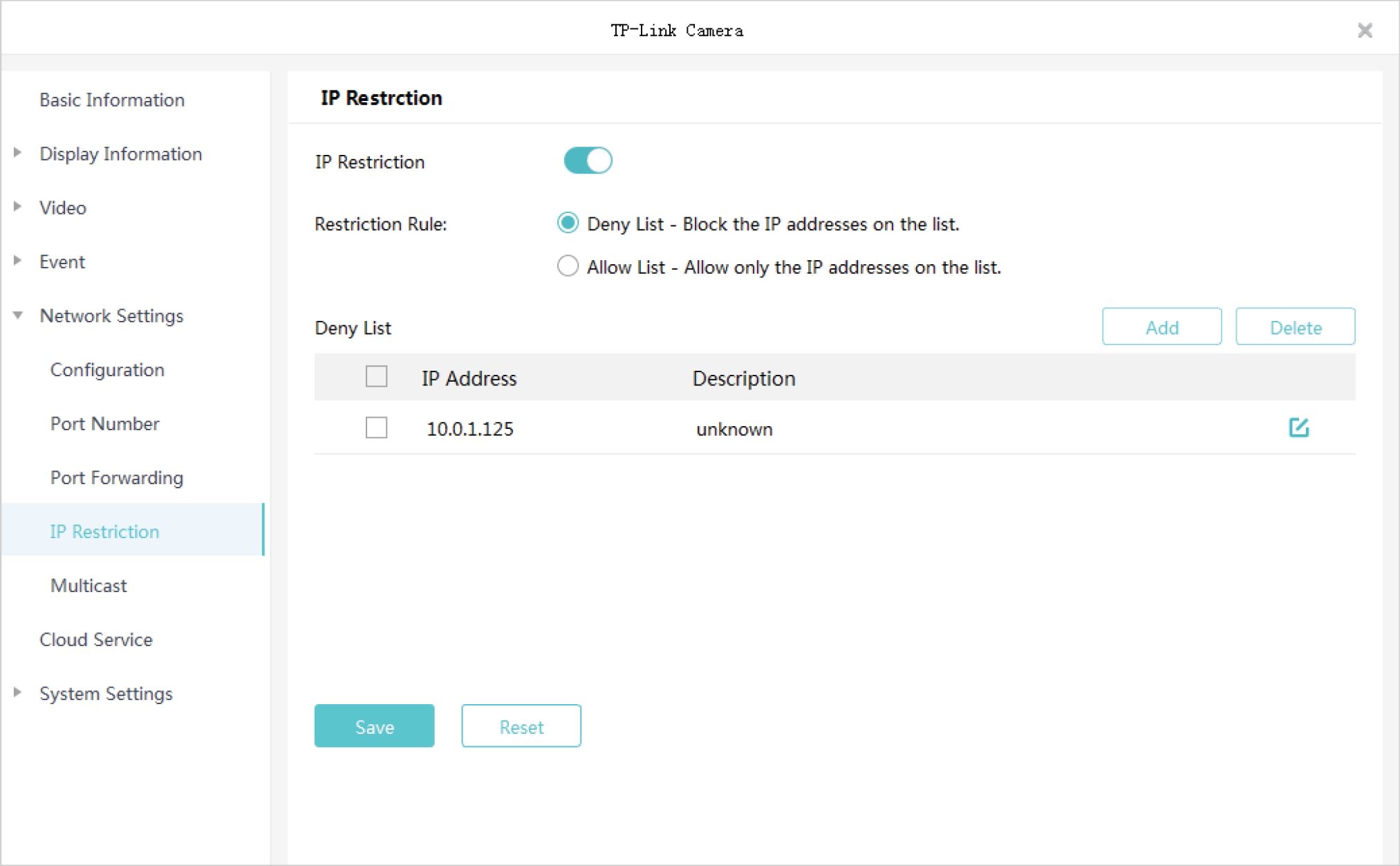
If you want to reset to default settings, click Reset.
7. 6. 5 Configure Multicast (Only for Cameras)
When Multicast is enabled, you can watch videos using the multicast address and port.
Follow the steps below to configure Multicast.
1. Go to Settings > Device List > My Devices and click in the list. Go to Network Settings > Multicast.
81
Chapter 7
Configure Your Cameras and NVRs
2. Select a stream and then enable Multicast. For the multicast address and port, you can disable Random IP Port and specify a static address and port, or enable it and use a random one. Click Save.
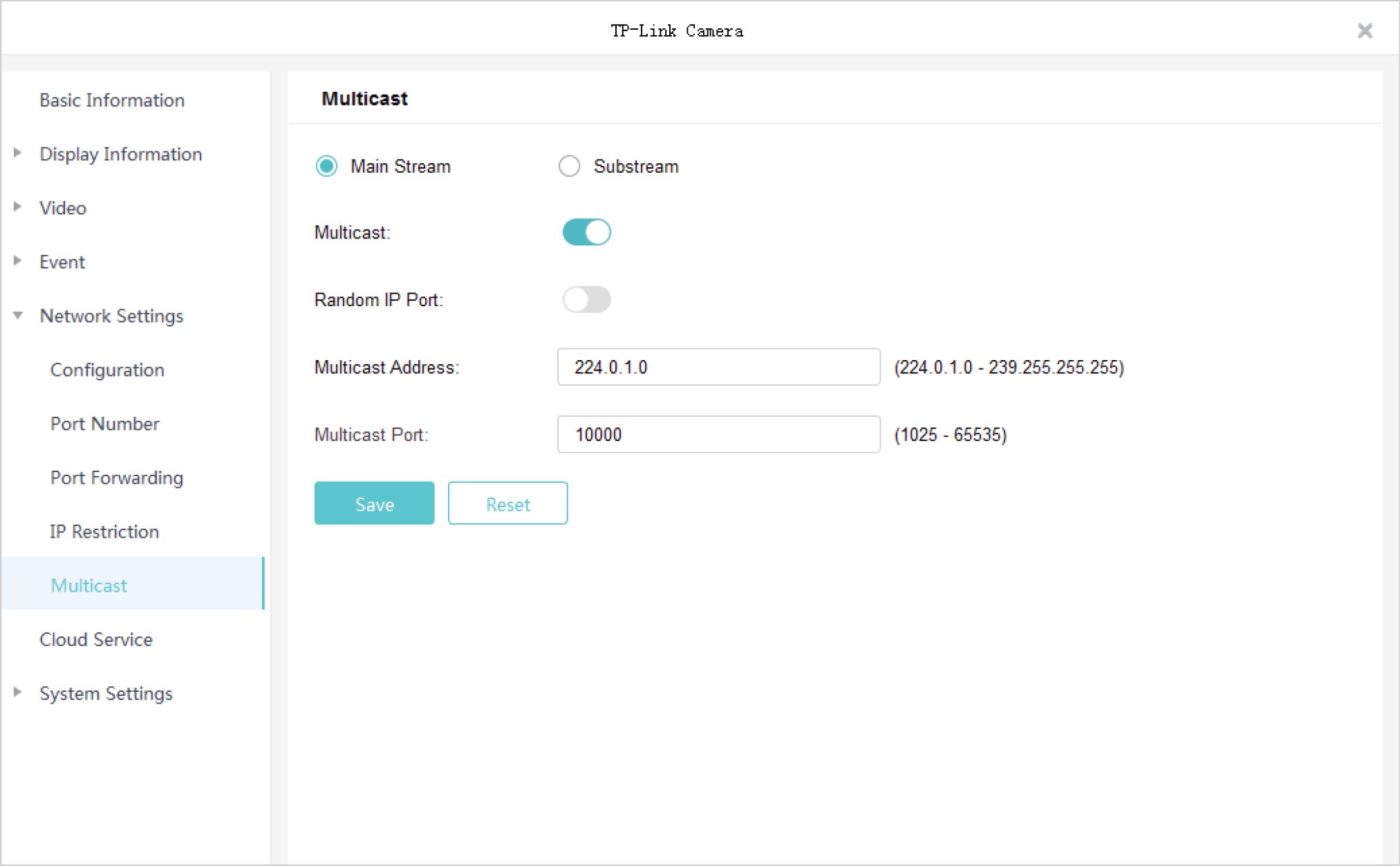
After Multicast enabled, you can watch the video with the URL rtsp://A:B:C:D/multicastStreamN, for example, rtsp://192.168.0.3/multicastStream1. A.B.C.D is the IP address of the camera, and N can be number 1 or 2 that indicates the stream, 1 for main stream and 2 for substream.
If you want to reset to default settings, click Reset.
VIGI Security Manager supports remote management with the support of TP-Link Cloud Services. With a TP-Link ID bound, you can remotely monitor your property through cameras on your computer.
If you want to bind or unbind your devices with your TP-Link ID, follow the steps below to finish the configuration.
82
Chapter 7
Configure Your Cameras and NVRs
1. Go to Settings > Device List > My Devices and click > in the list. Then go to Cloud Service and click Log in.
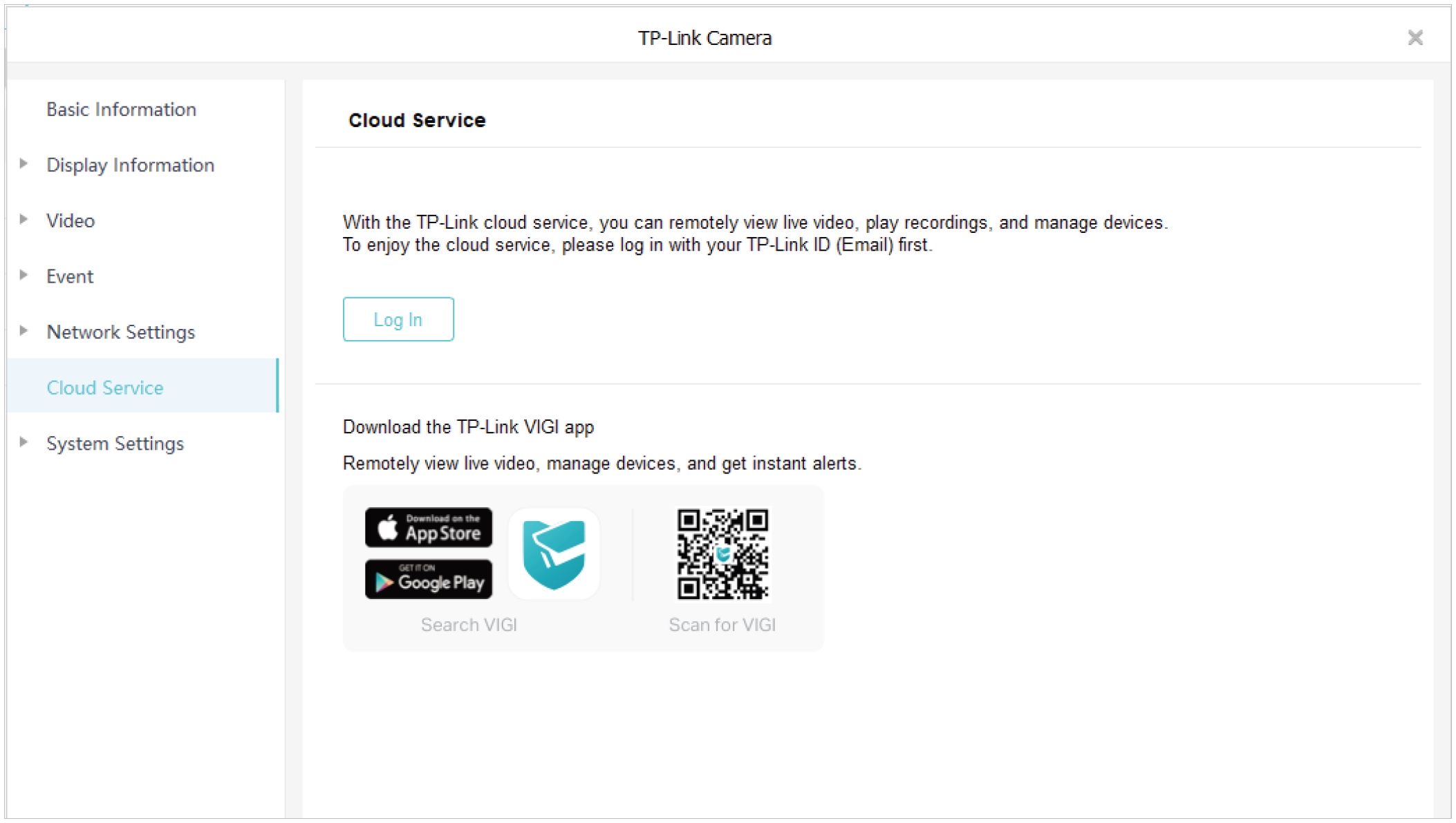
2. You can enable Auto Login to allow the utility to remember your account and log in automatically when switching it as the logged account. Click Log In.
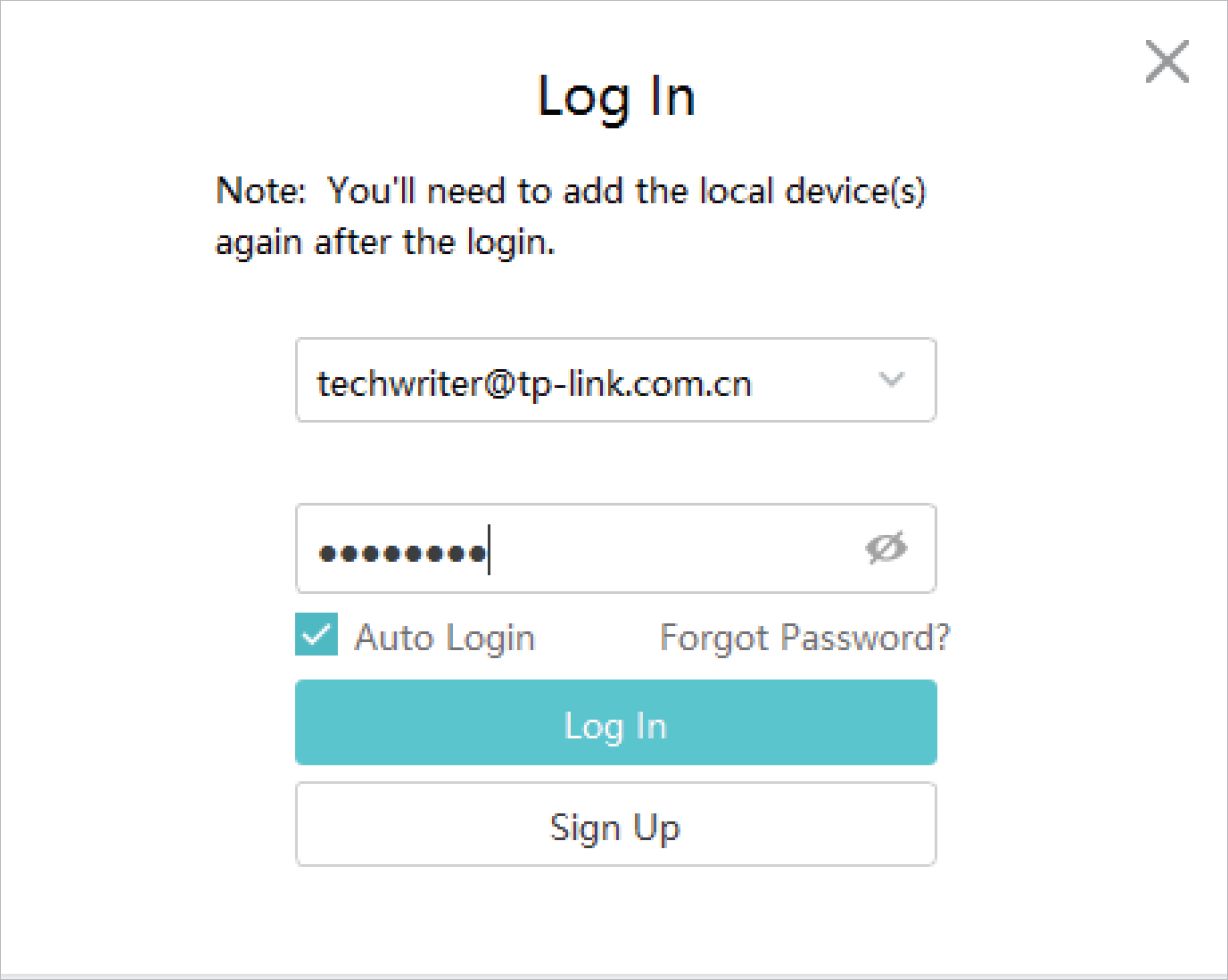
83
Chapter 7
Configure Your Cameras and NVRs
3.
Click Bind to bind all the devices added locally to your TP-Link ID. All the local devices will be bound automatically to your TP-Link ID.
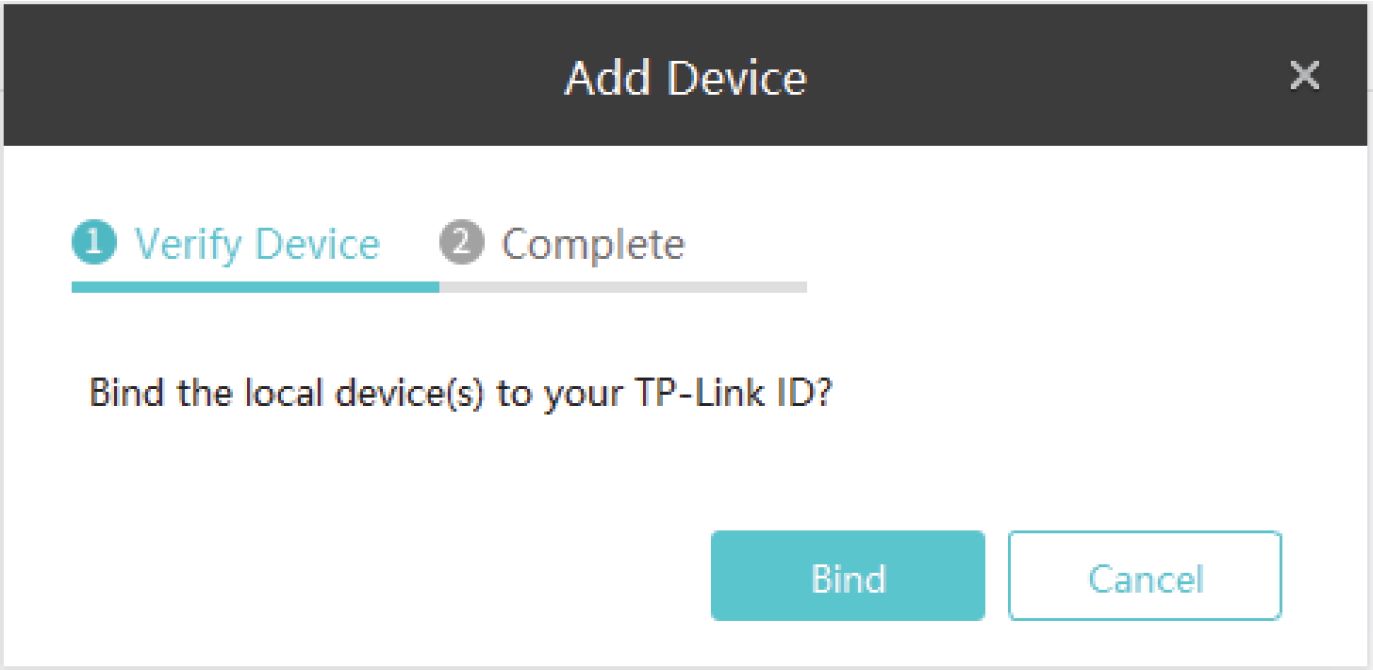
- (Optional) After finish binding the devices, click Unbind if you want to unbind a certain device from
your TP-Link ID.
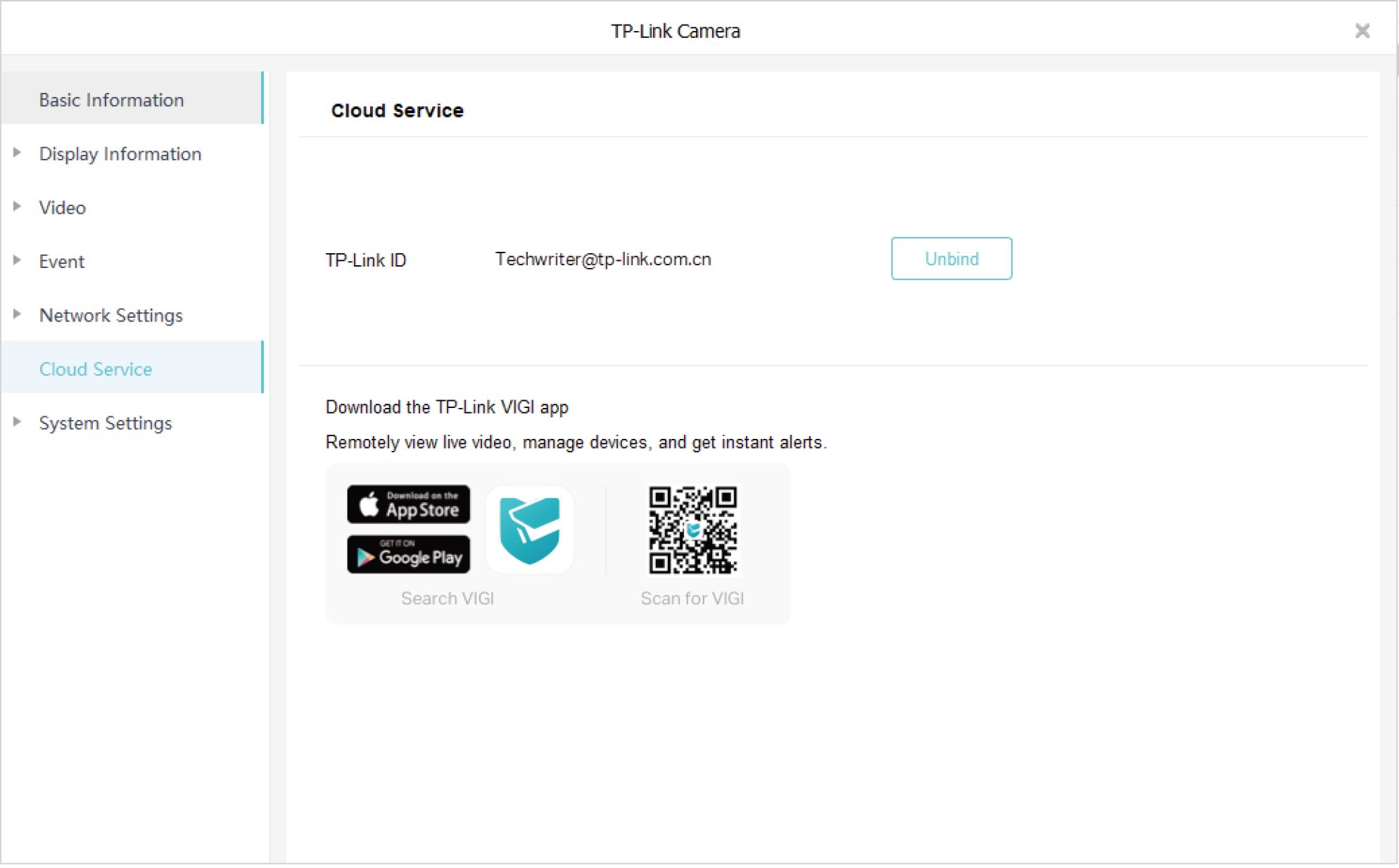
84
Chapter 7
Configure Your Cameras and NVRs
V 7. 8 Configure System Settings
The system settings allow you to modify the name and password, set the time and reboot schedule for your devices. To configure system settings, go to Settings > Device List and click O in the list.
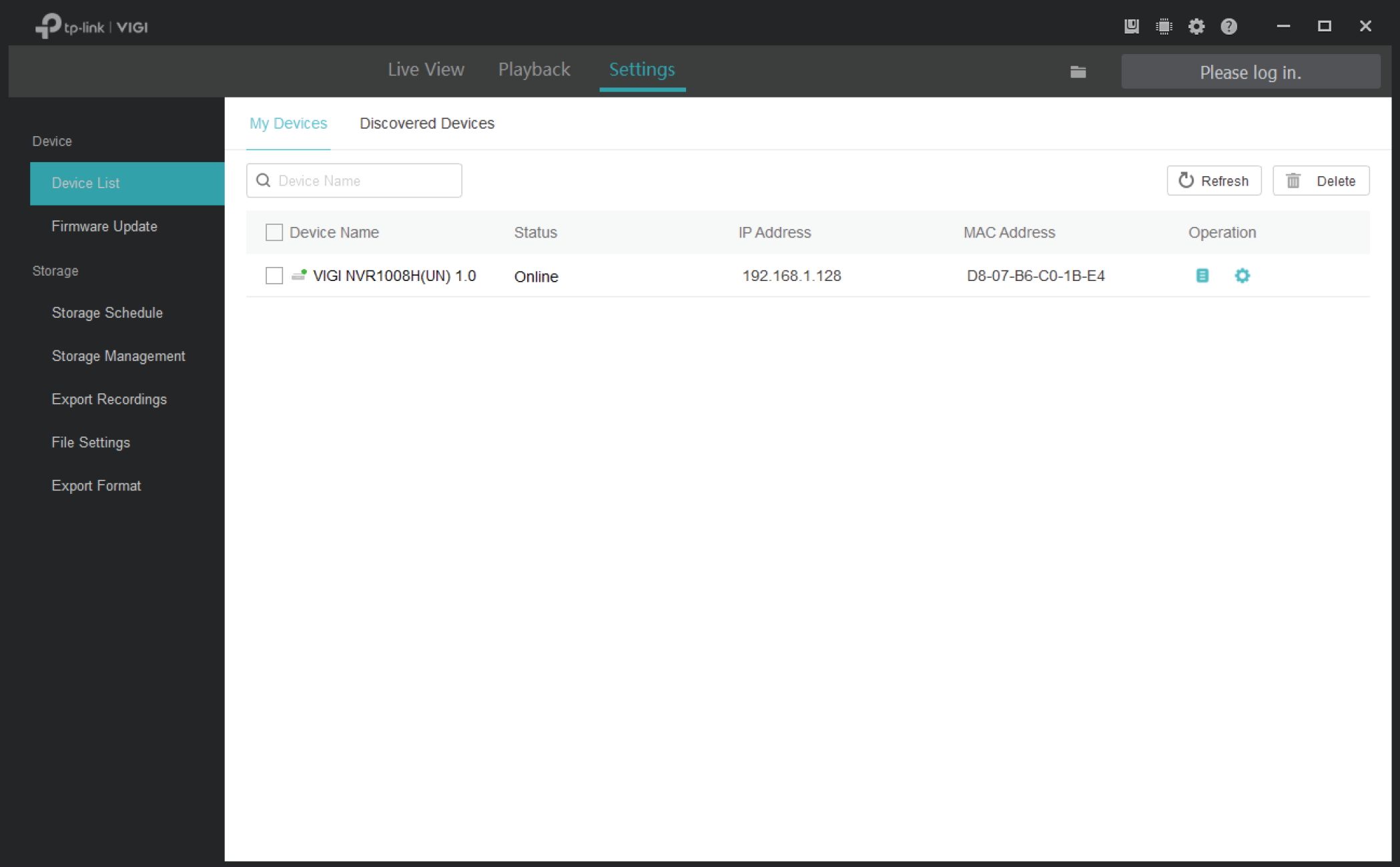
85
Chapter 7
Configure Your Cameras and NVRs
7. 8. 1 Configure Basic Settings
To modify the device name, channel name (only for NVR) and passwords of devices, go to Settings > Device List and click O in the list. Then go to System Settings > Basic Settings.
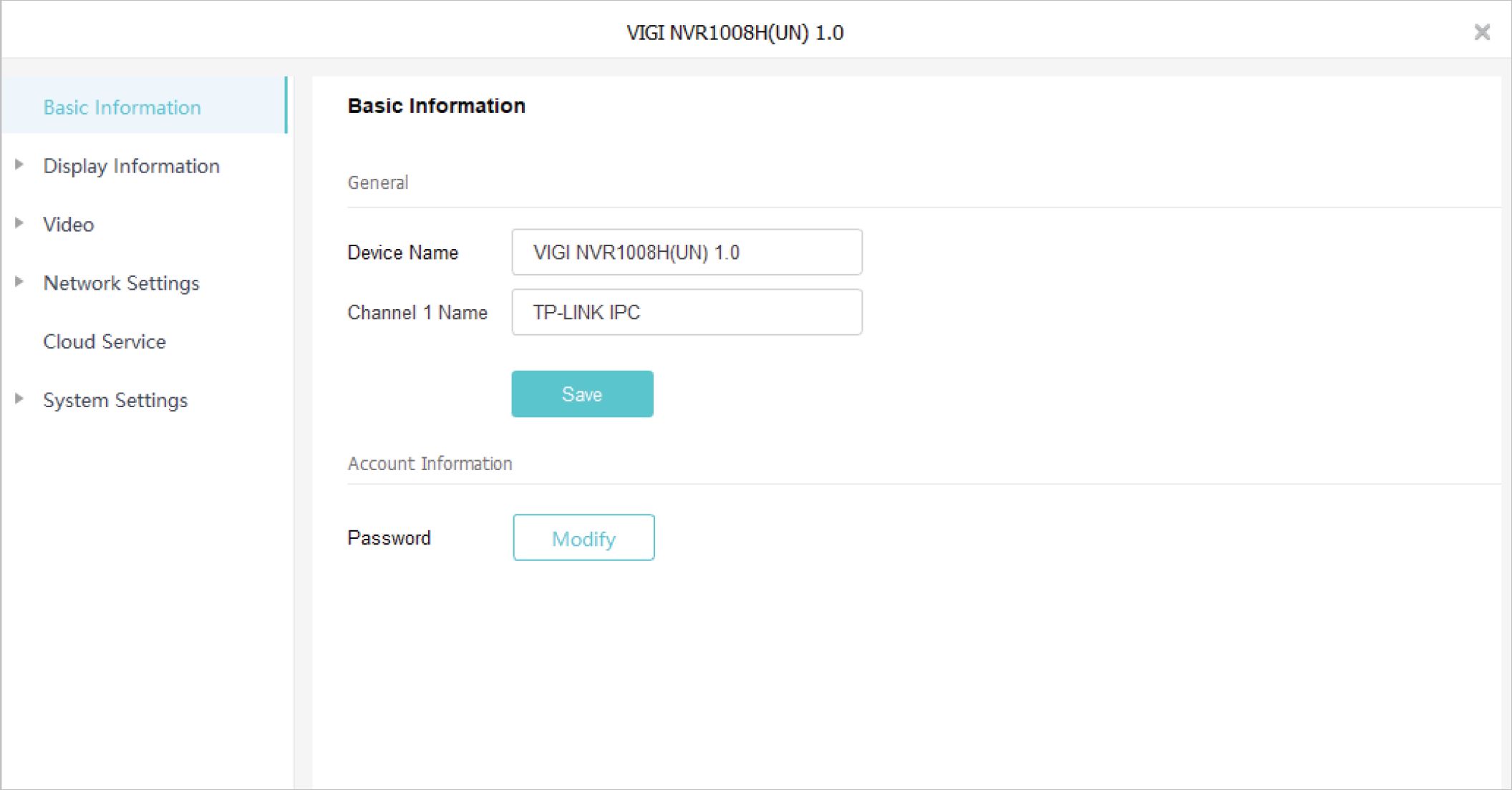
You can click Modify to change the password and email address for password reset.
Note: You can only modify the password of local devices.
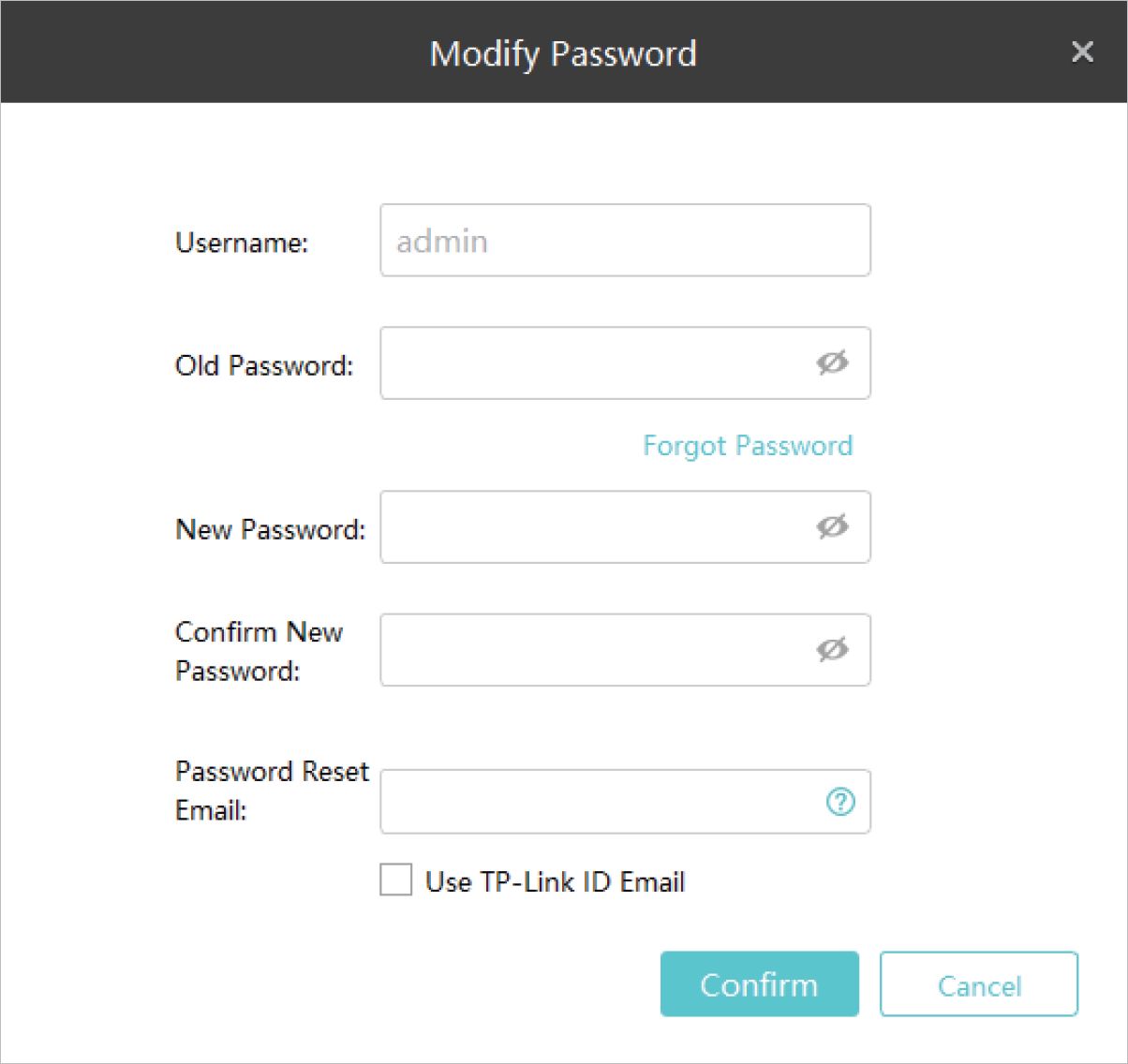
86
Chapter 7
Configure Your Cameras and NVRs
7. 8. 2 Configure Time Settings
VIGI Security Manager provides two methods to modify the system time. To configure time settings, go to Settings > Device List and click O in the list. Go to System Settings > Time Settings.
■ Get Time from the Internet
VIGI devices can use NTP (Network Time Protocol) to automatically get the system time from the Internet. You can also customize the NTP Server Address if you don’t want to get the time from the default NTP server address provided by NVR. Then select the time zone according to your region.
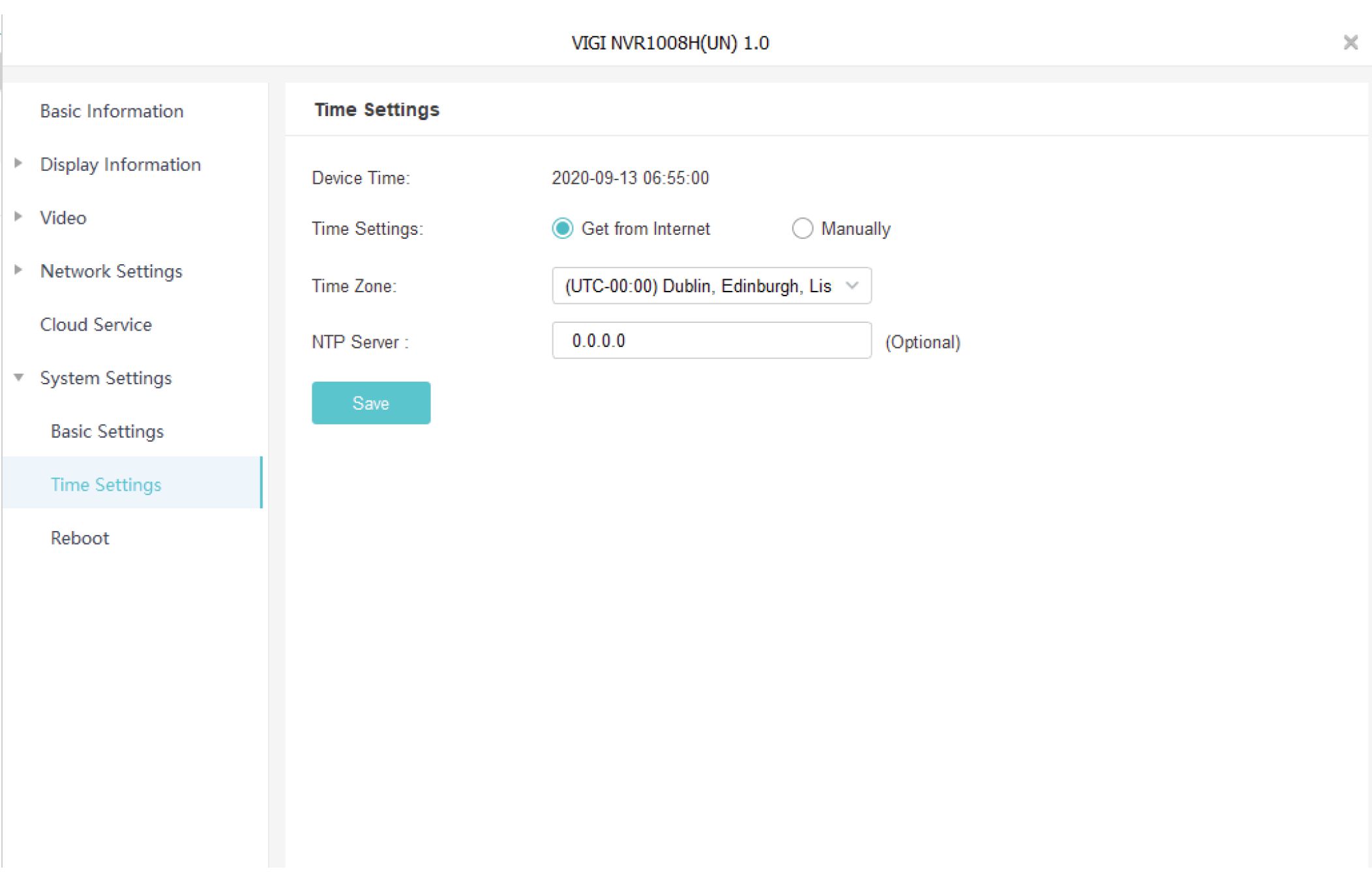
87
Chapter 7
Configure Your Cameras and NVRs
■ Set Manually
You can set the device time manually or click Get From PC to synchronize the device time with that of your PC.
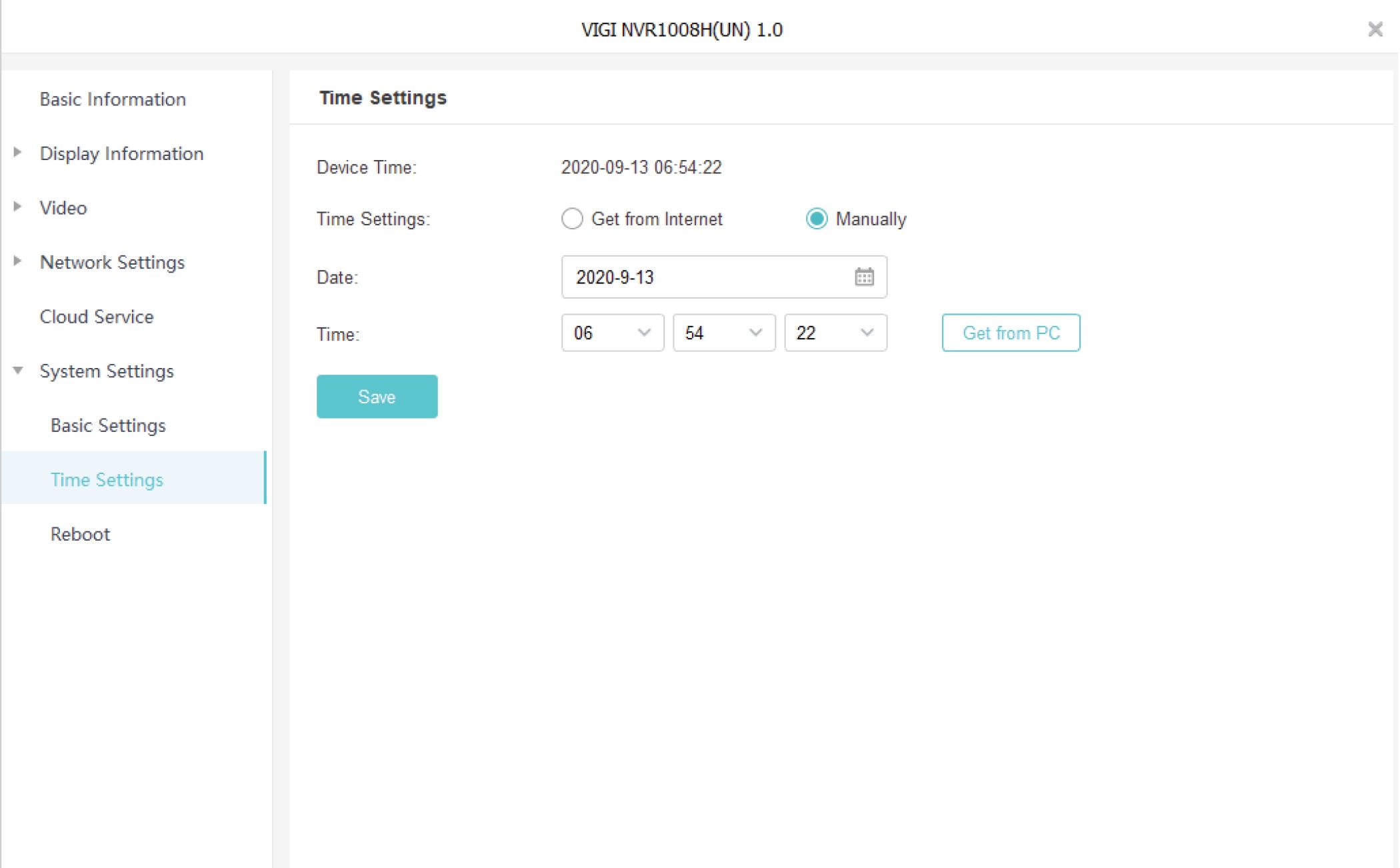
To reboot your devices instantly or set the reboot schedule, go to Settings > Device List and click O in the list. Go to System Settings > Reboot.
88
Chapter 7
Configure Your Cameras and NVRs
If you want to reboot your device based on a schedule, enable Scheduled Reboot and customize the schedule according to your needs.
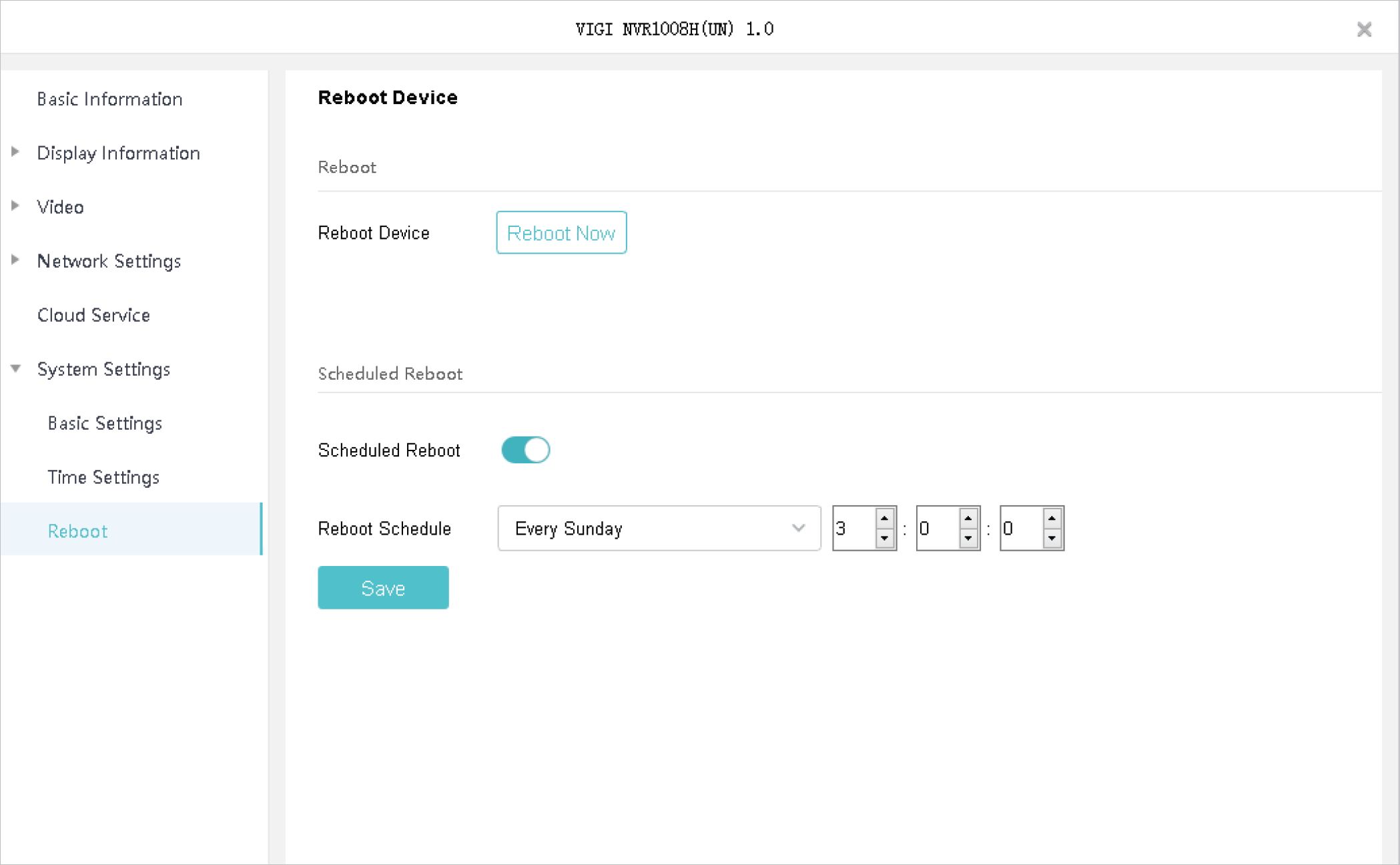
89
Chapter 7
Configure Your Cameras and NVRs
VIGI Security Manager allows you to upgrade the firmware of your device automatically or manually. To upgrade a device solely or upgrade them in batches, go to Settings > Device > Firmware Update.
/5tp-link I VIGI
a ©
□ X
Live View Playback Settings
IEI
Please log in.
Device
| Ö Refresh
Device List
Firmware Update

□ No. Device Name
VIGI NVR1008H(UN) 1.0
± Update Manually T Auto Update
Firmware Update
Hardware Version
Firmware Version
Status Operation
Storage
VIGI NVR1008H(UN) 1.0
1.0.1 Build 200722 Rel.70379n Online
Auto Update
Update Manually
Storage Schedule
Storage Management
Export Recordings
File Settings
Export Format
| Auto Update | Select a device and click Auto Update to automatically upgrade your device. |
Update Manually
Select a device and click Update Manually. Then import the update file and click Update
T Update Manually
Click the checkboxes before devices and click ± update Manually to automatically upgrade your devices.
T Auto Update
Click the checkboxes before devices and click t Auto update. Then import the update file and click Update.
□
90
Chapter 7
Configure Your Cameras and NVRs
To remove the devices from your VIGI Security Manager, follow the steps below.
1. Go to Settings > Device List.
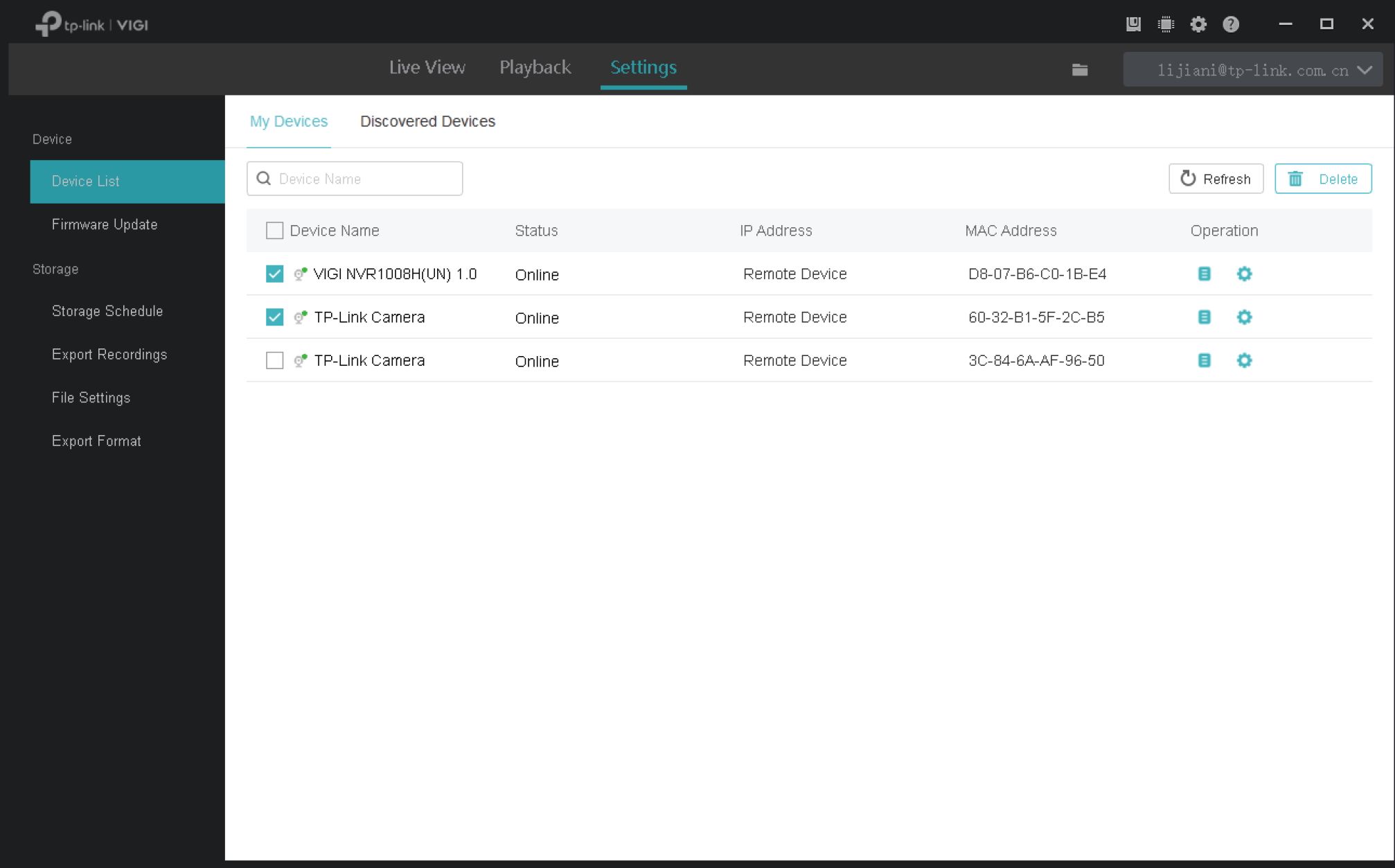
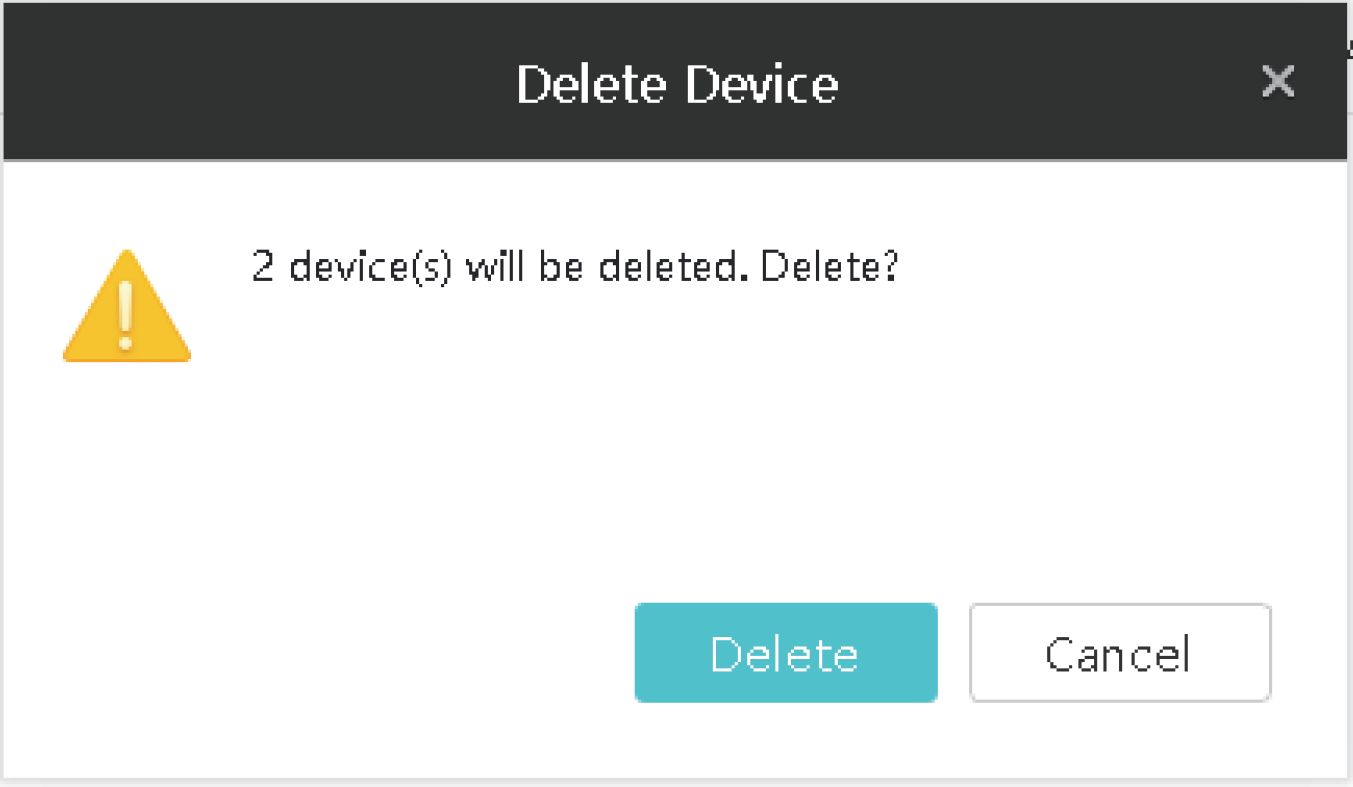
91
This chapter guides you on how to view and manage the system of VIGI Security Manager. You can check the storage and CPU usage, configure system settings and update the software.
Chapter 8
System Management
You can check the storage and CPU usage, configure system settings and update the software on the top right corner.


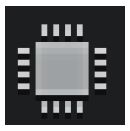


Hover the cursor above the icon to check the storage usage.
Hover the cursor above the icon to check the CPU usage.
Click the check box to configure the following system settings.
Run at Windows Startup: Makes the software run automatically when your computer starts up.
Enable Hardware Decoding: Allows your GPU (Graphics Processing Unit) to process certain video data, which will take load off the CPU and make the application run smoother.
When Closed: Choose to exit or minimize to tray when clicking
X
Click to check the software version and update VIGI Security Manager.
93
